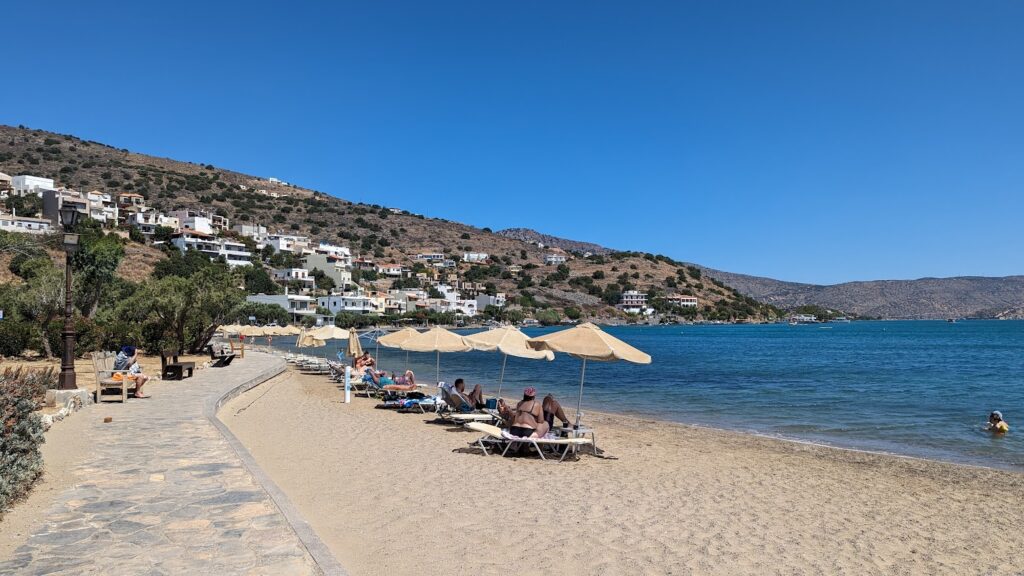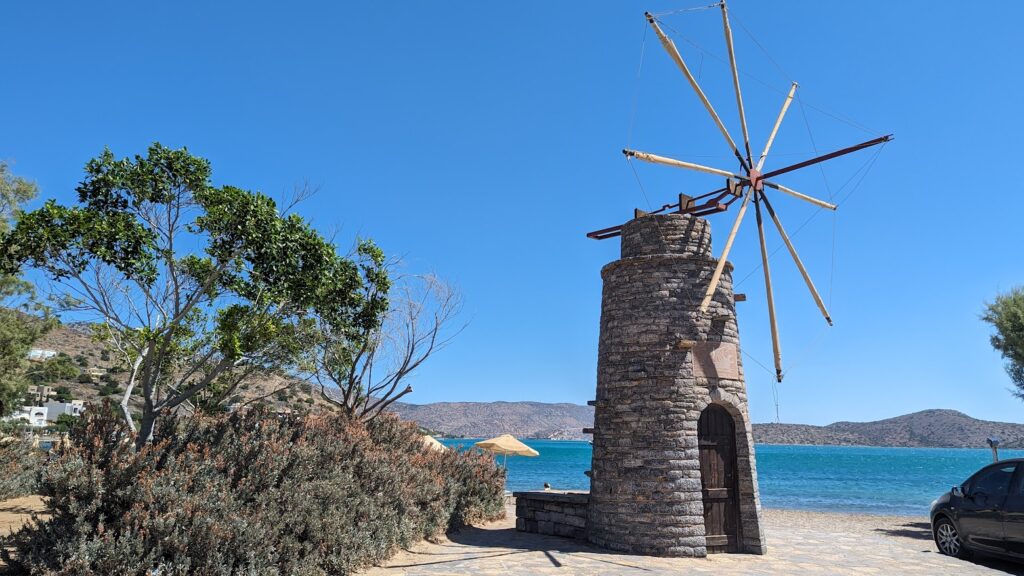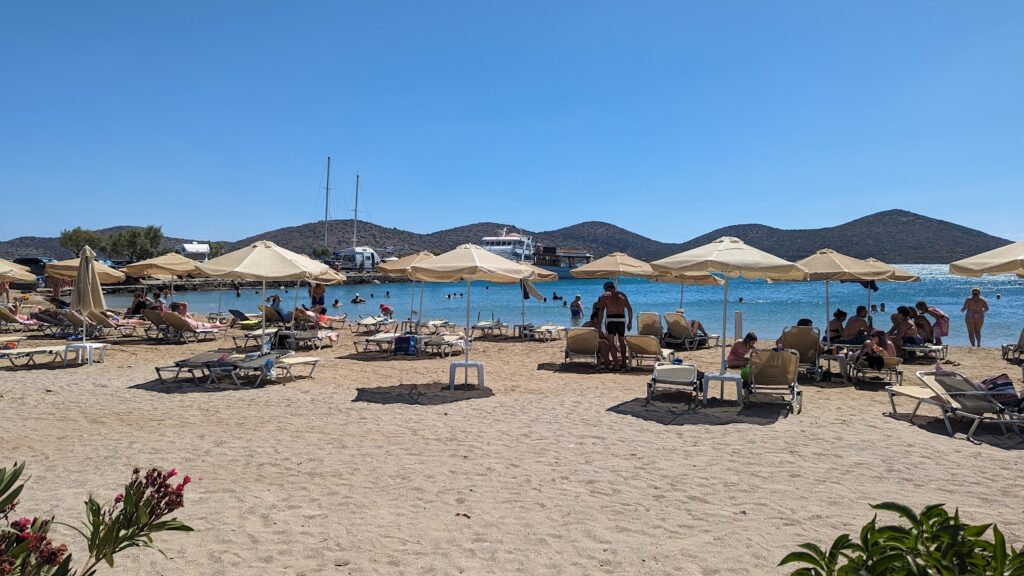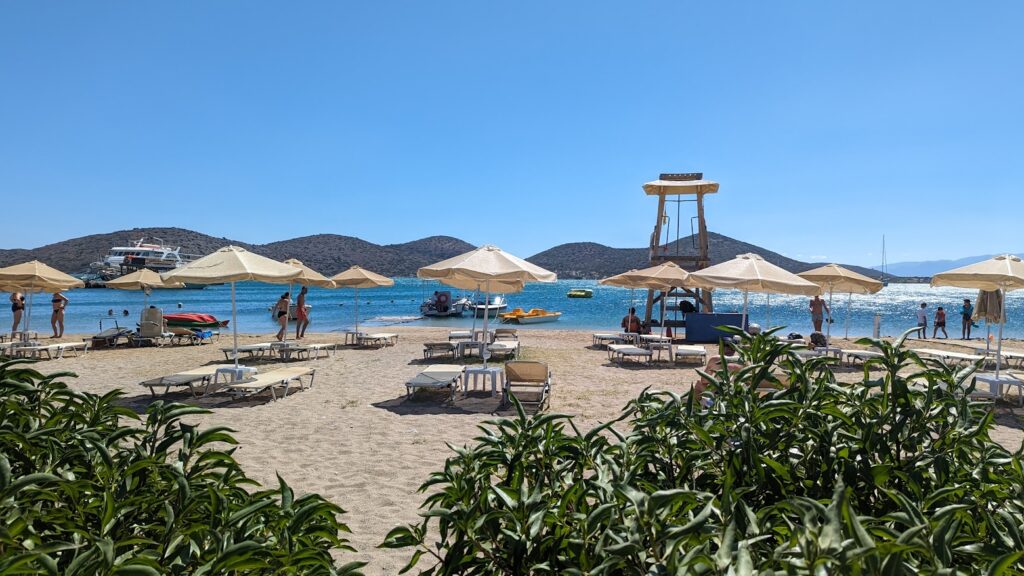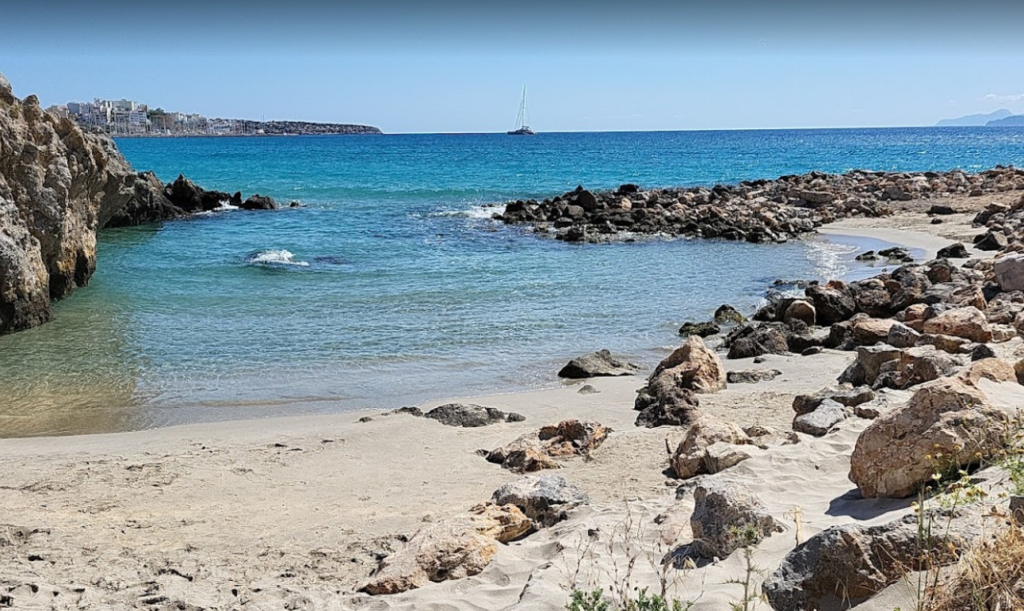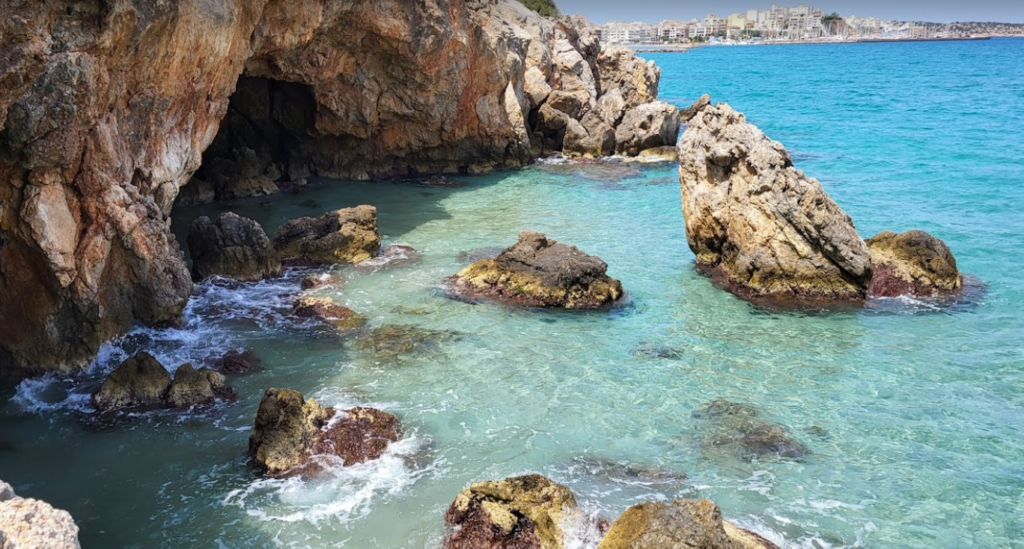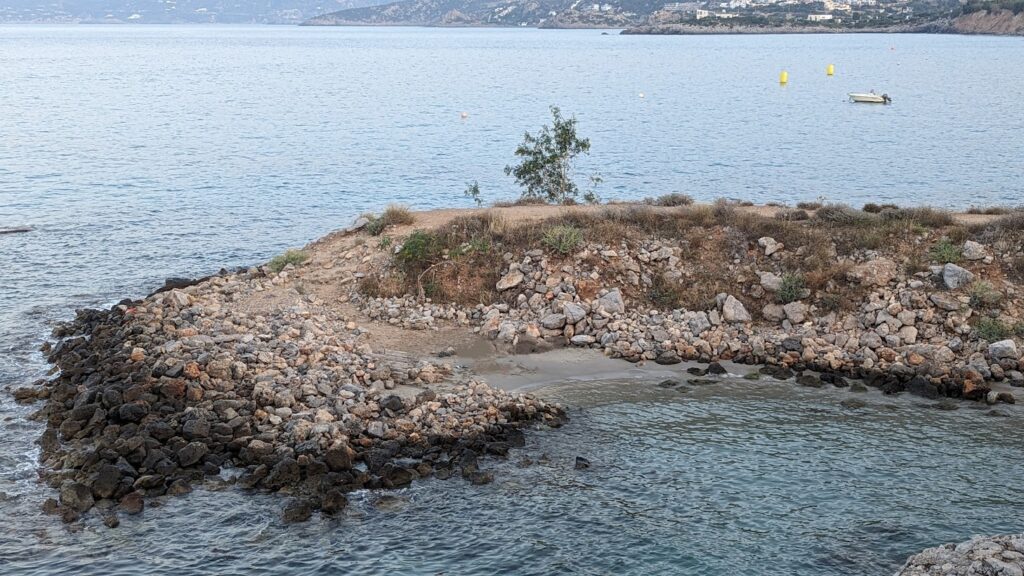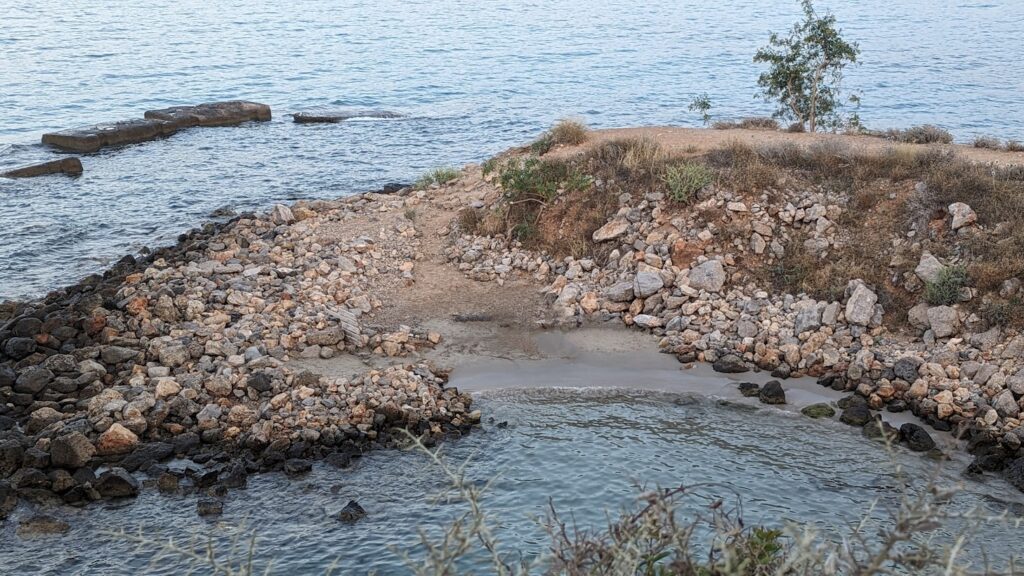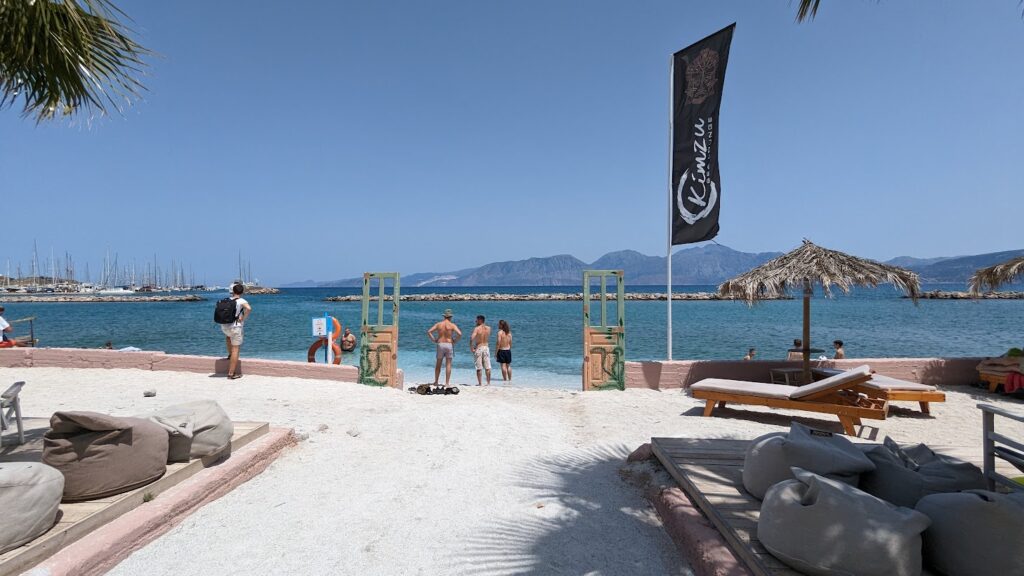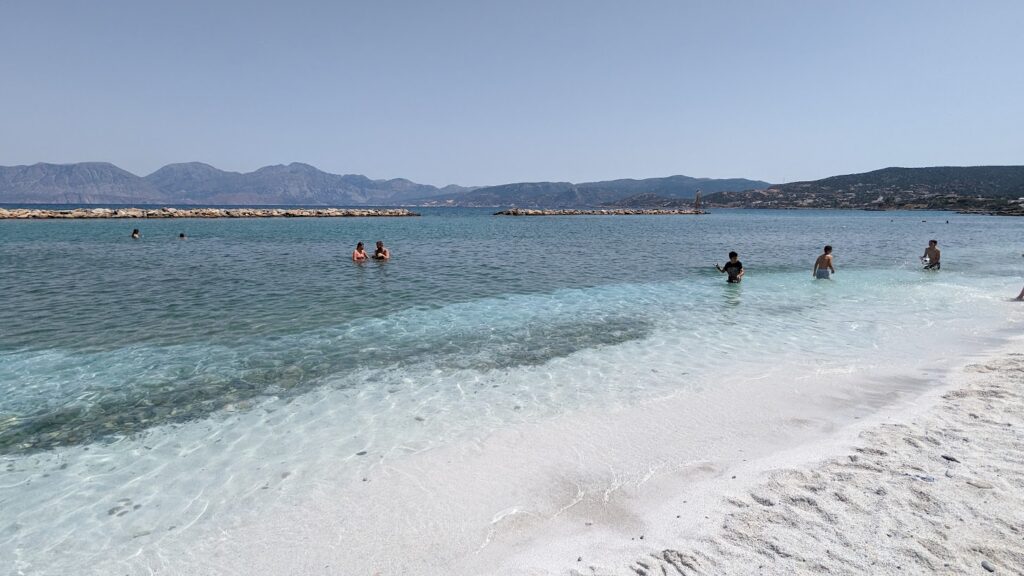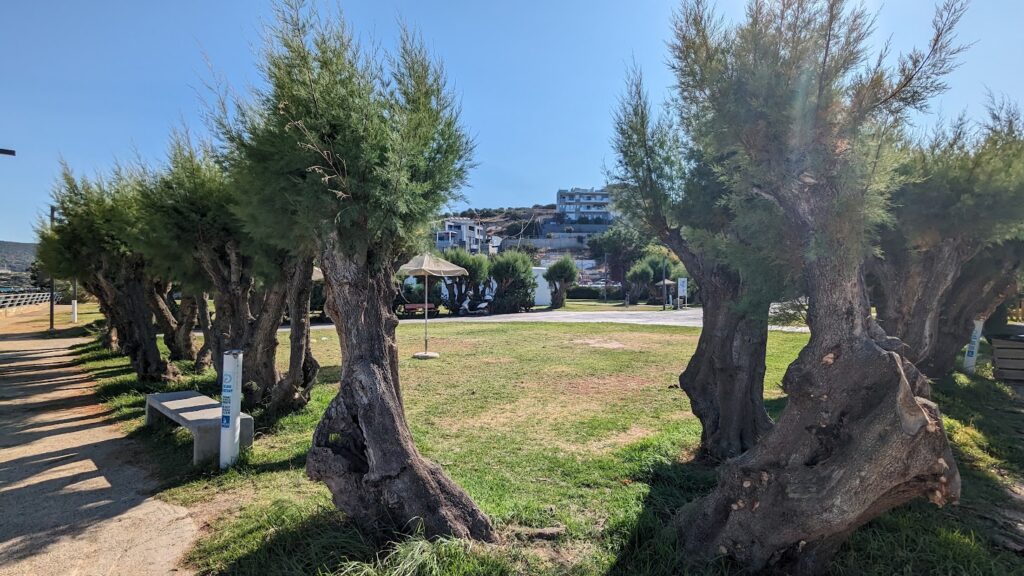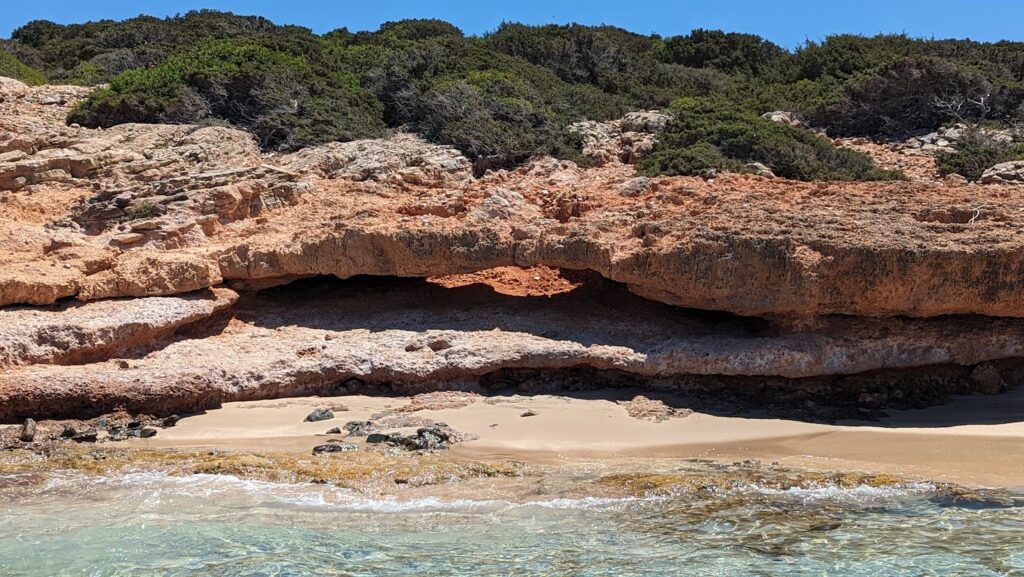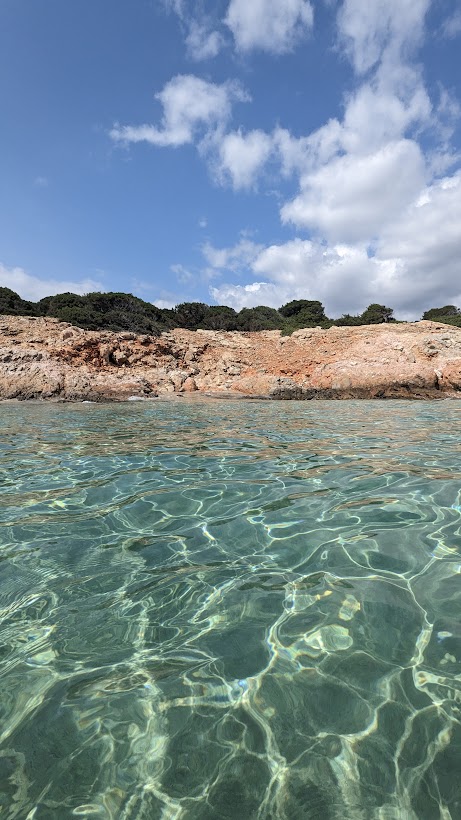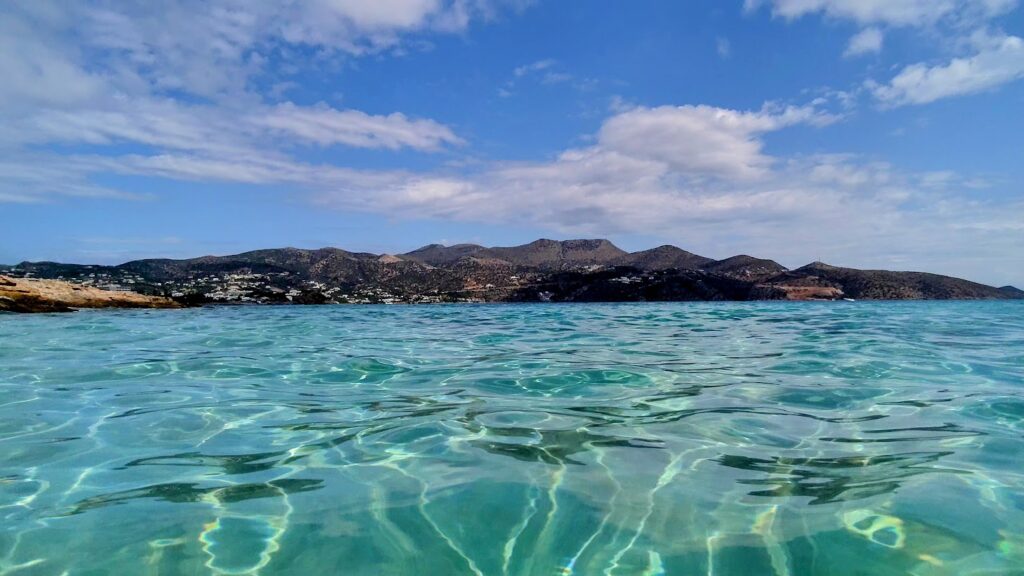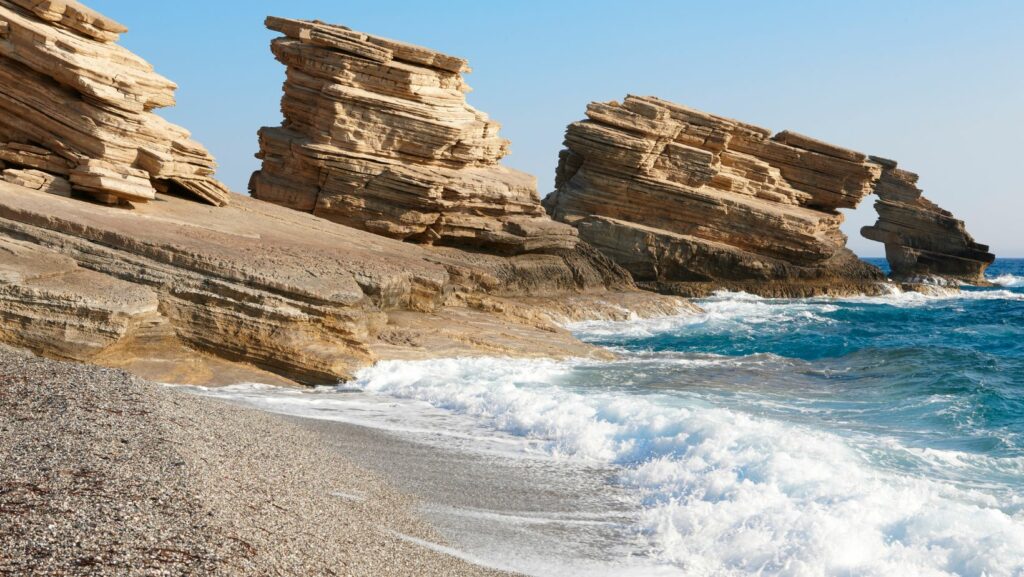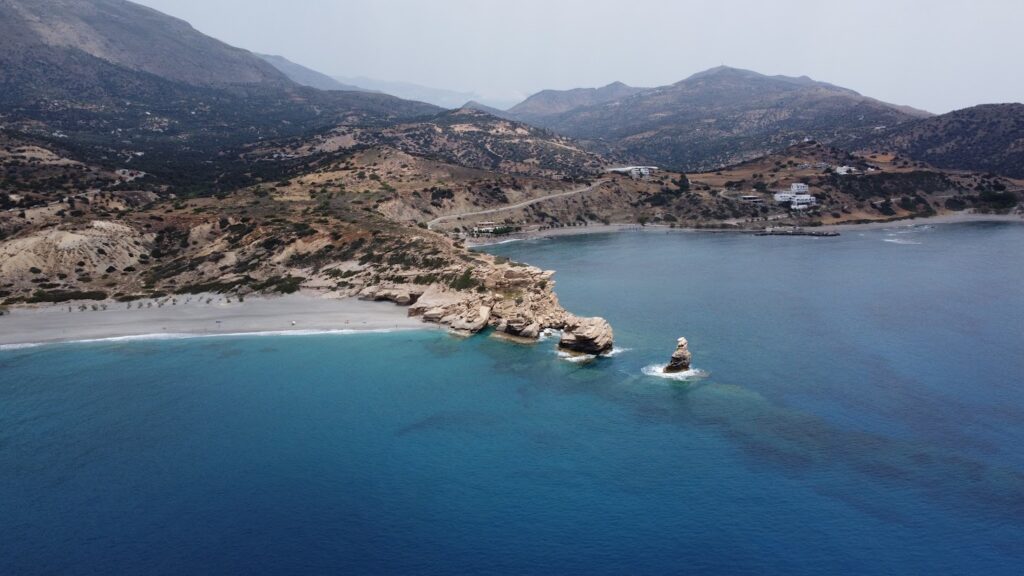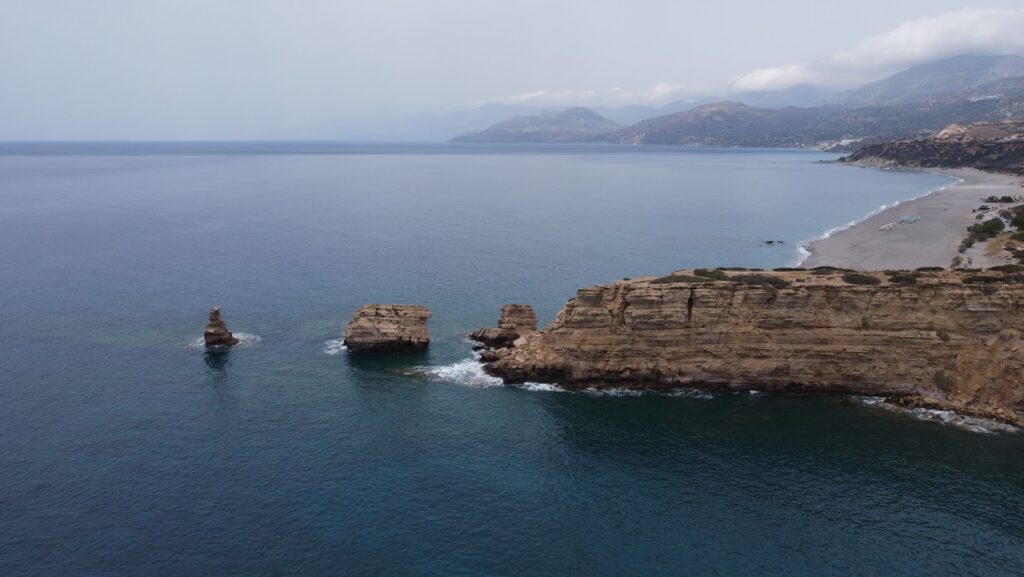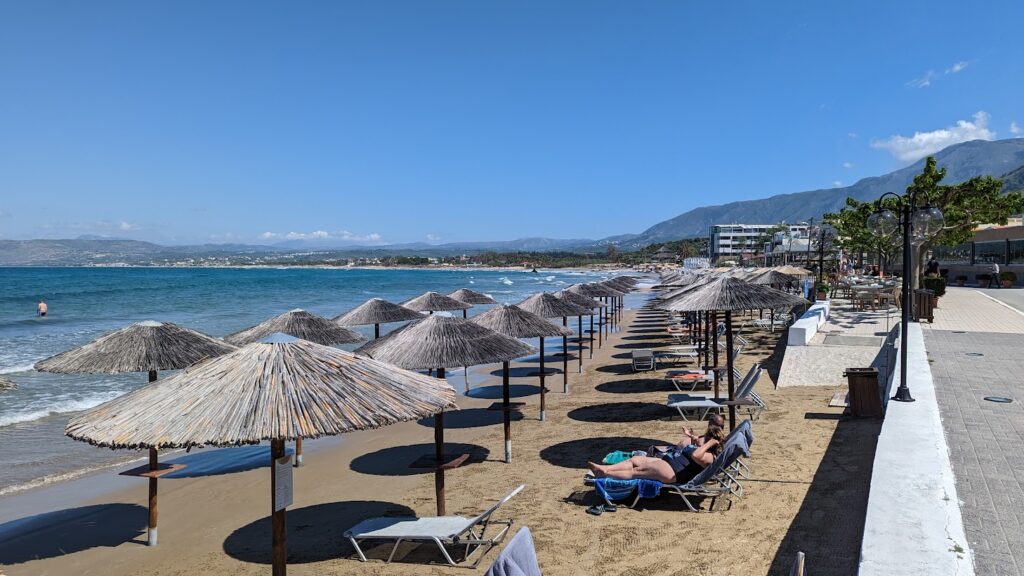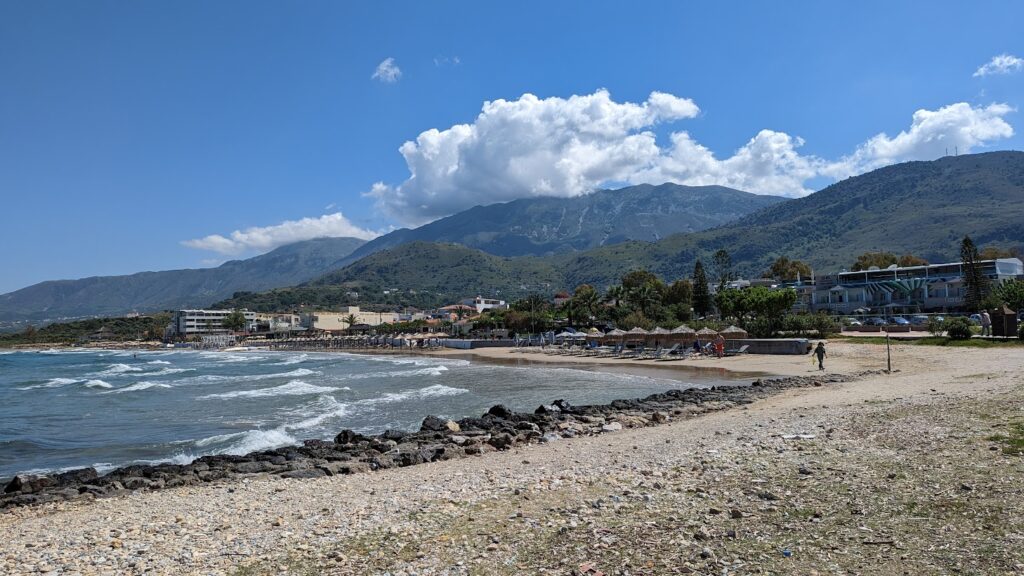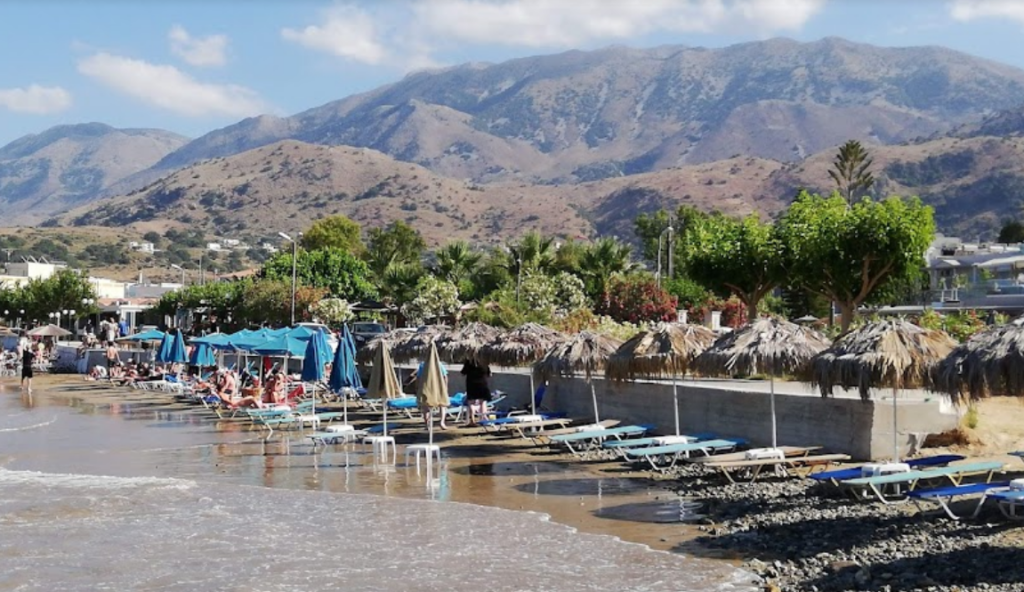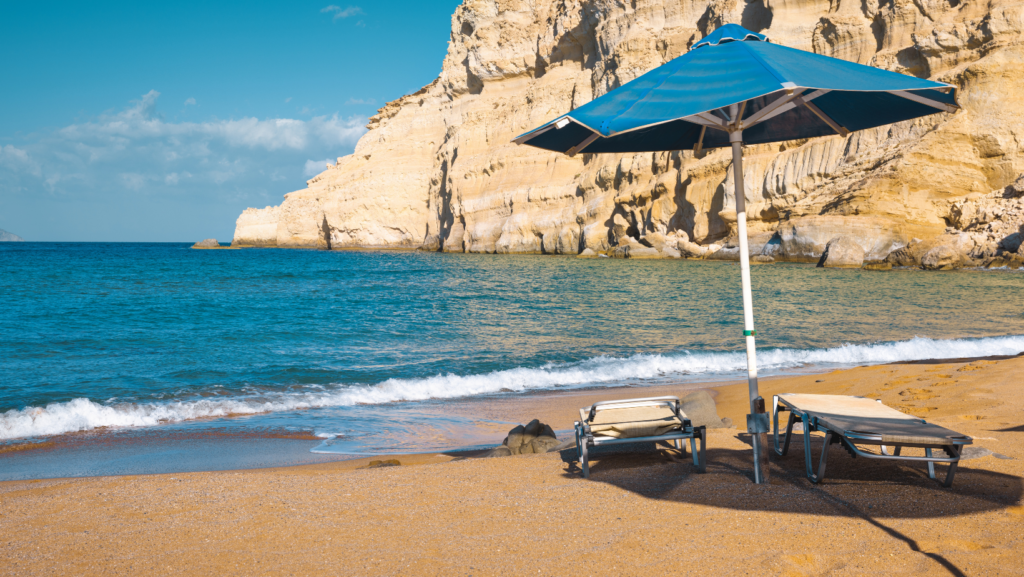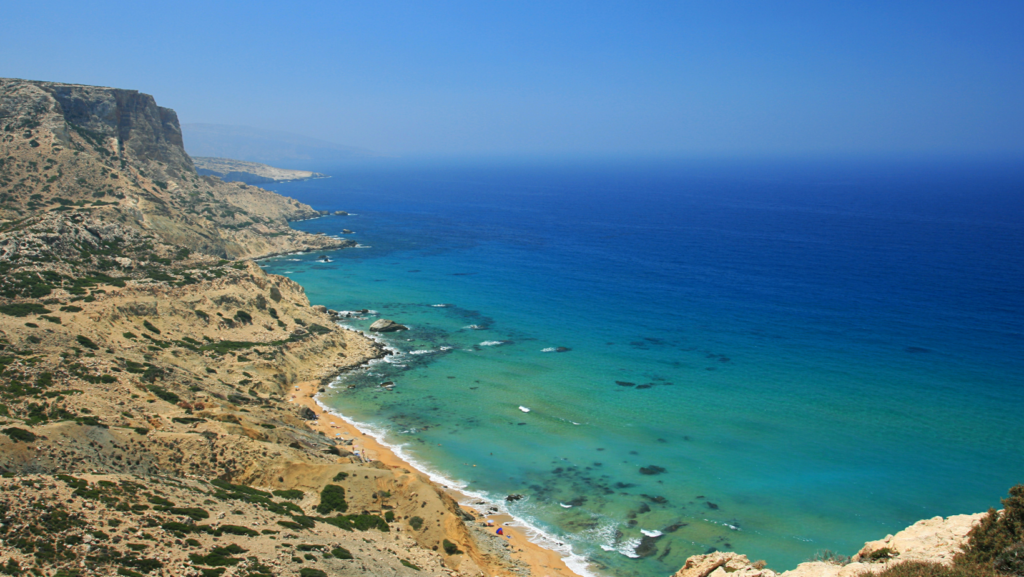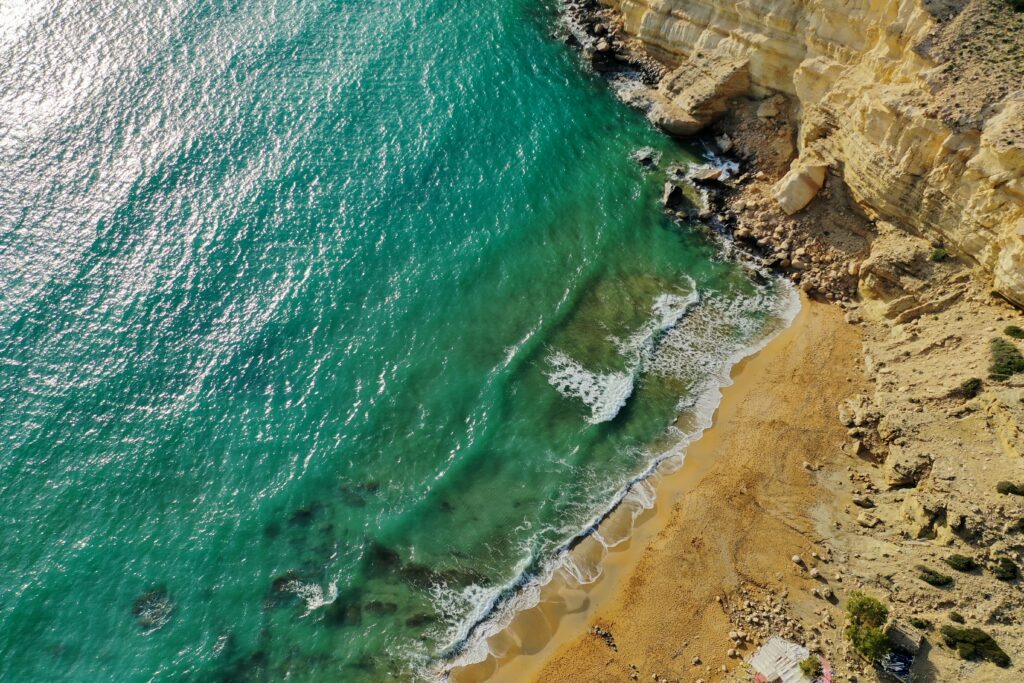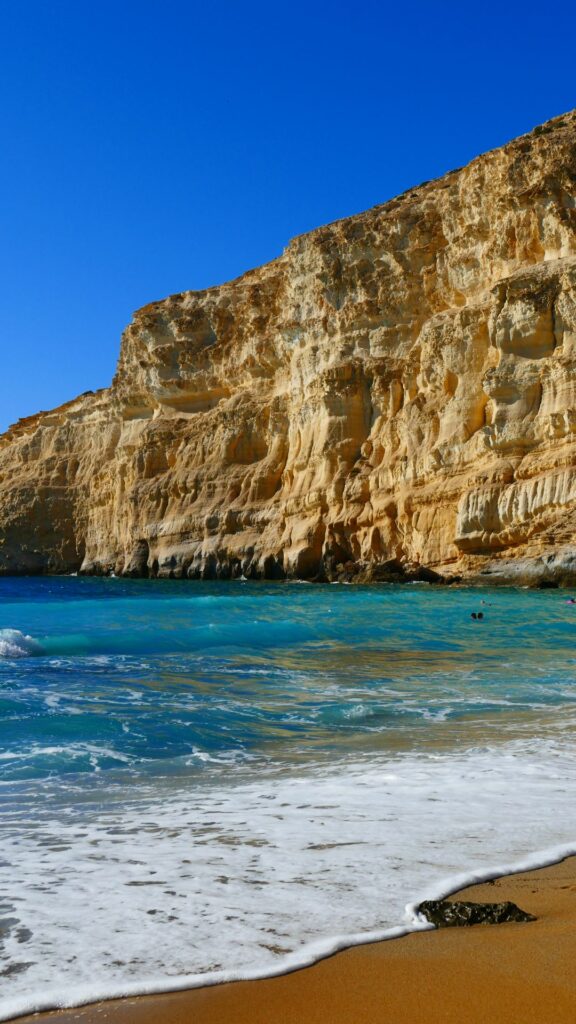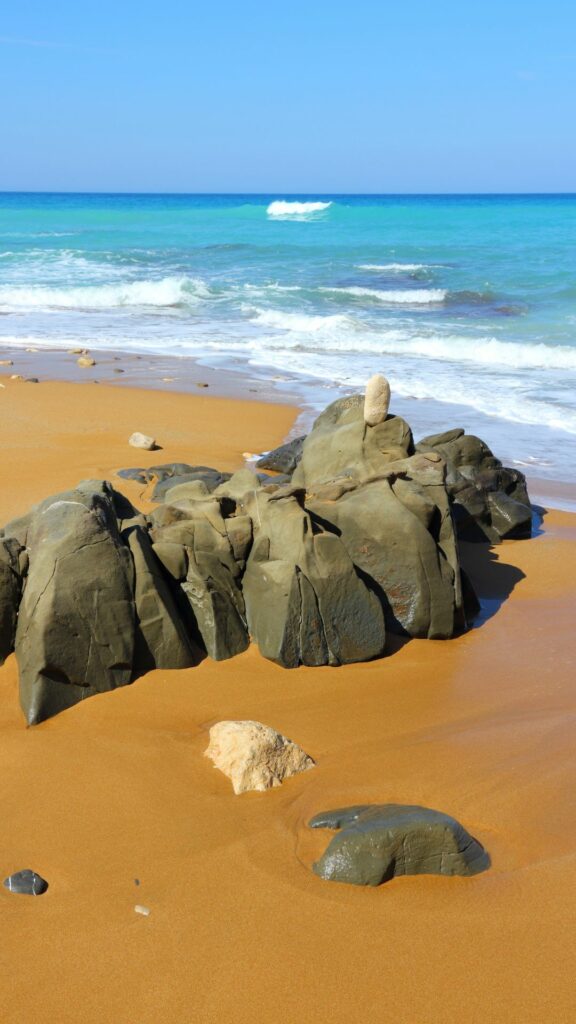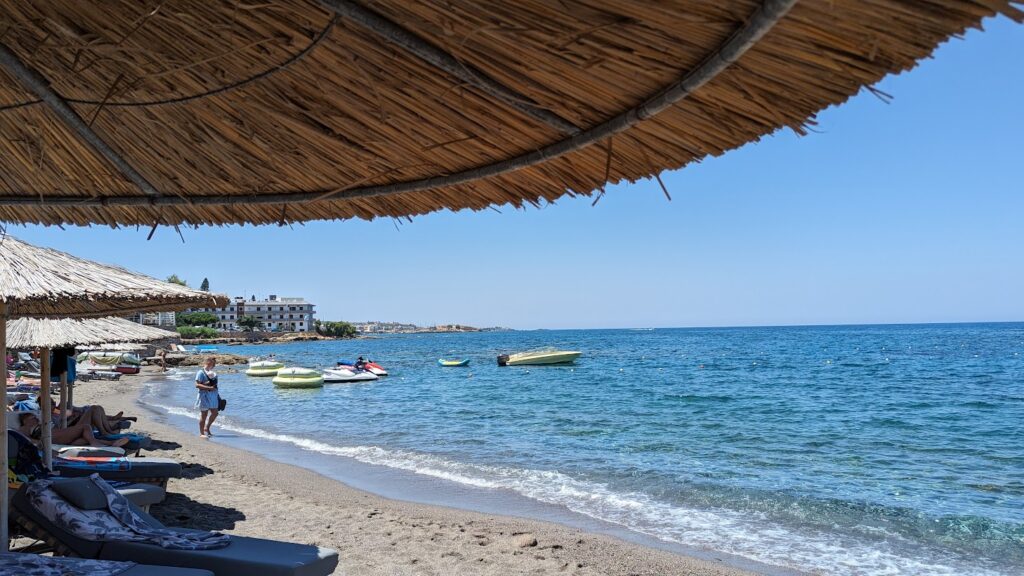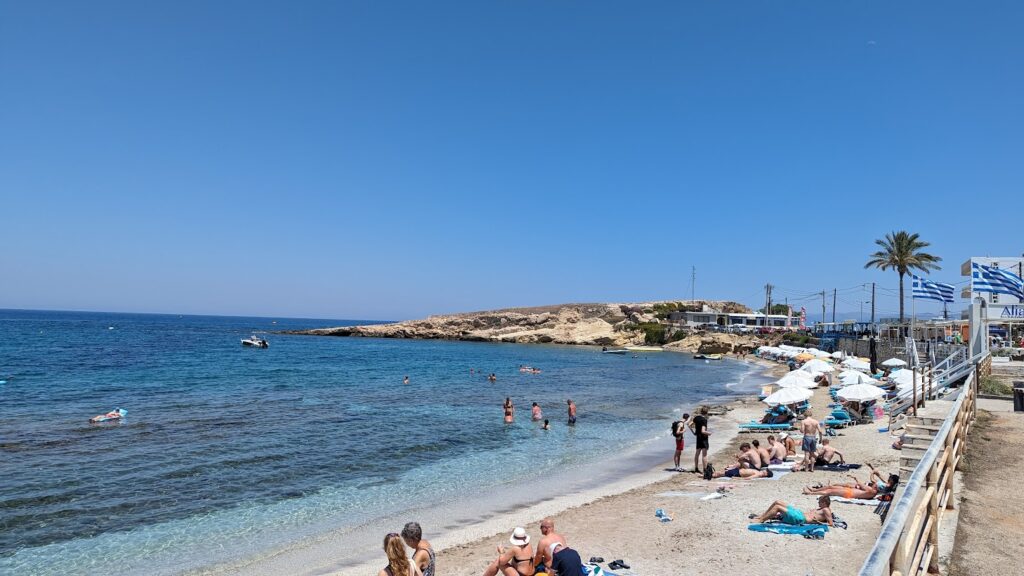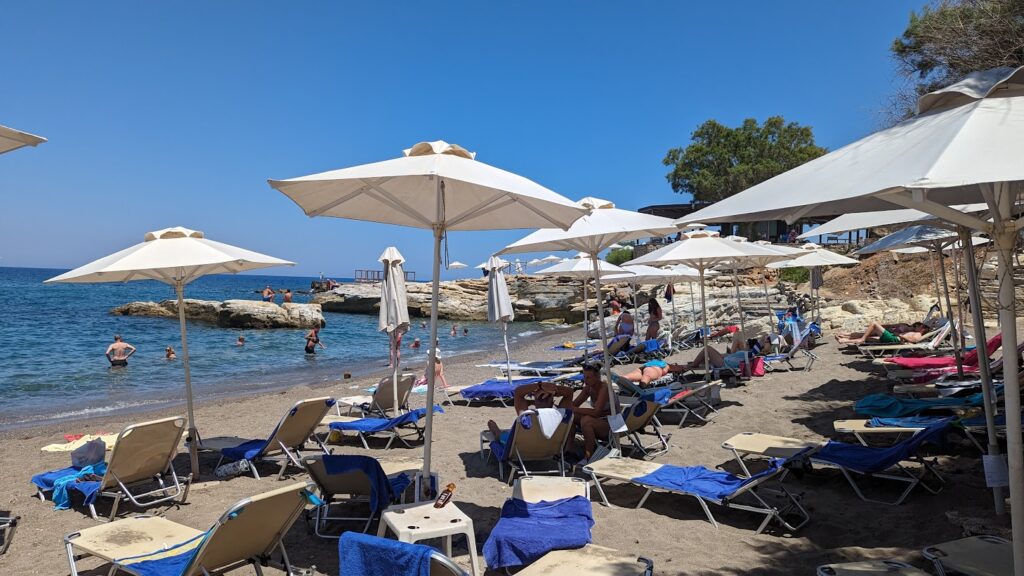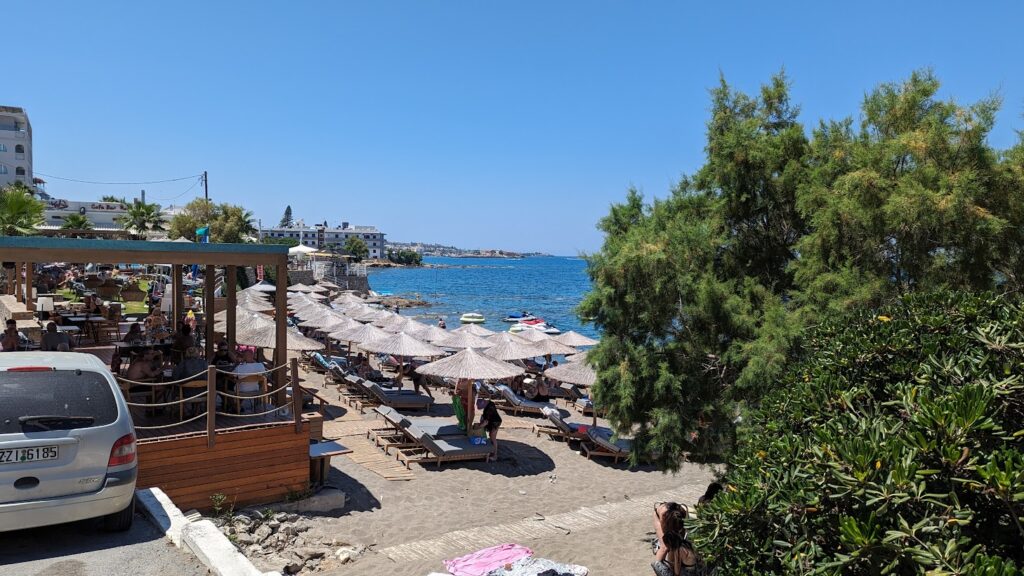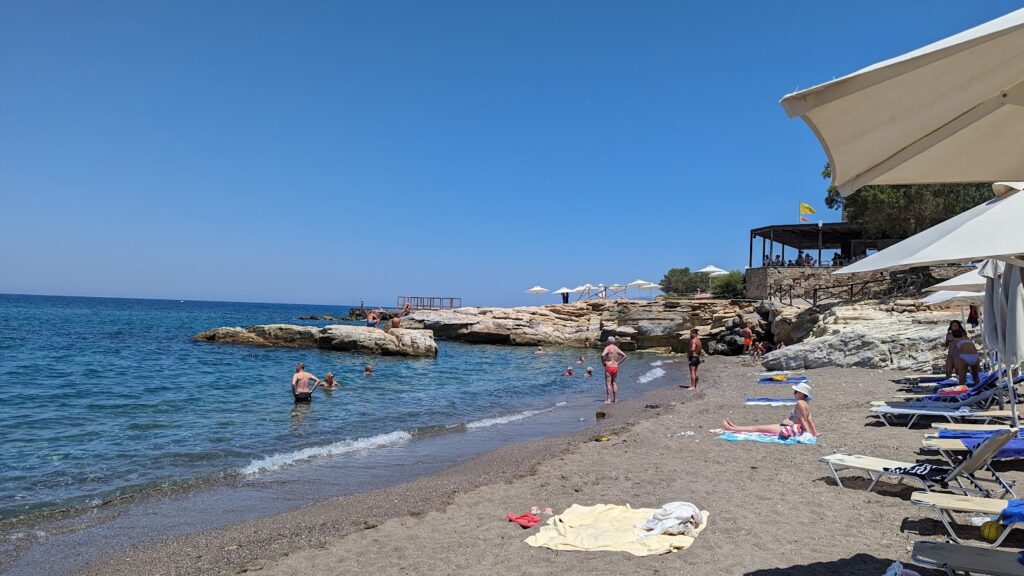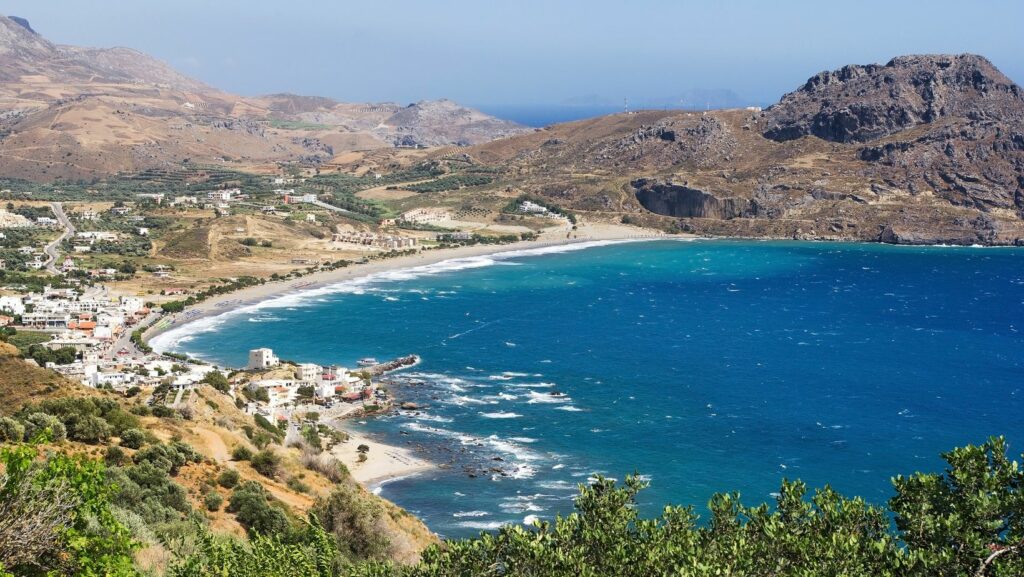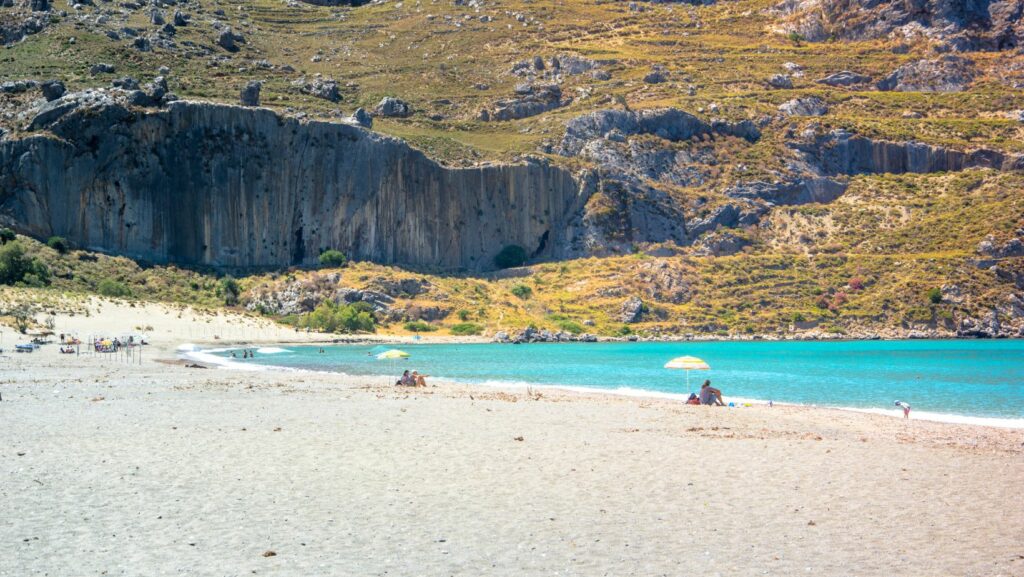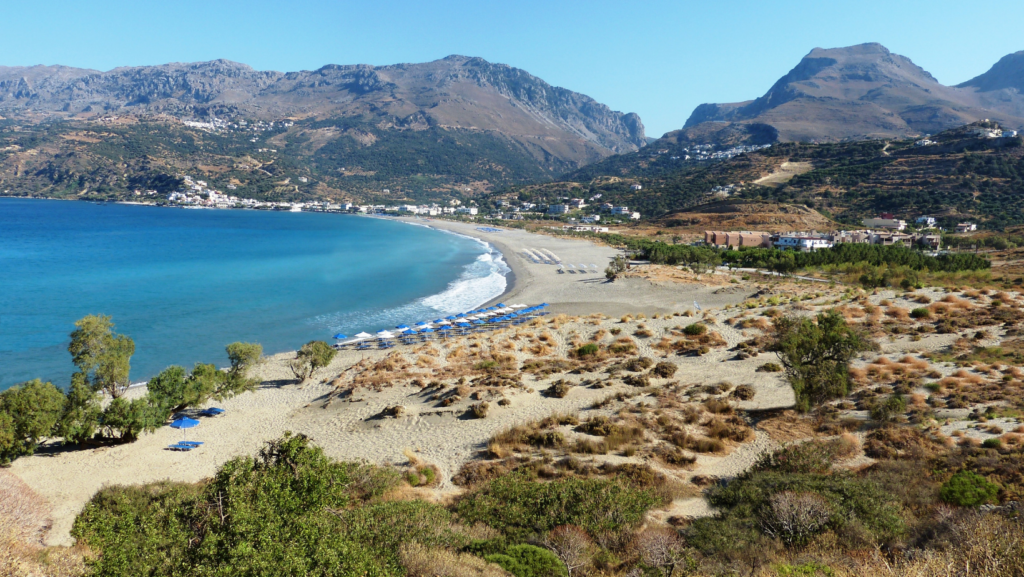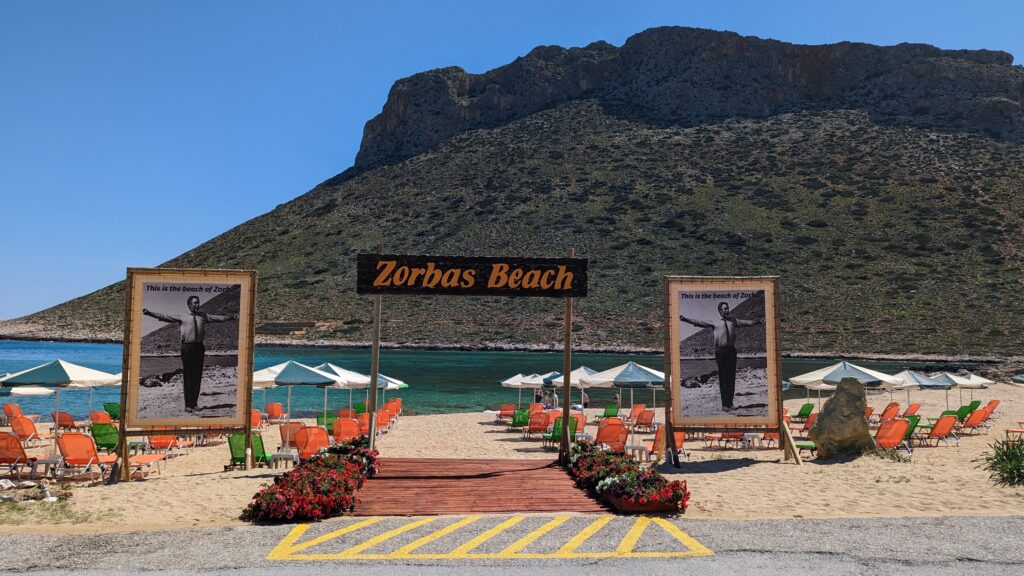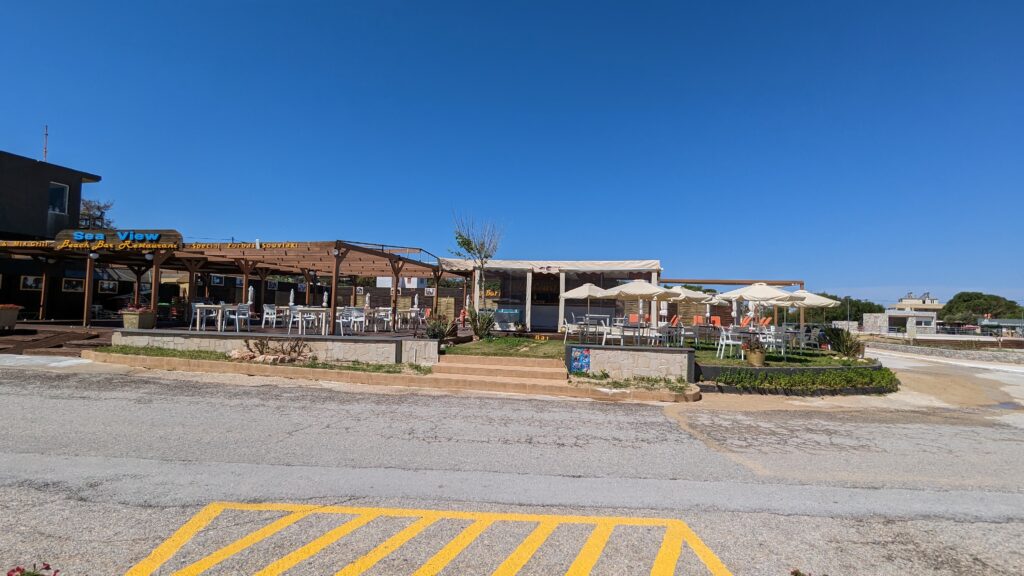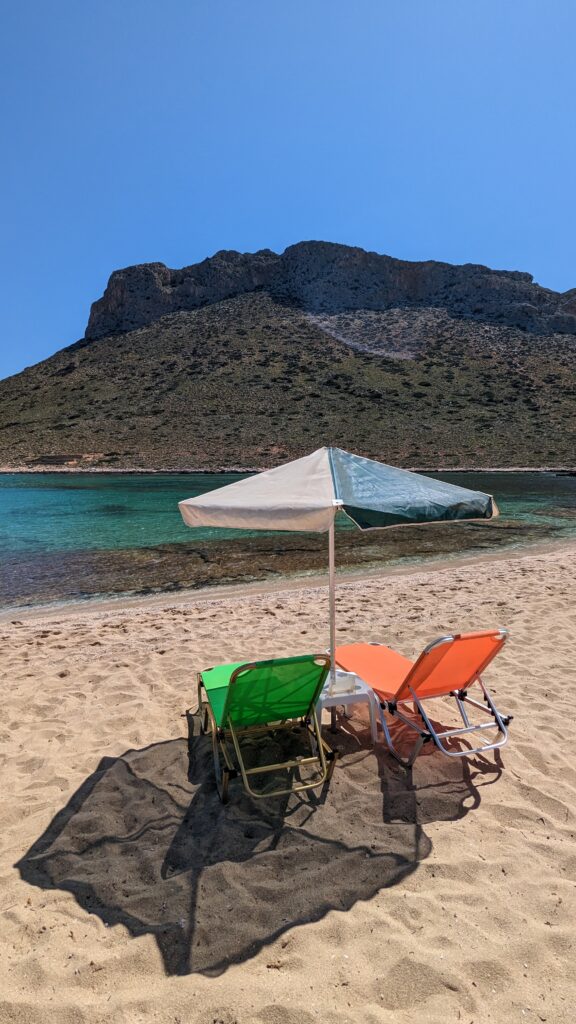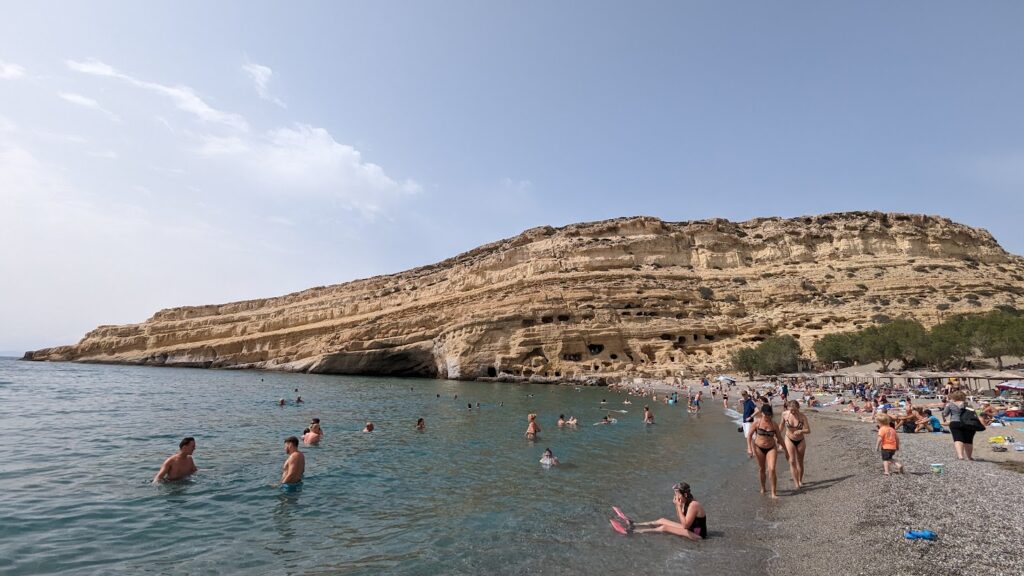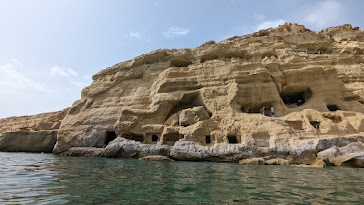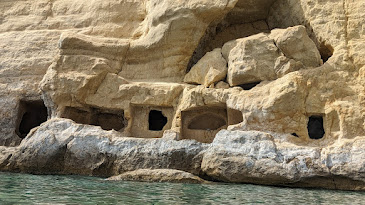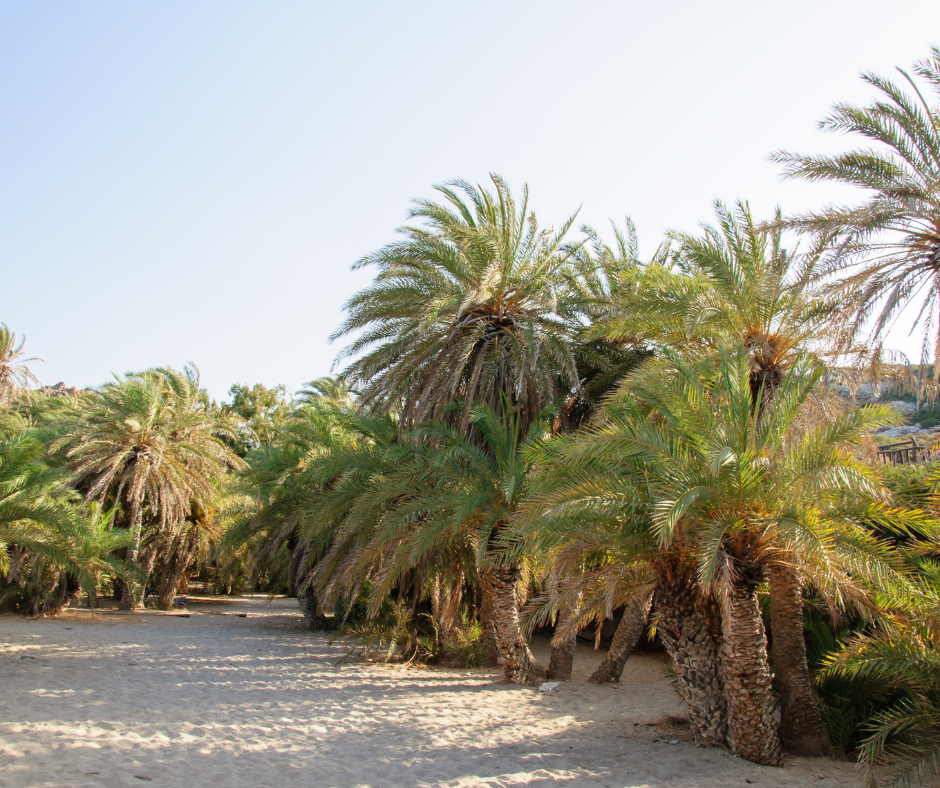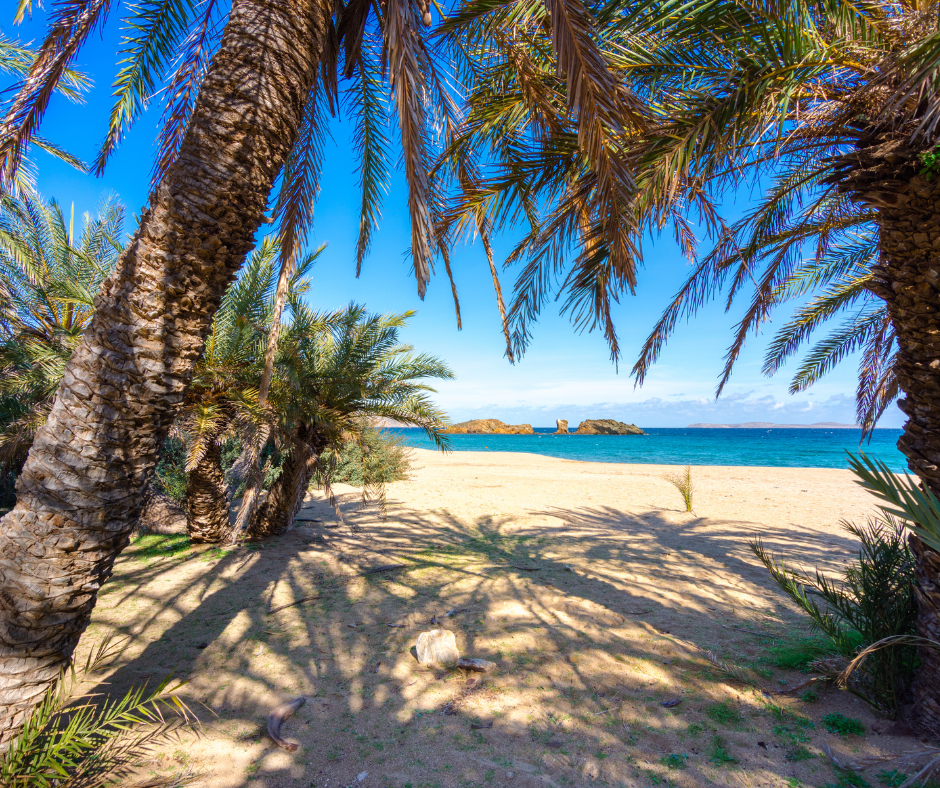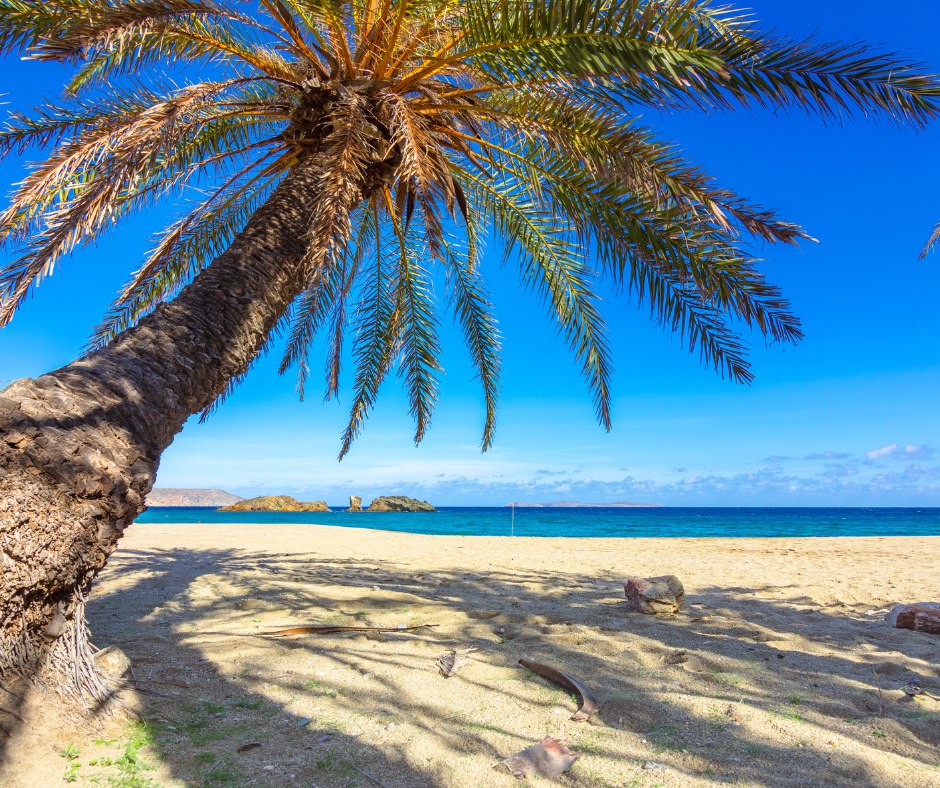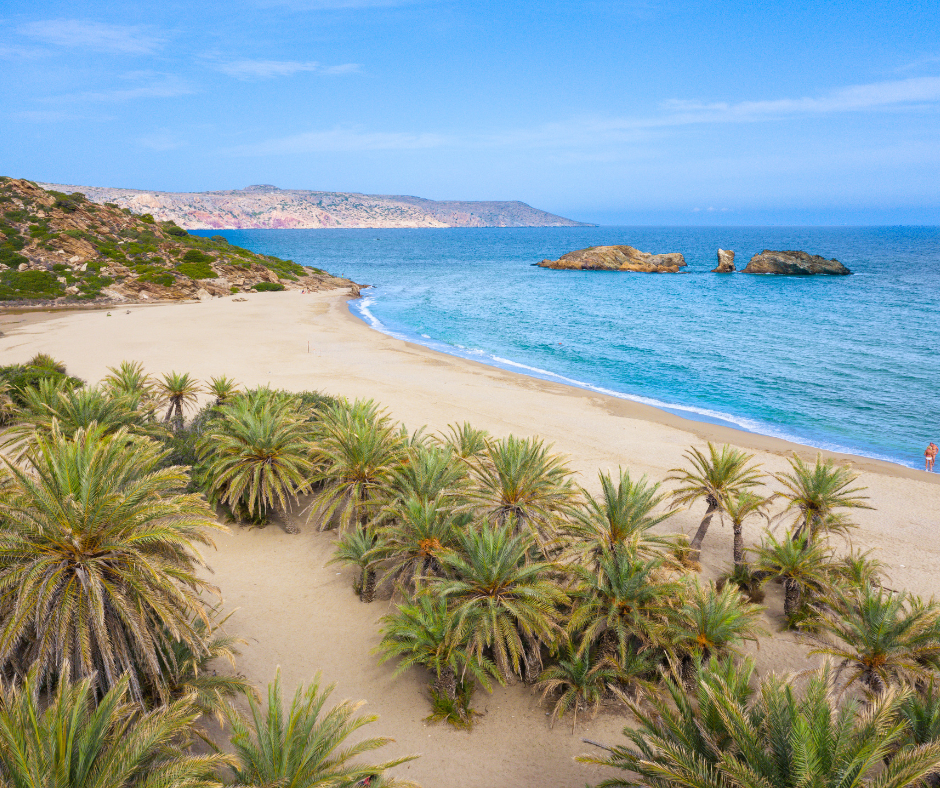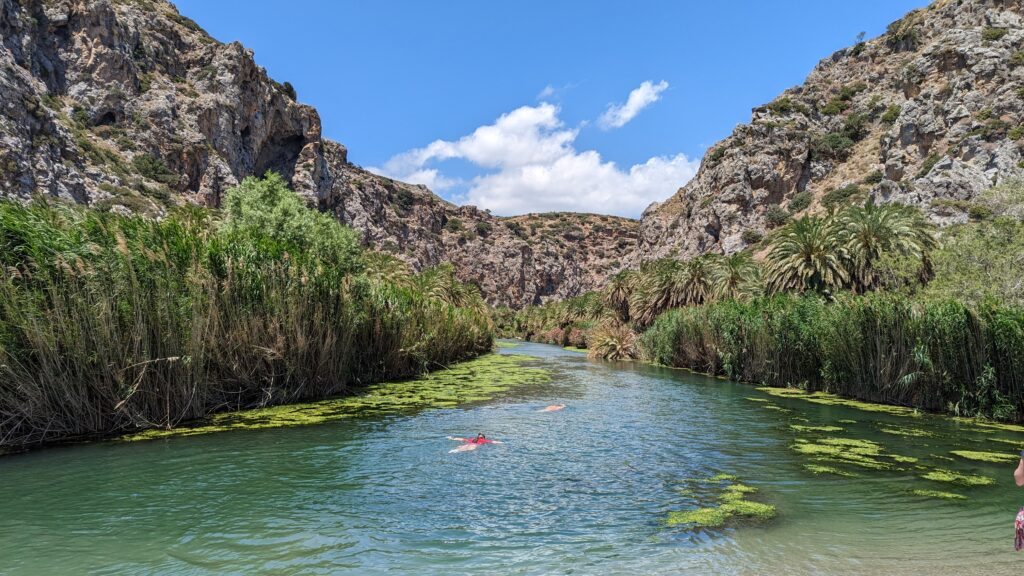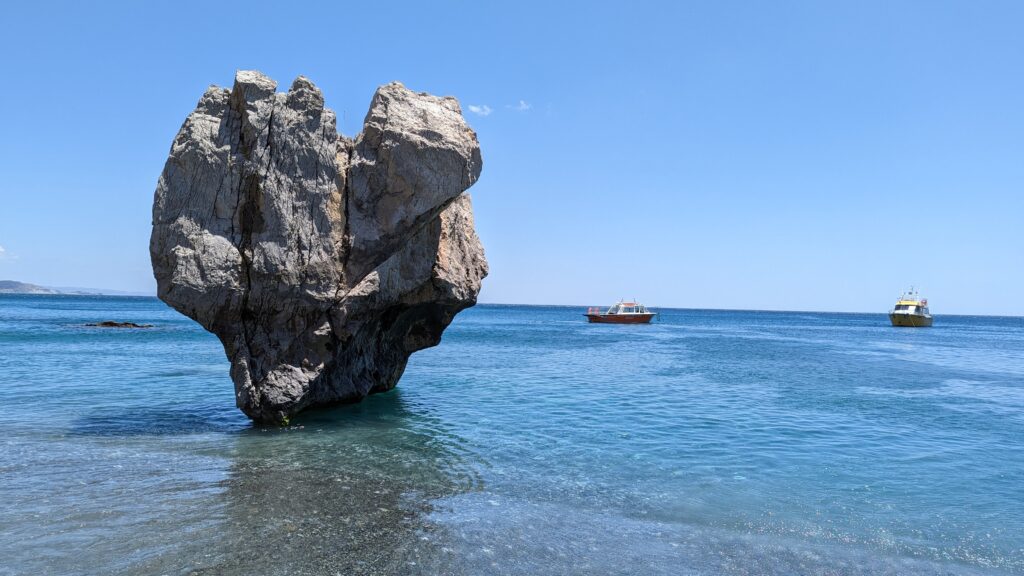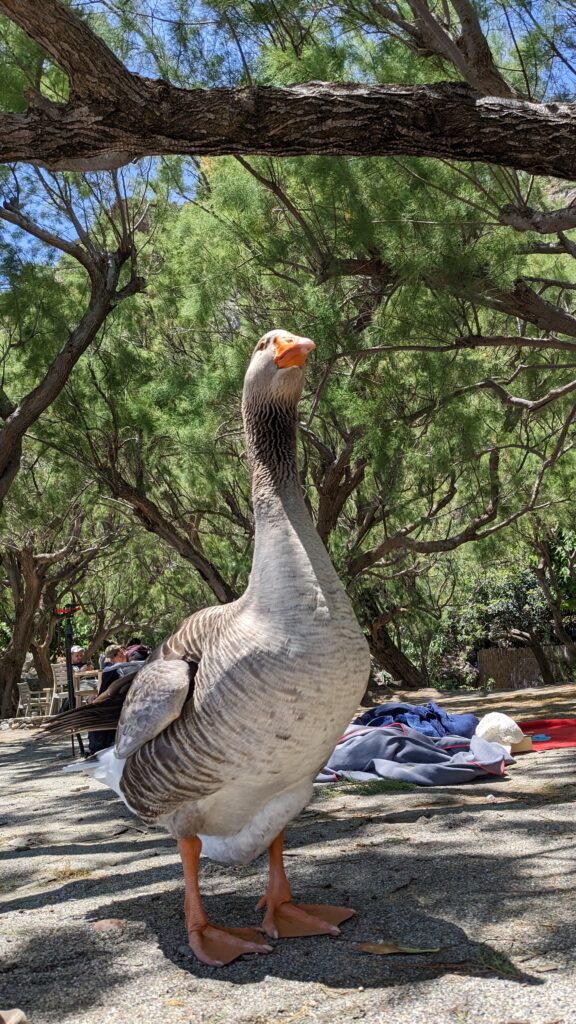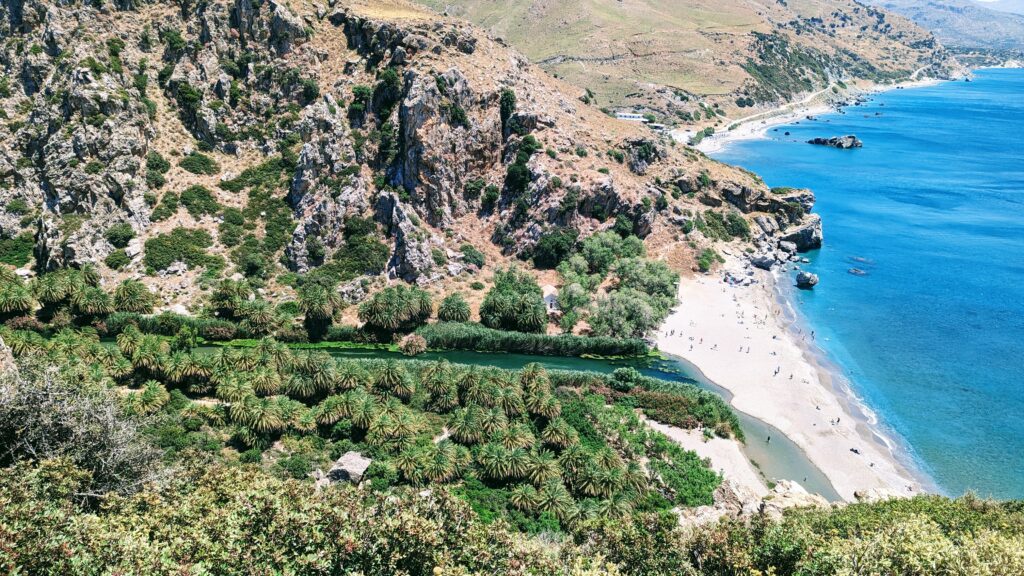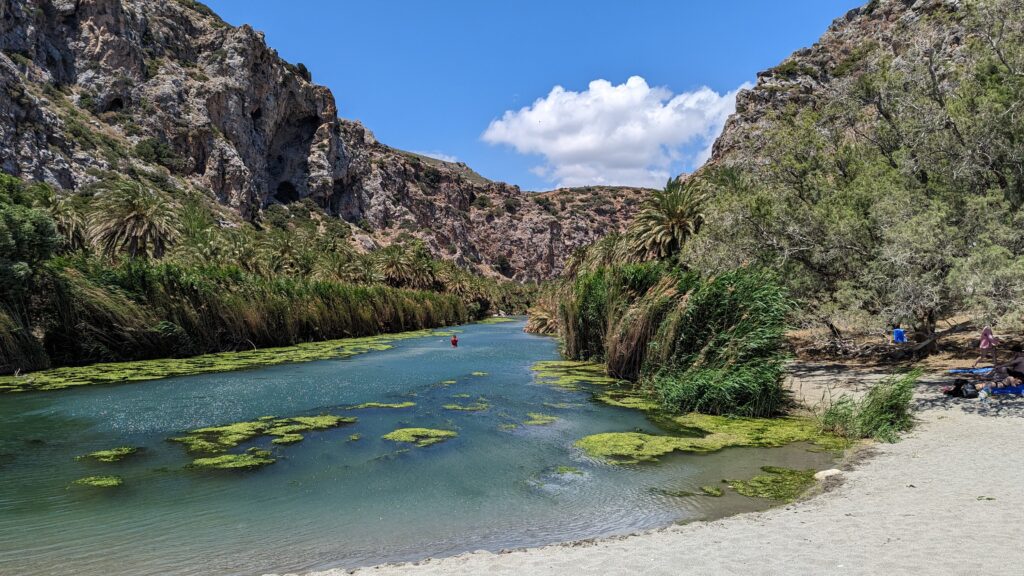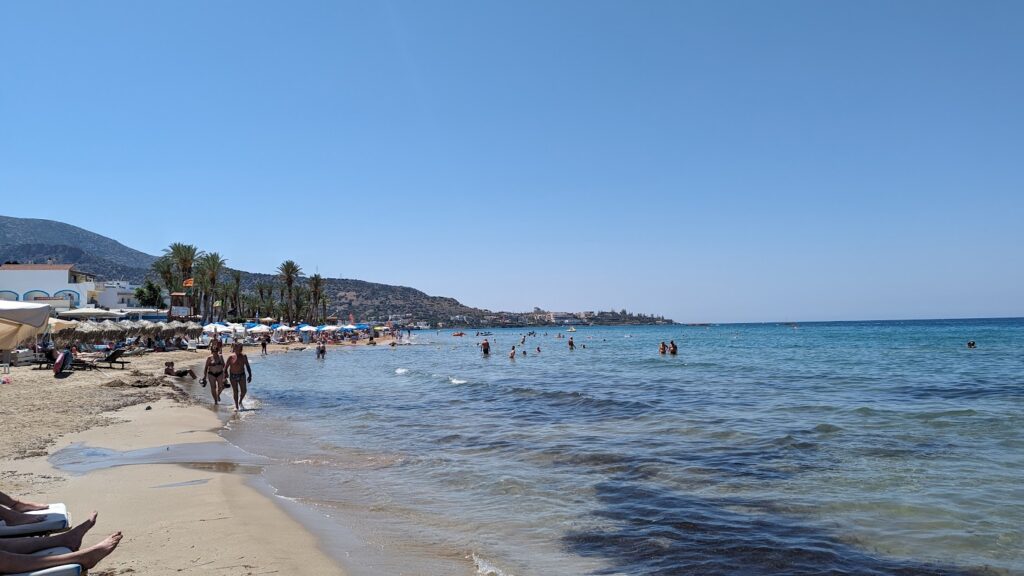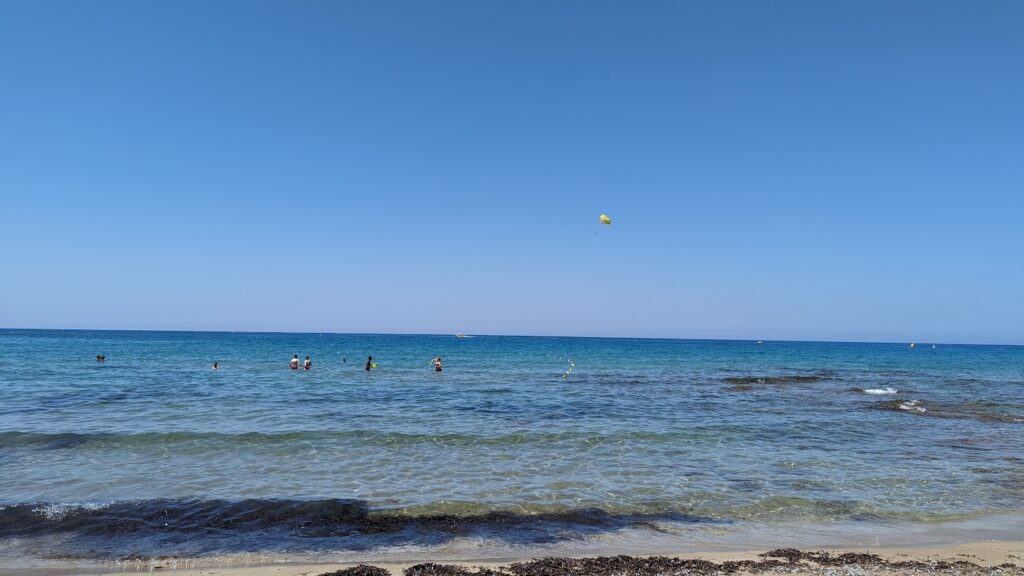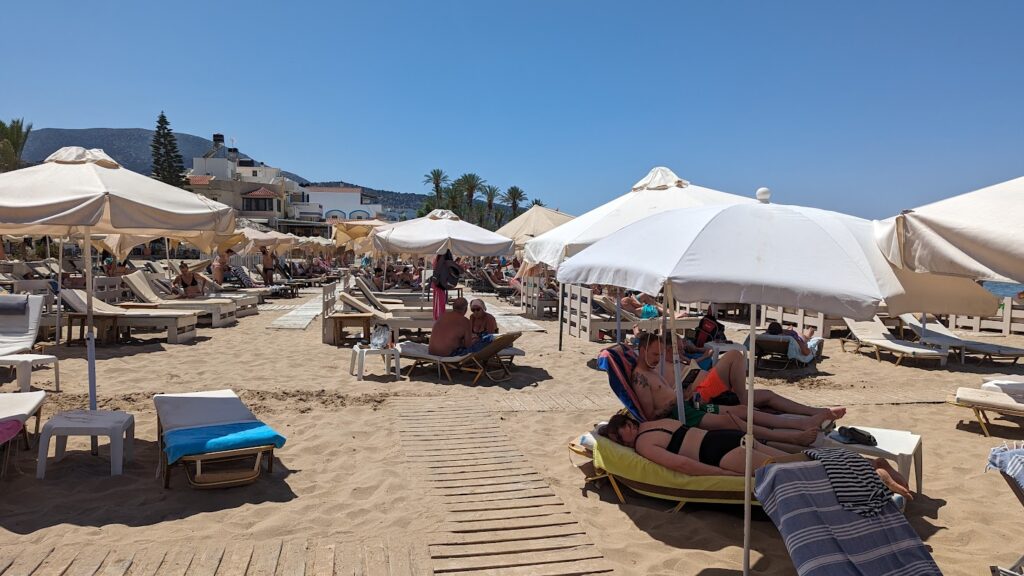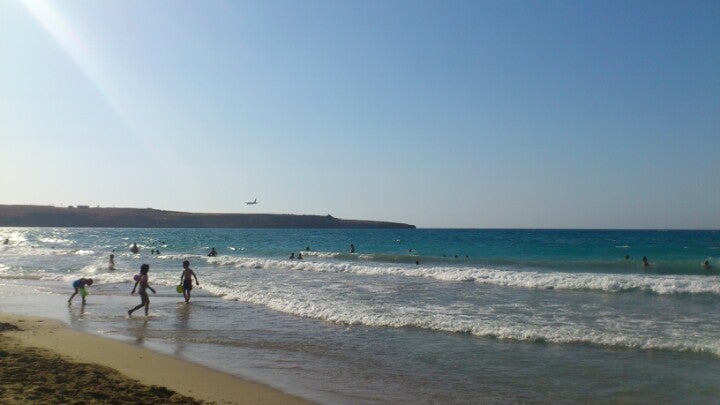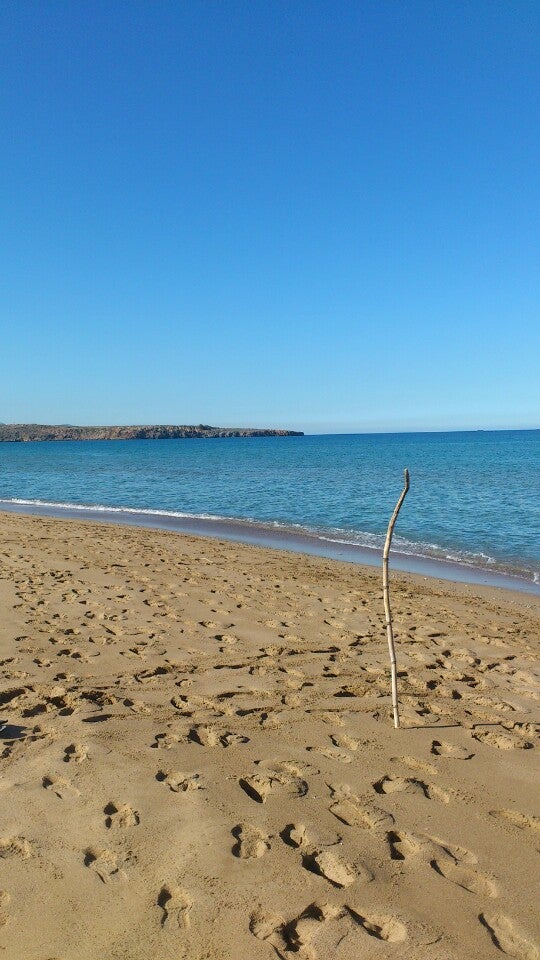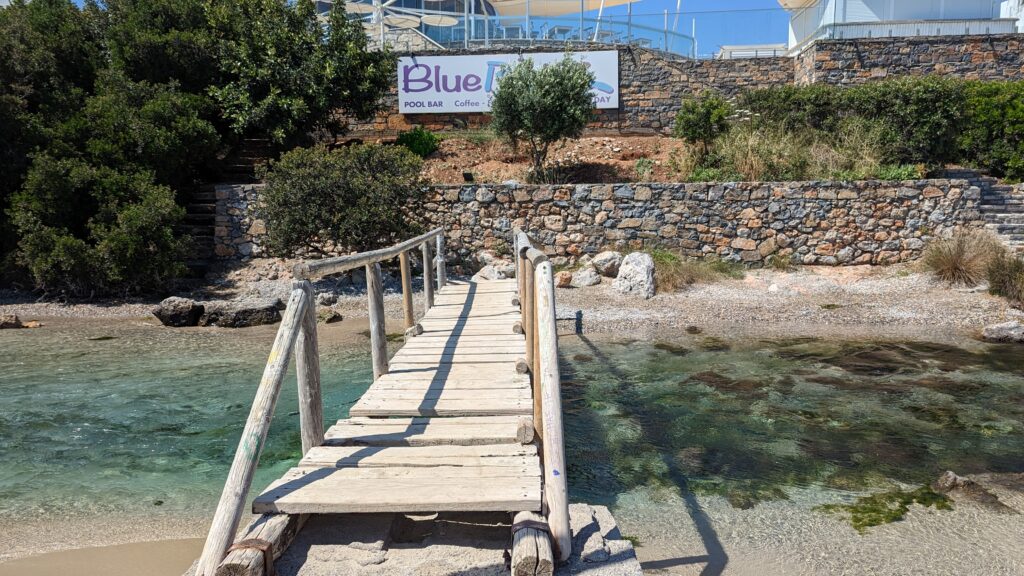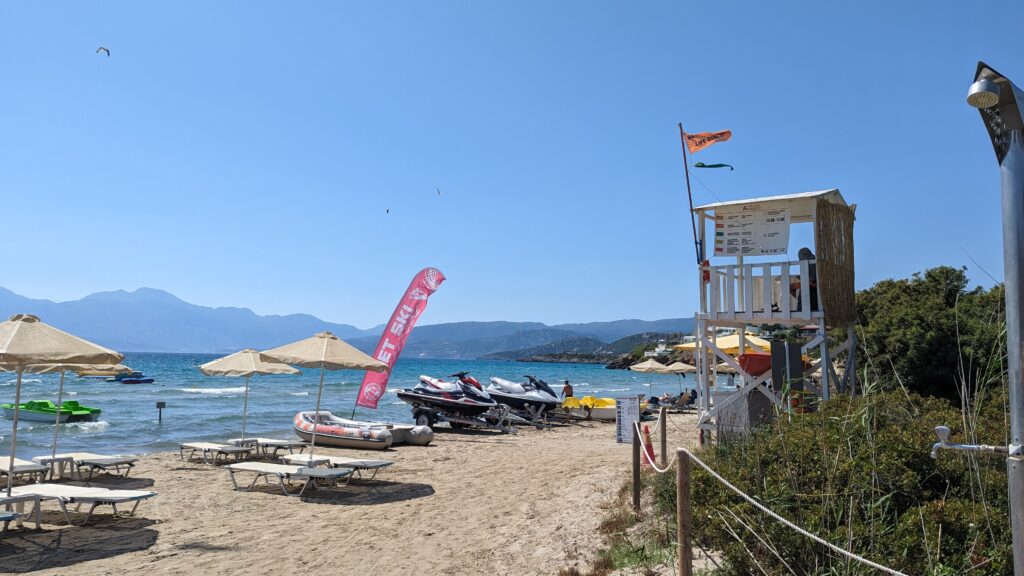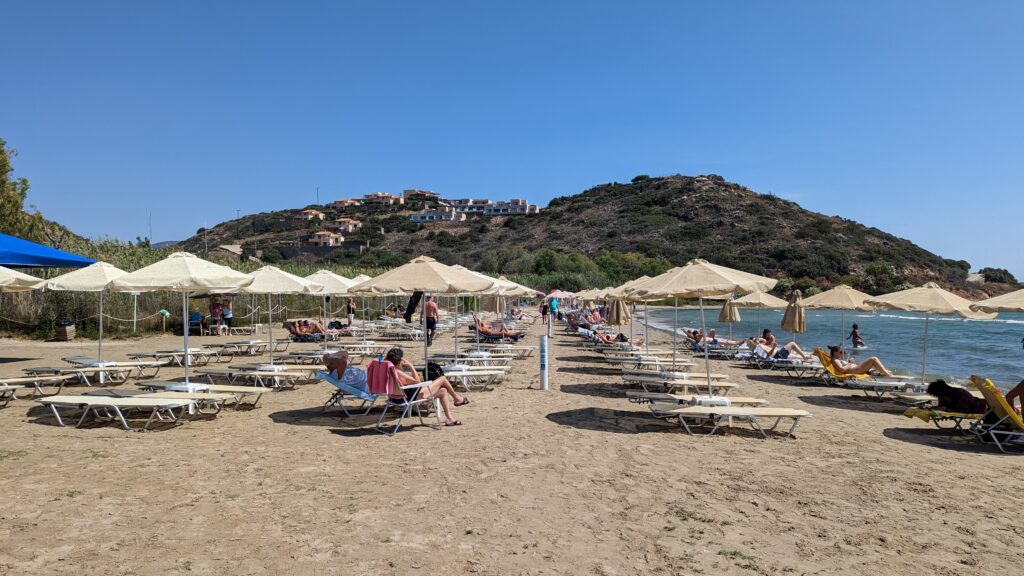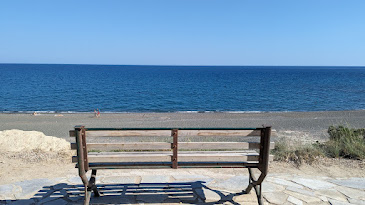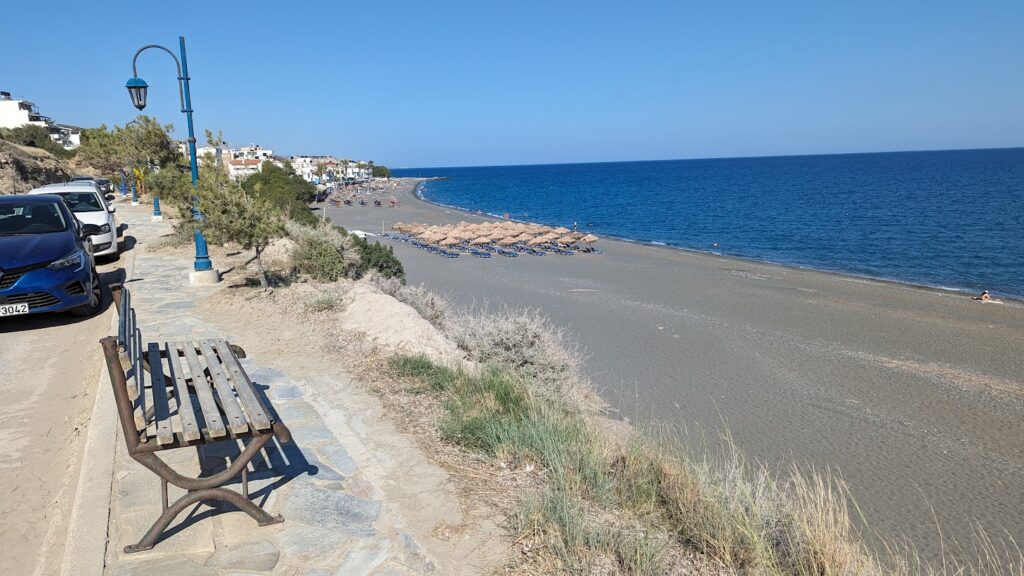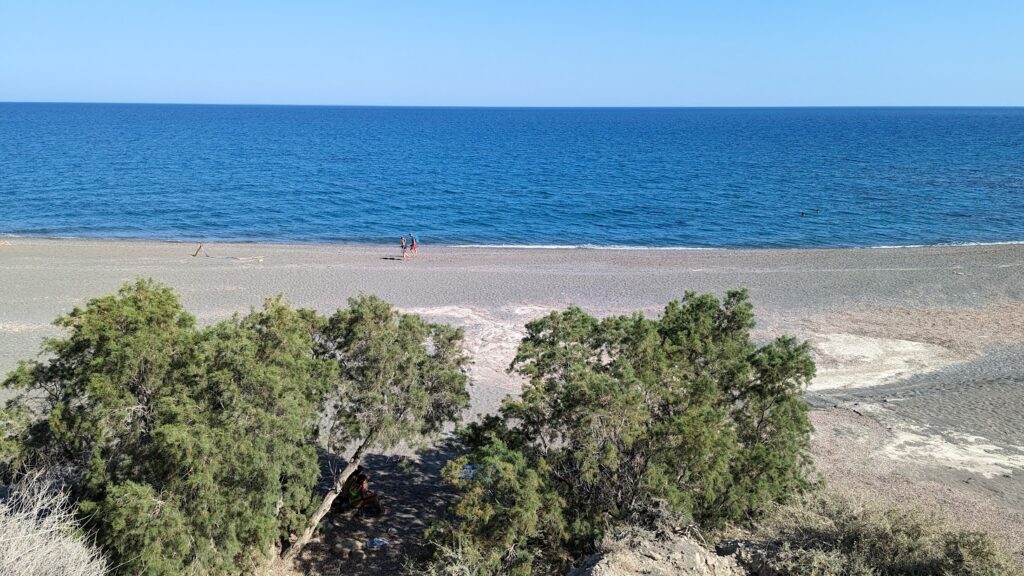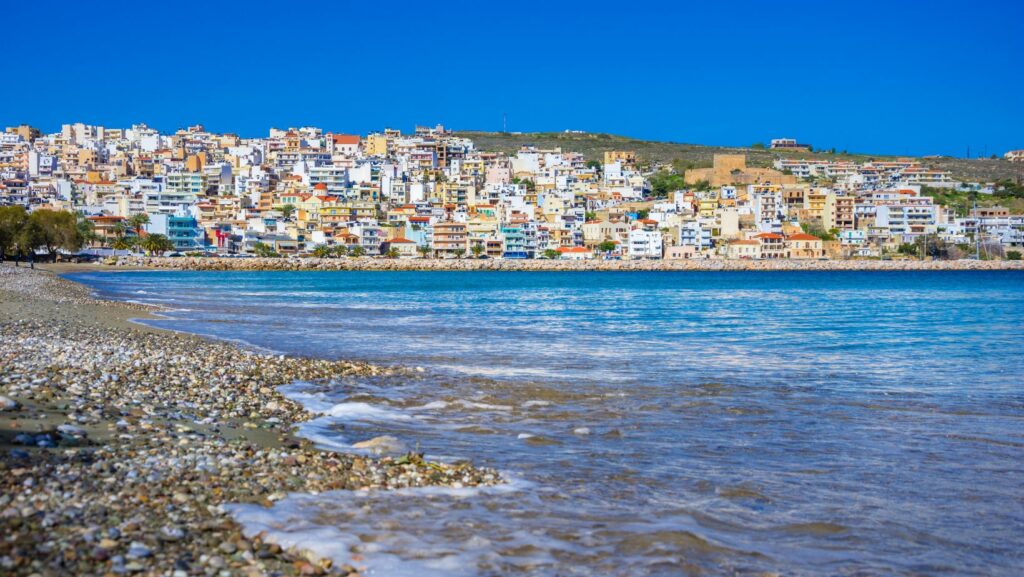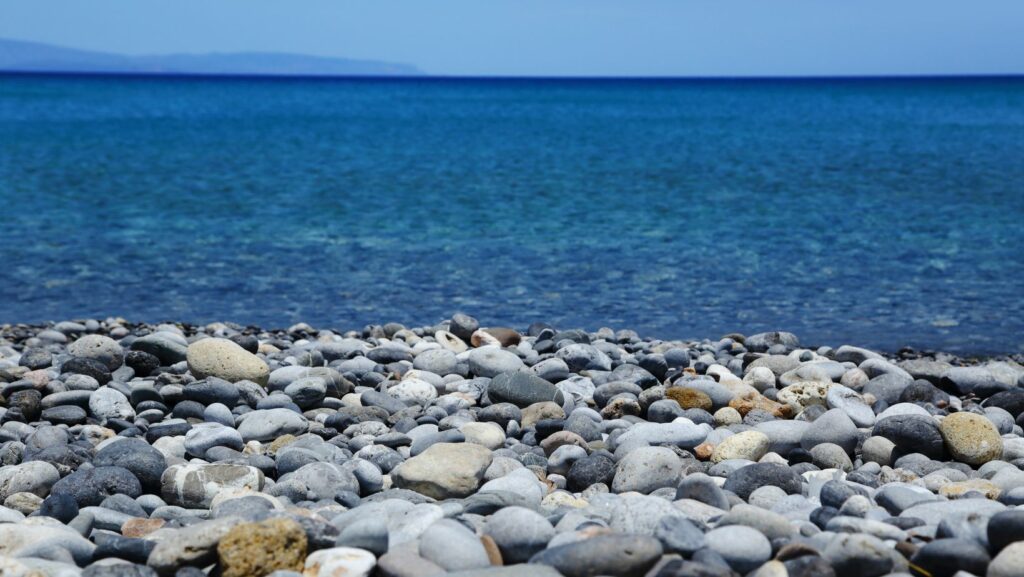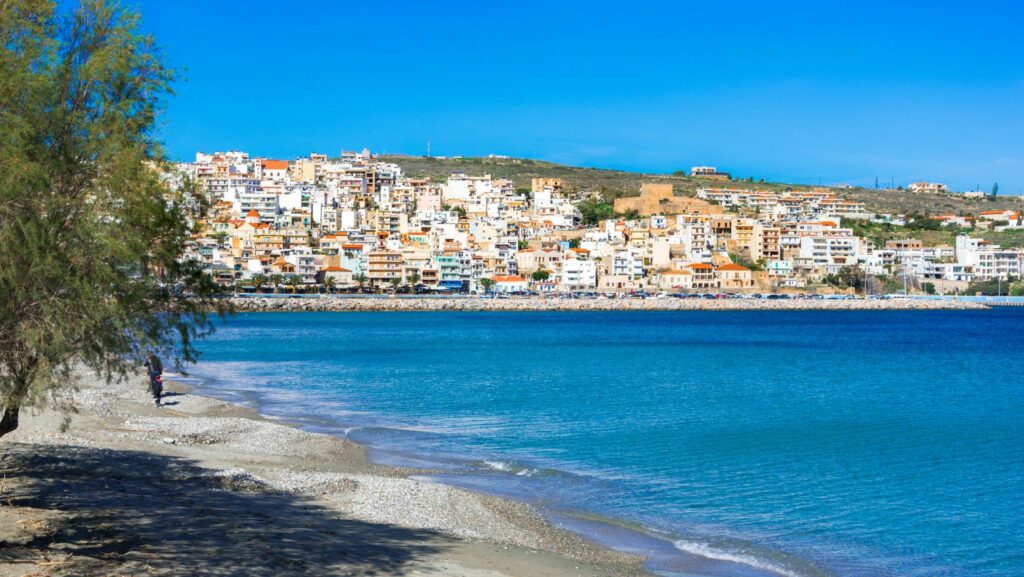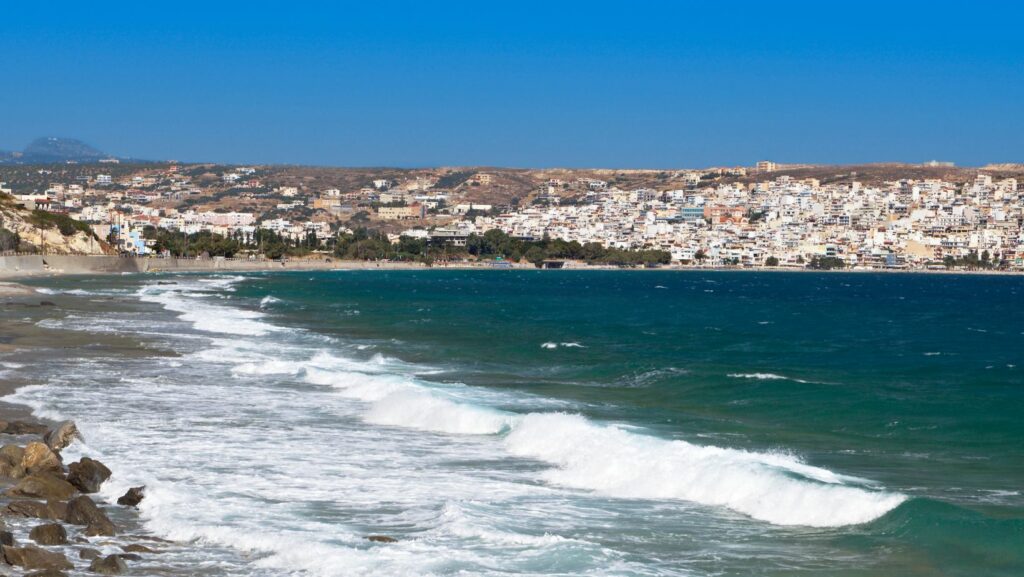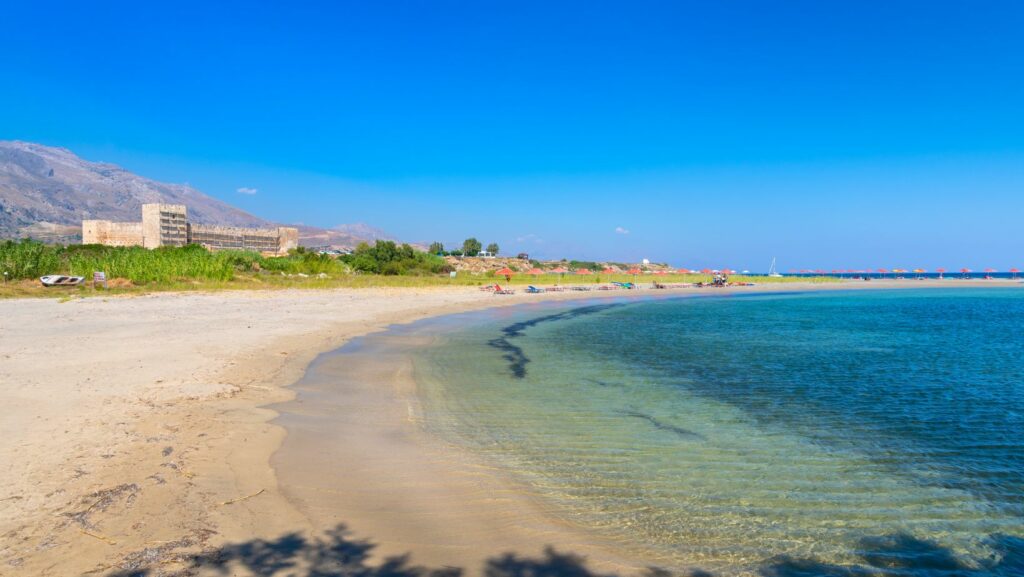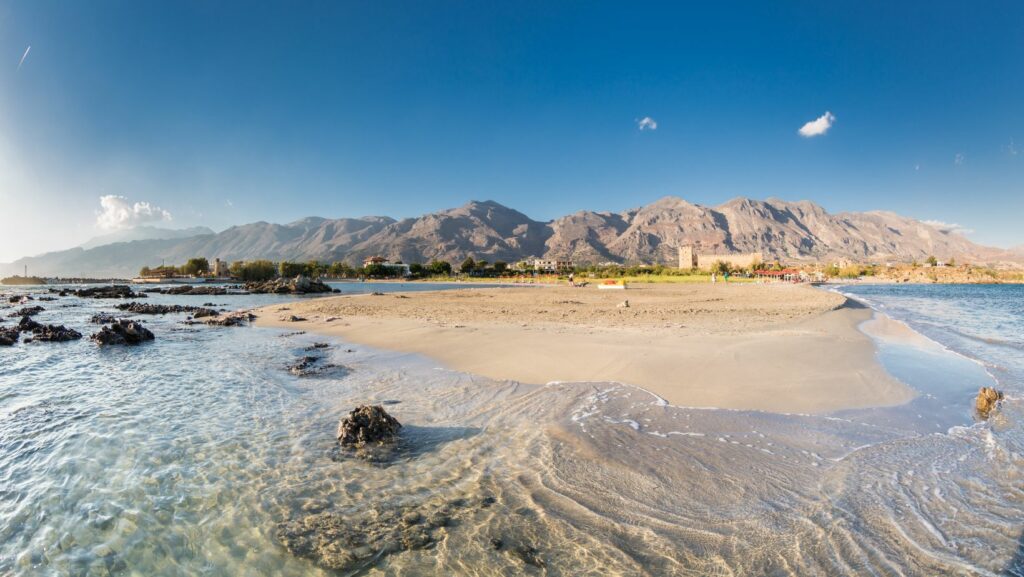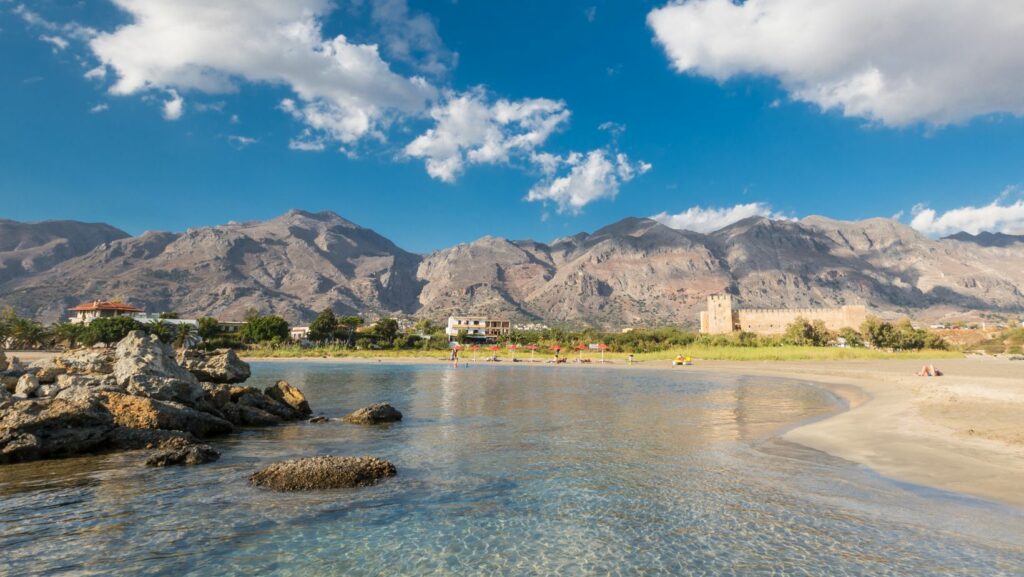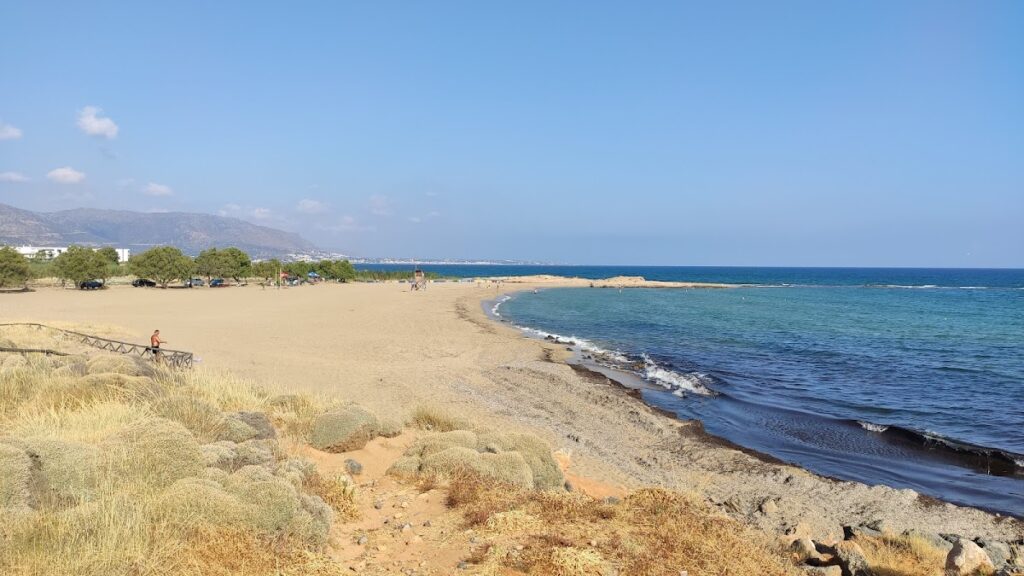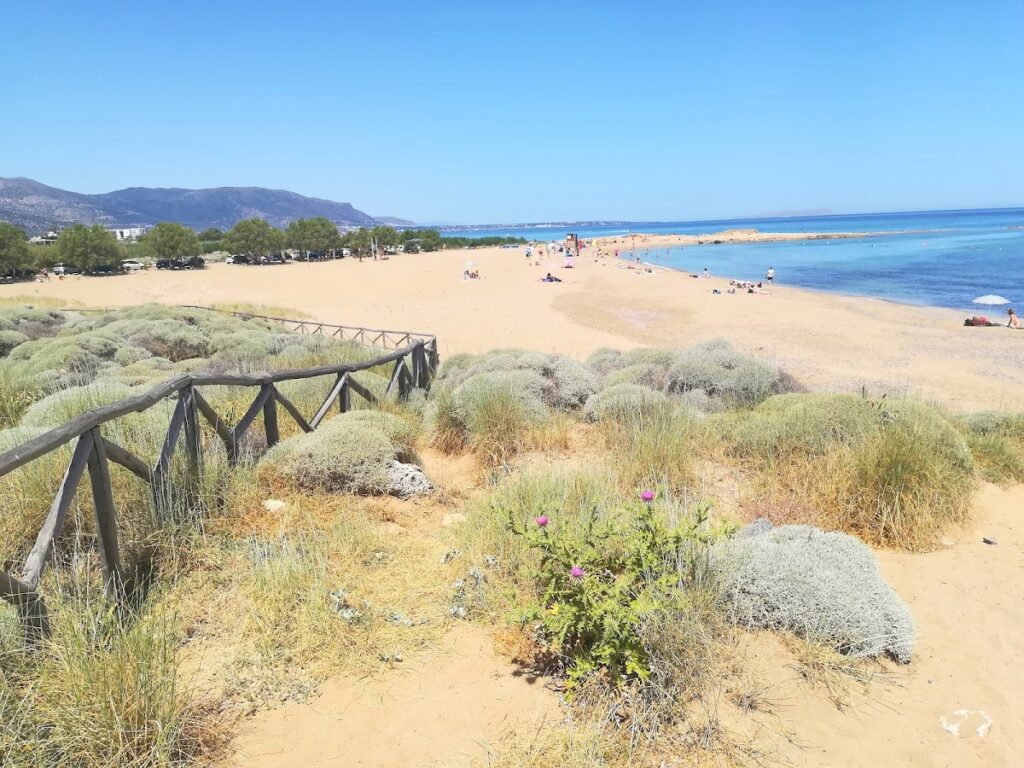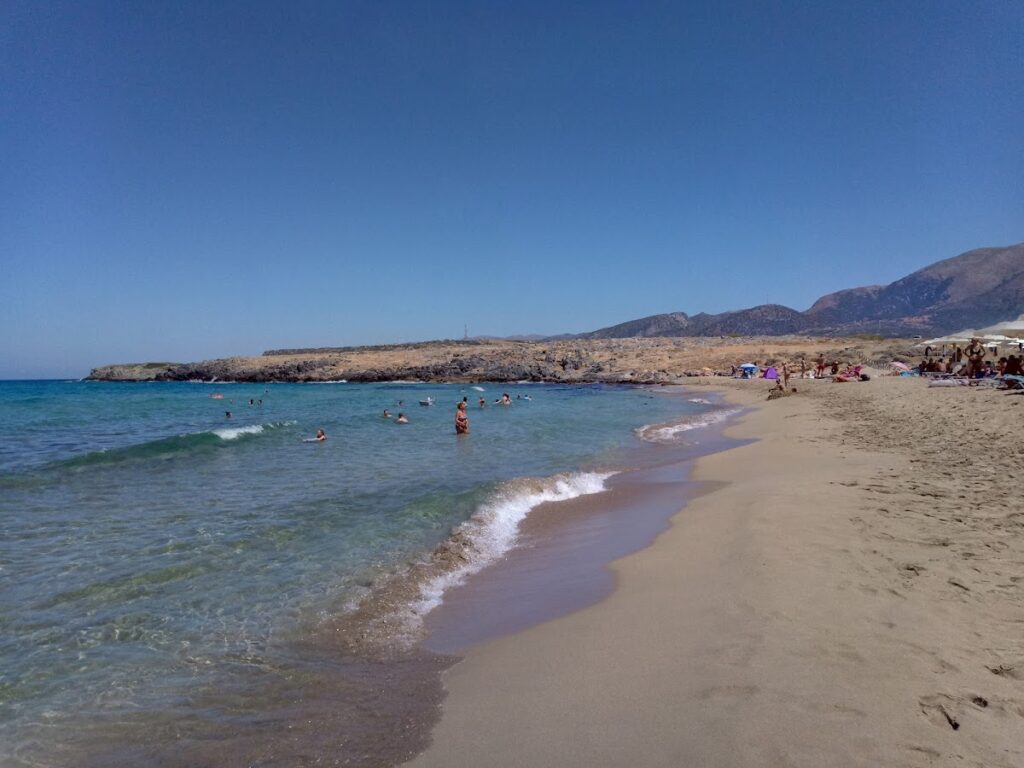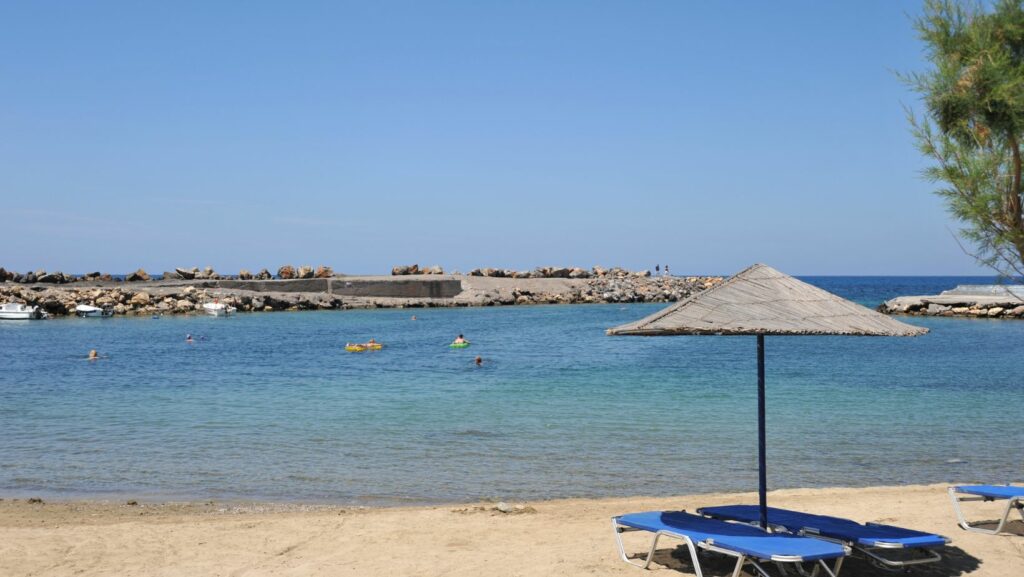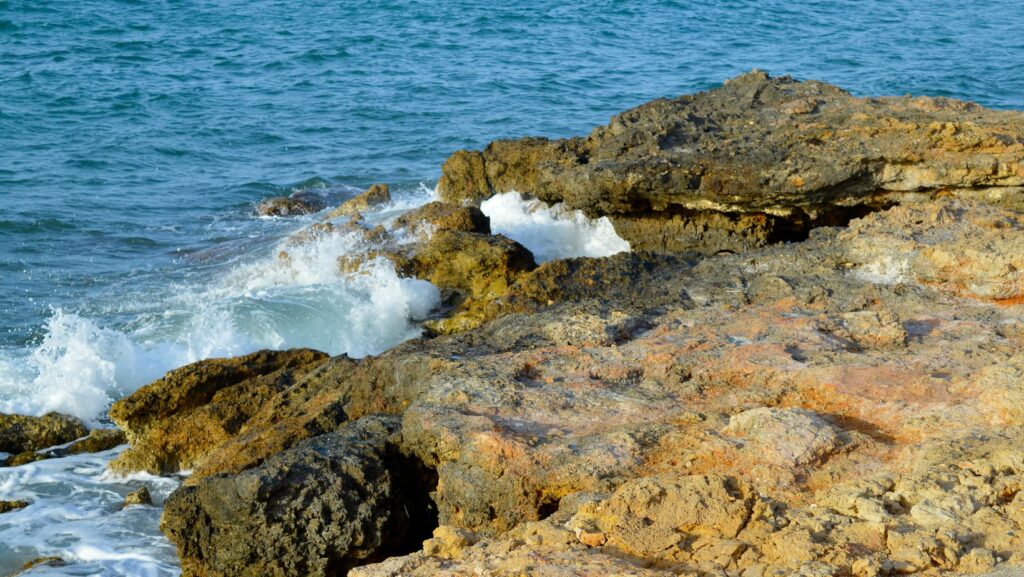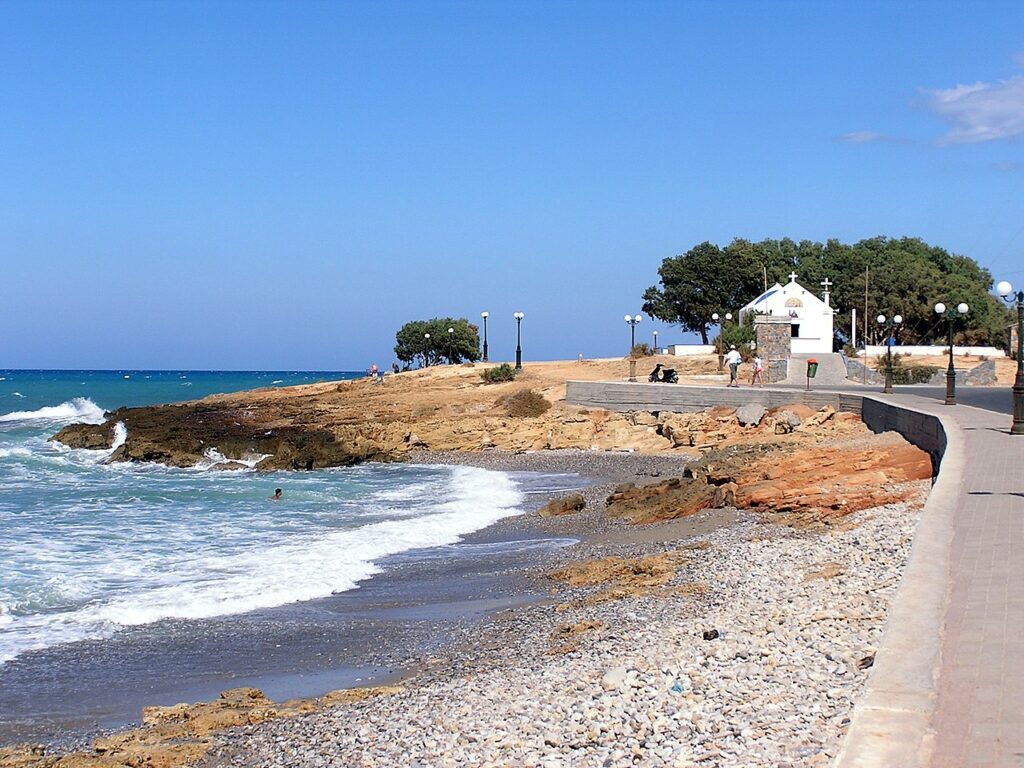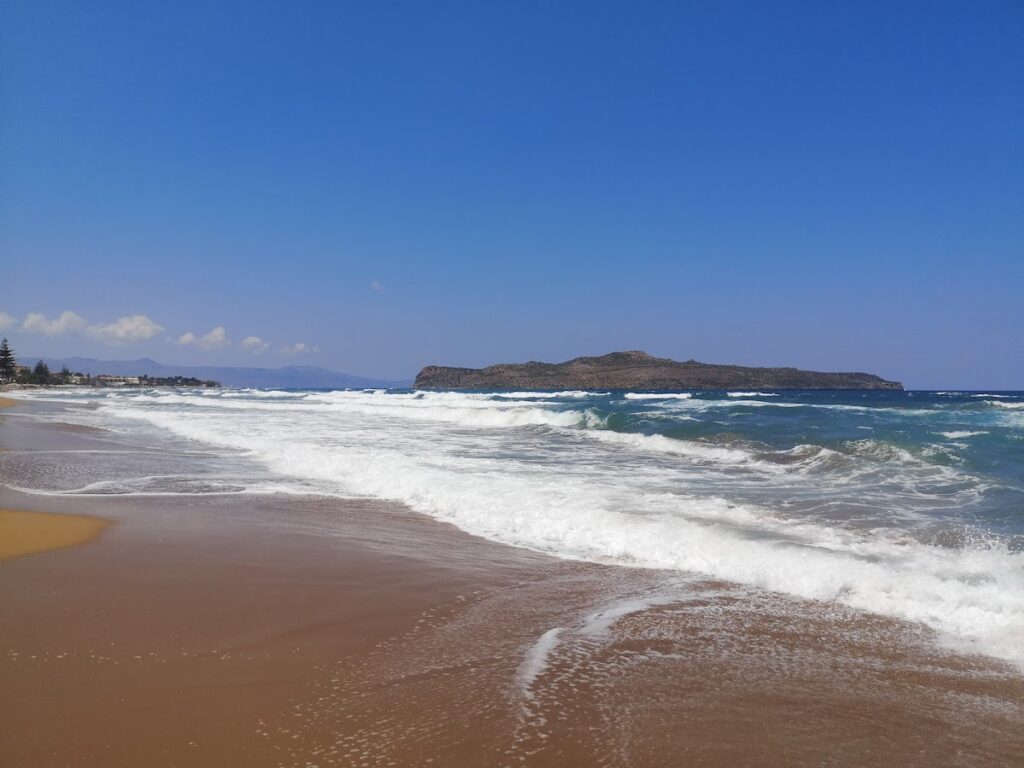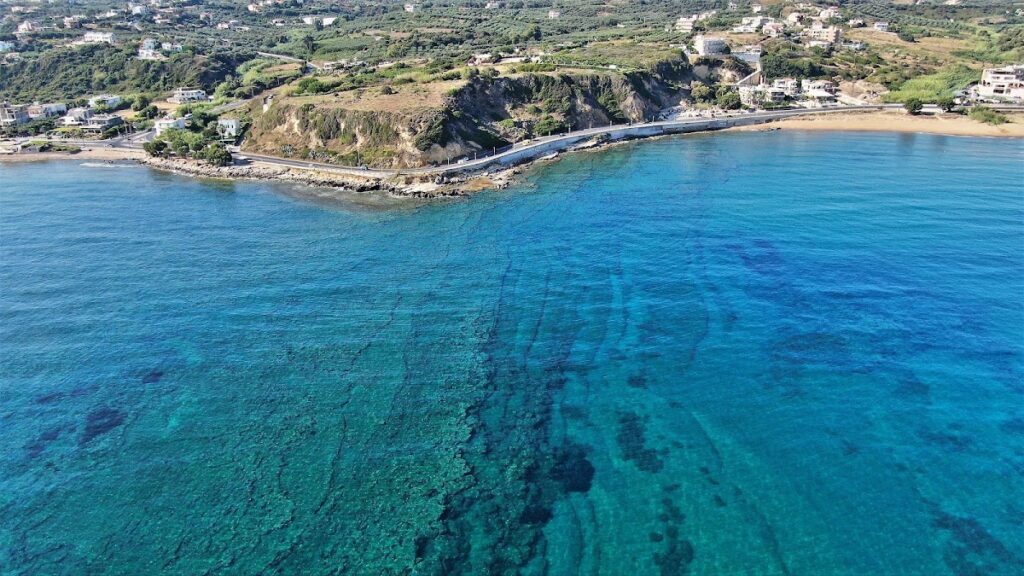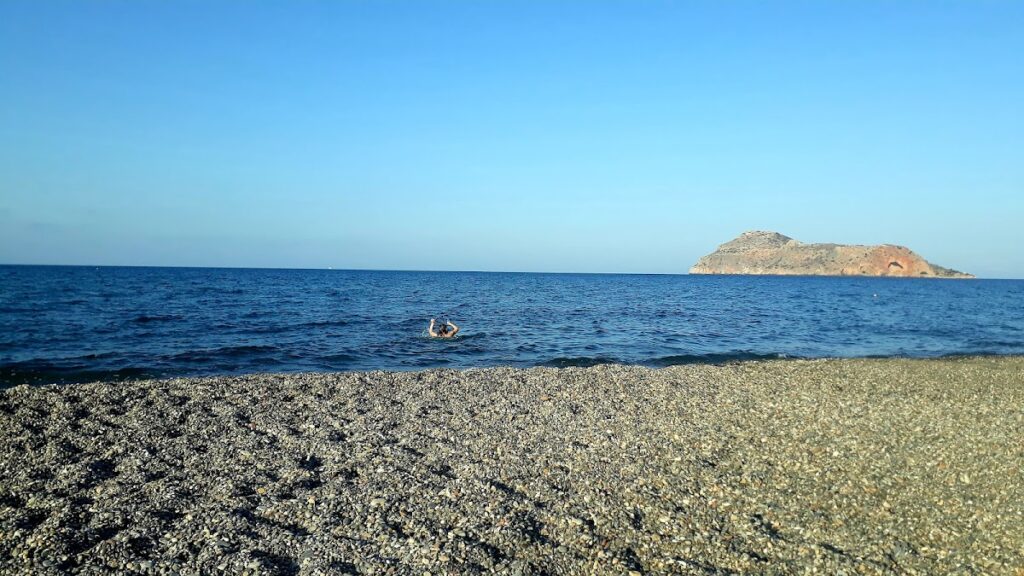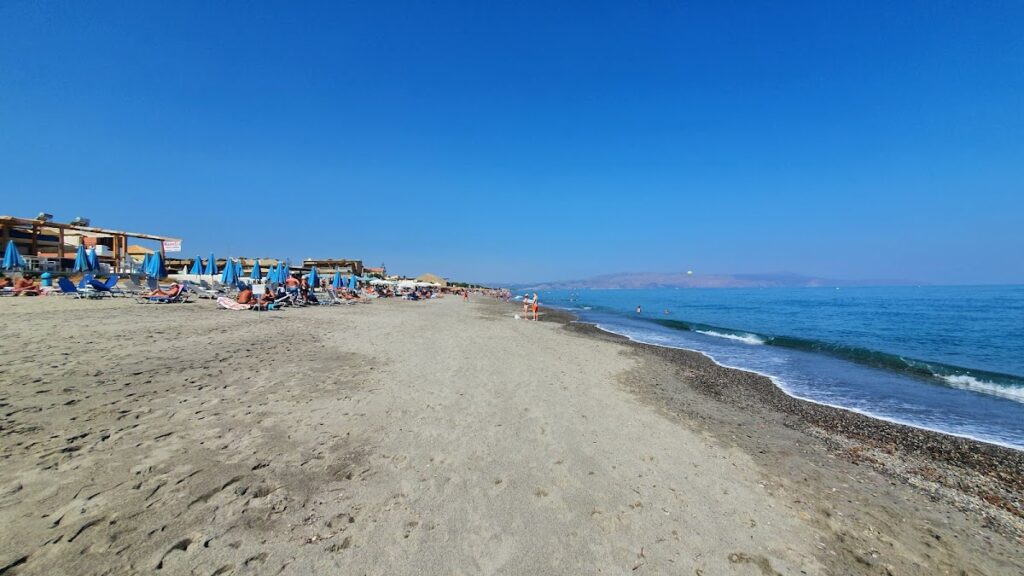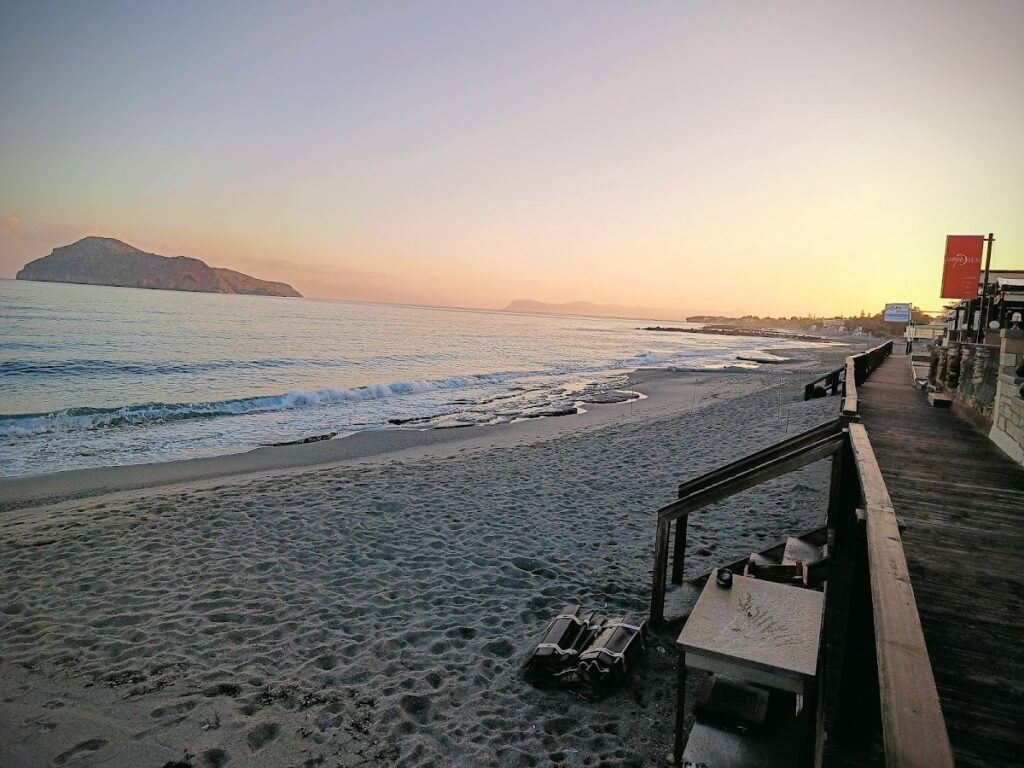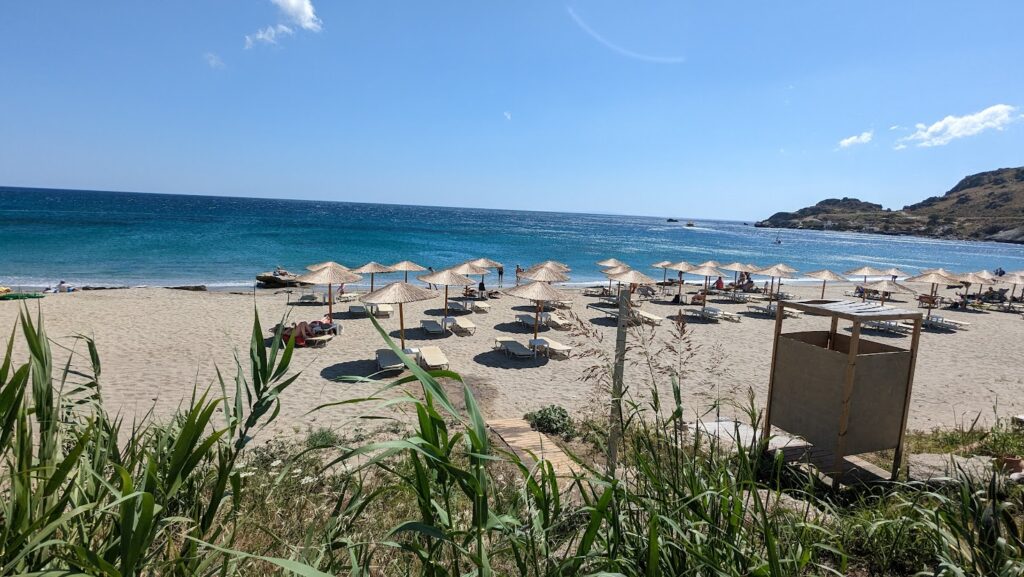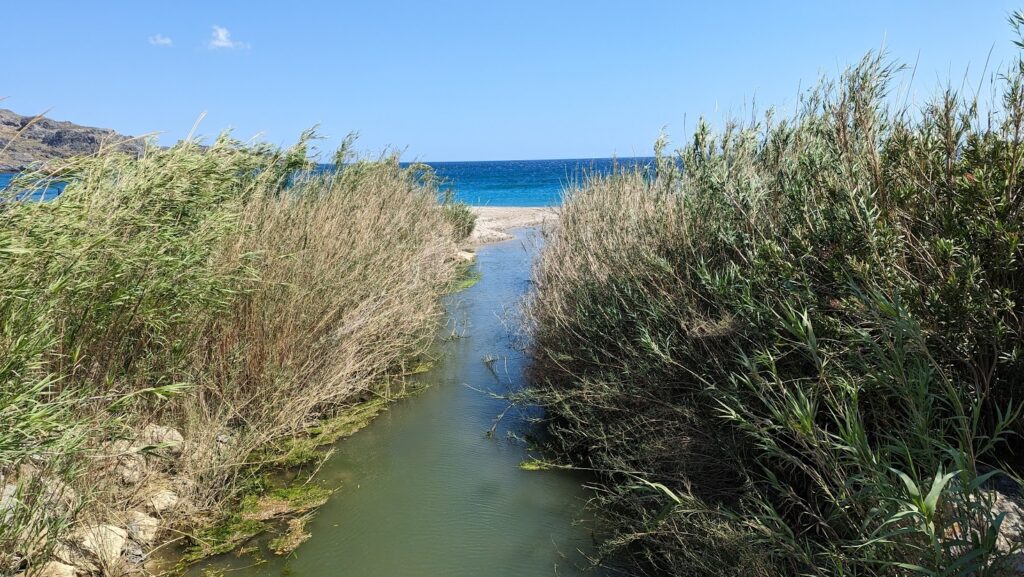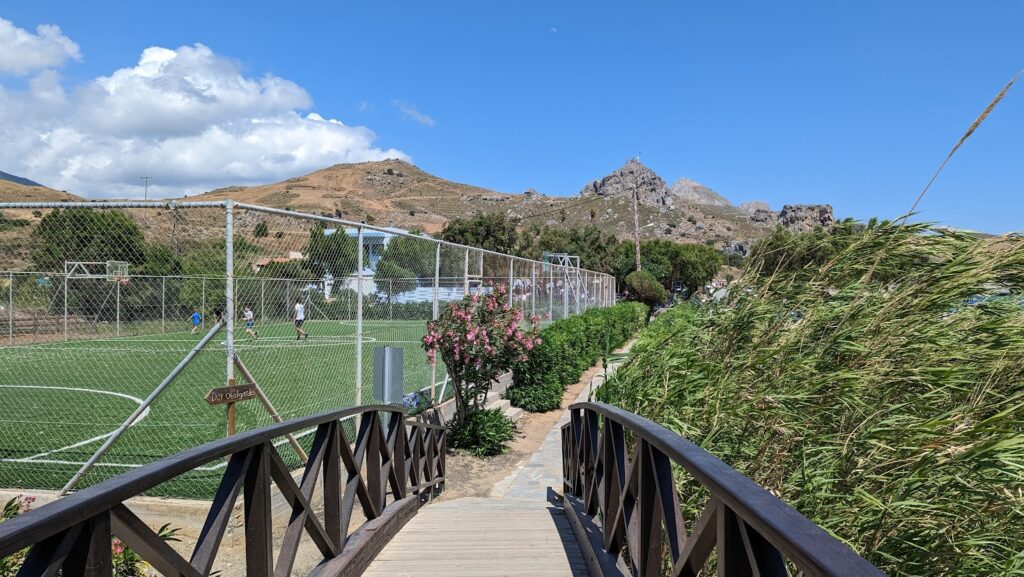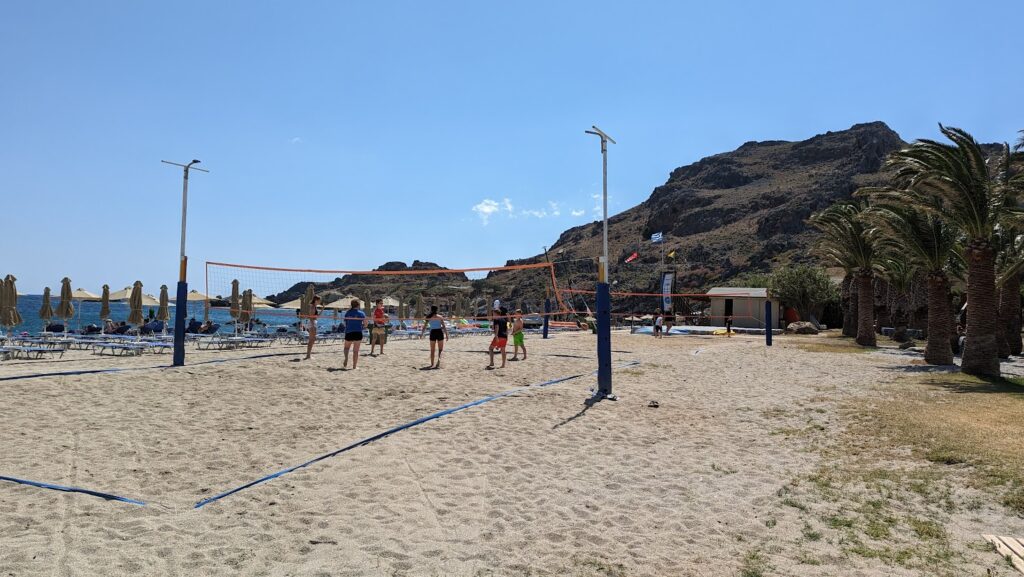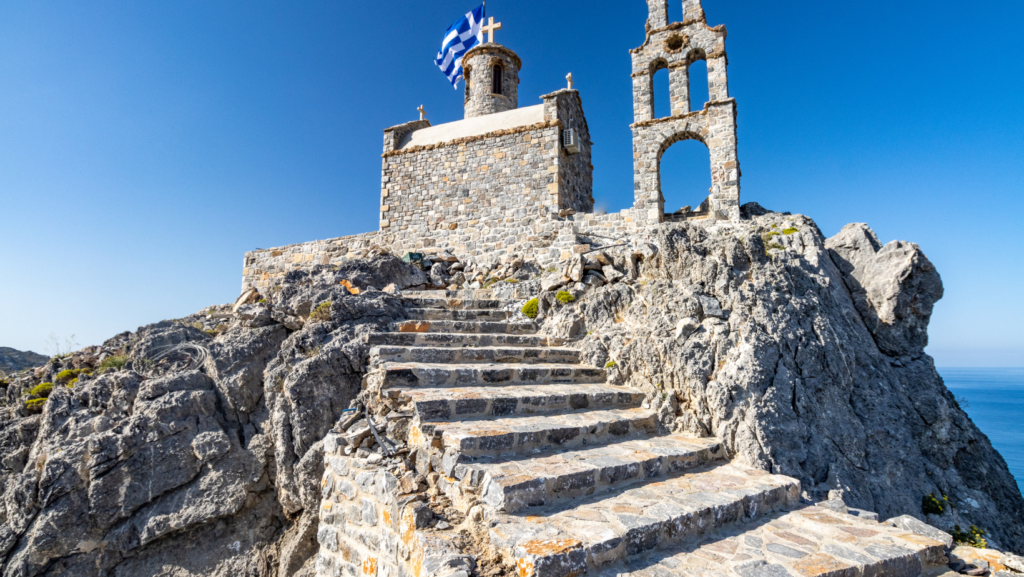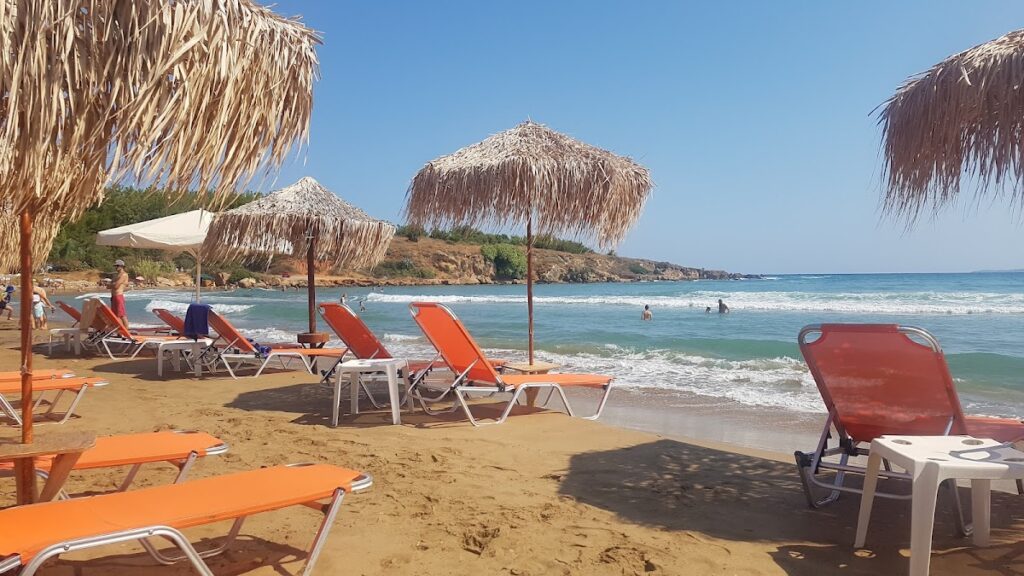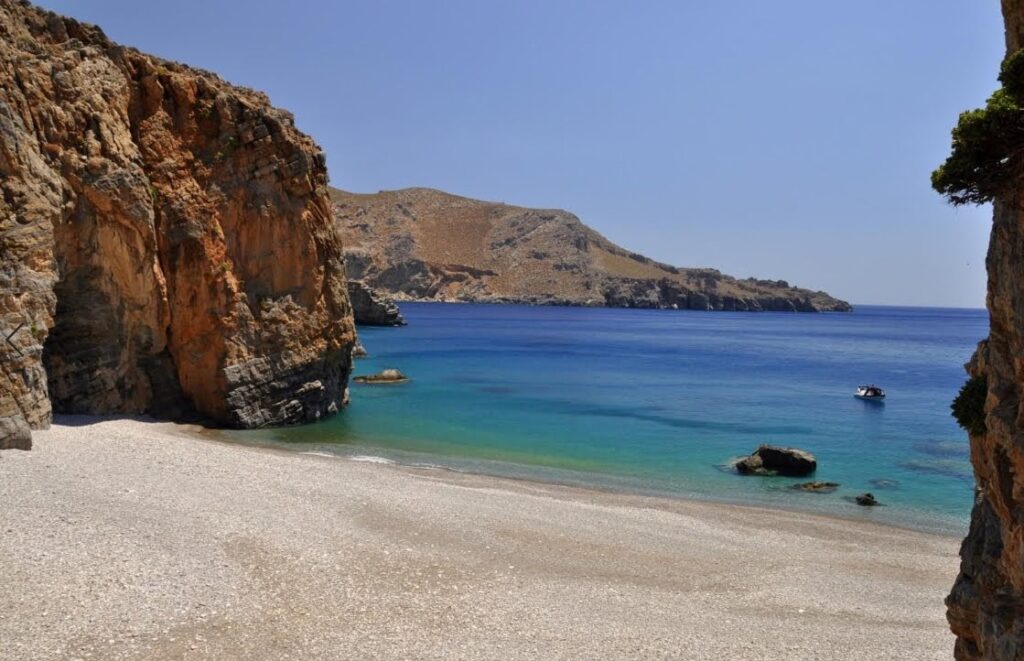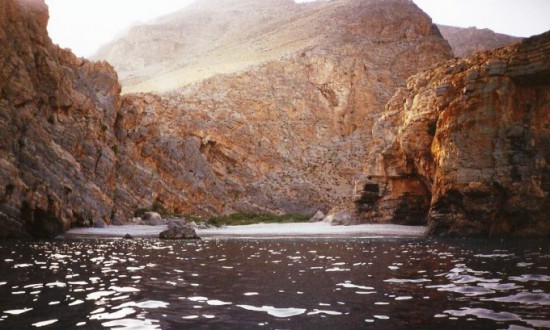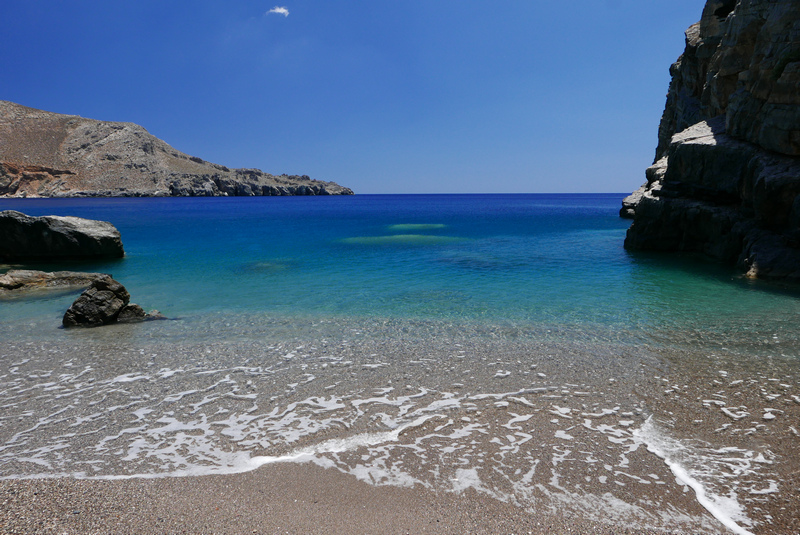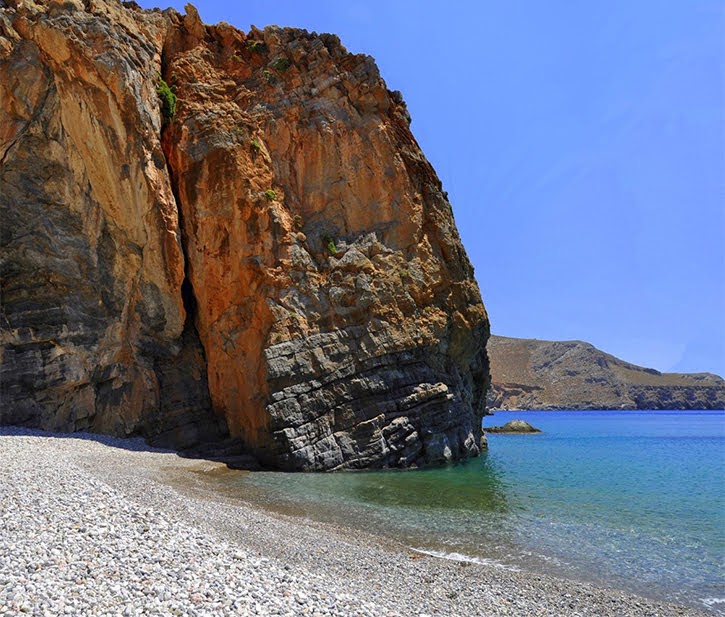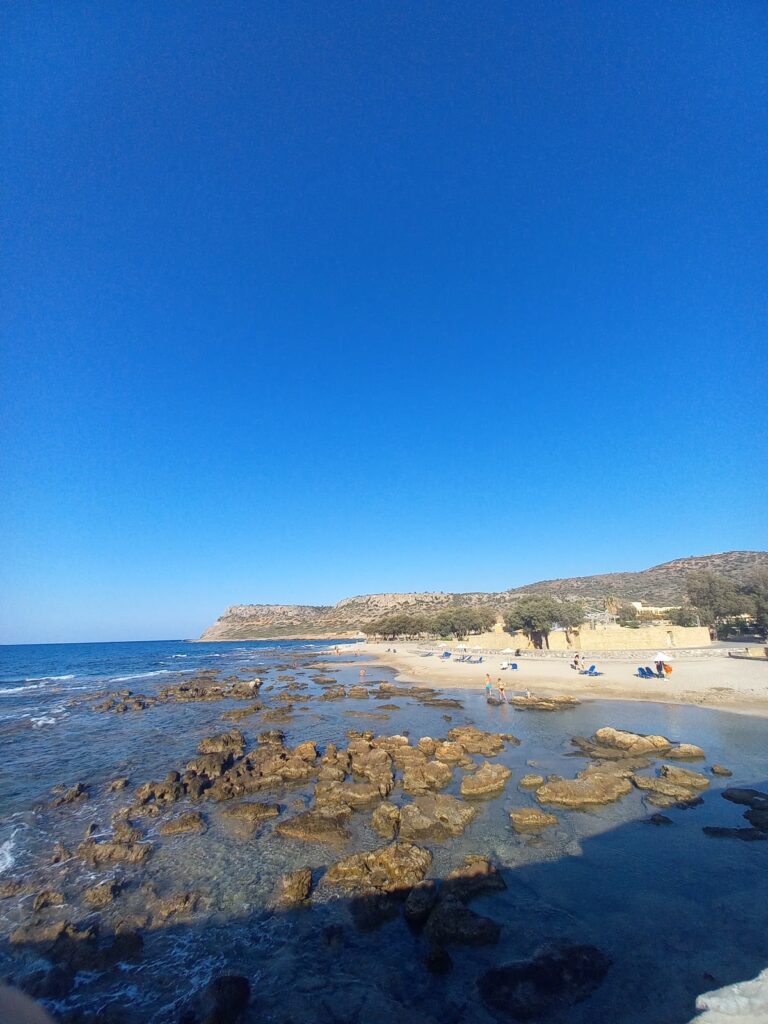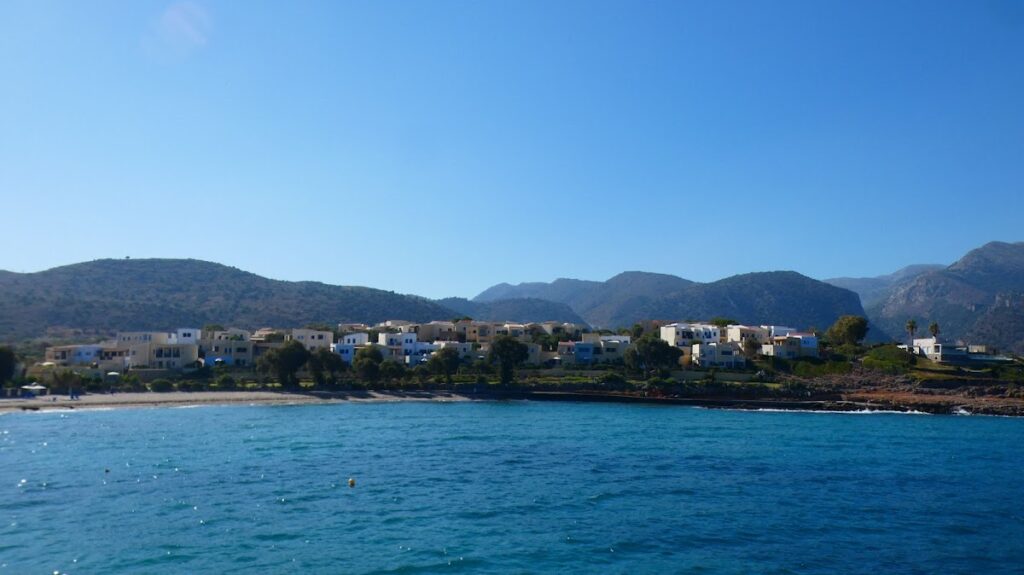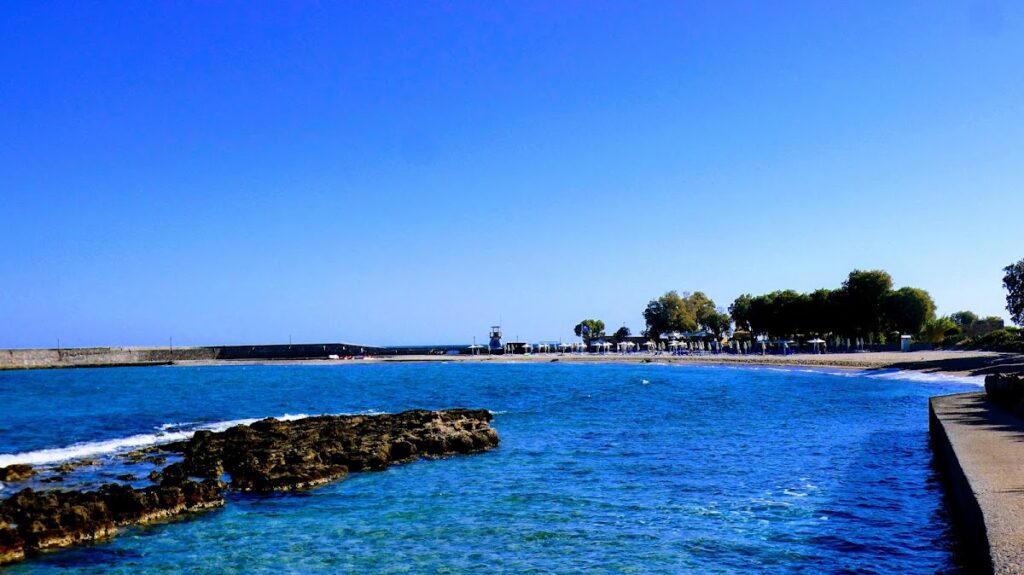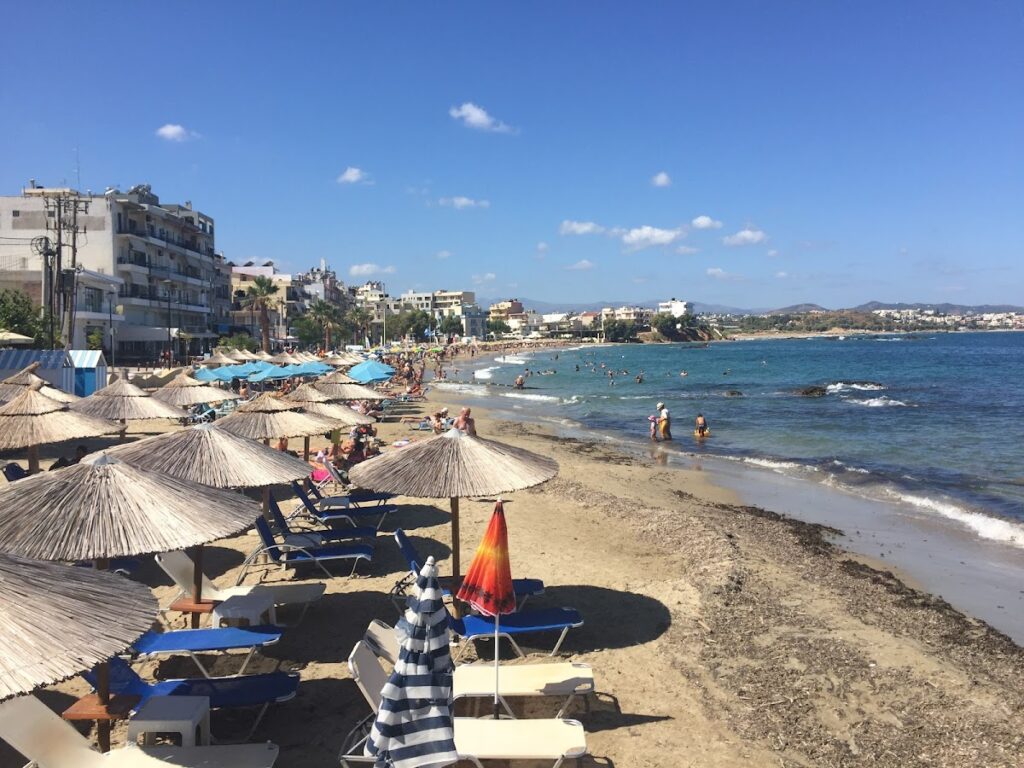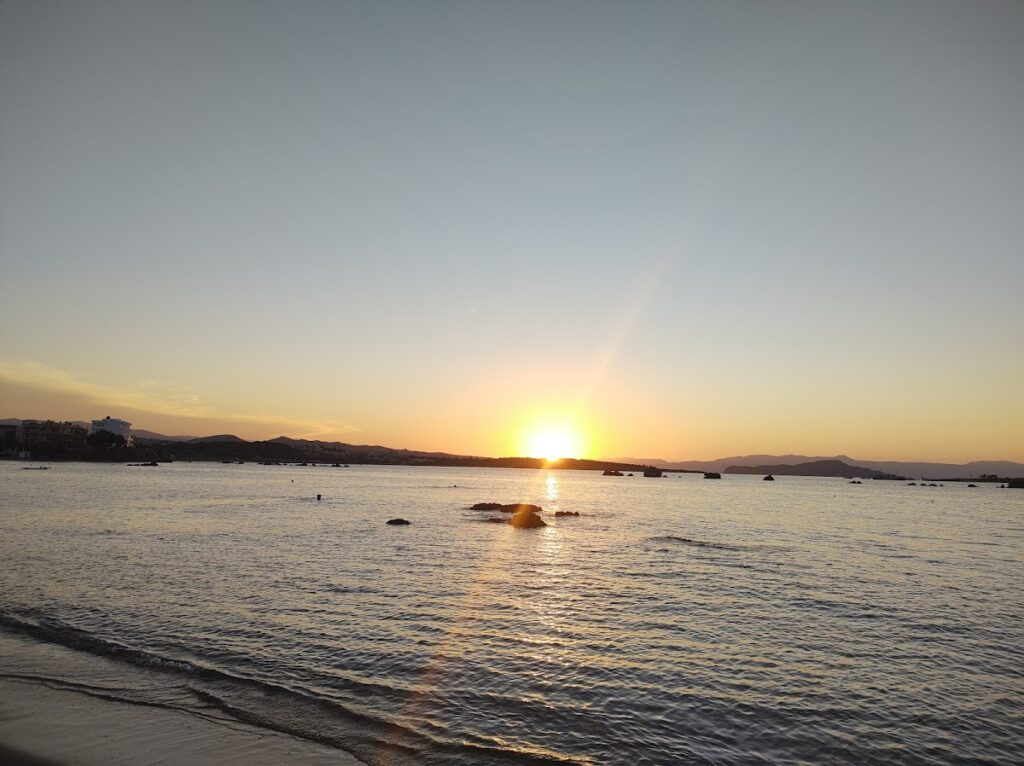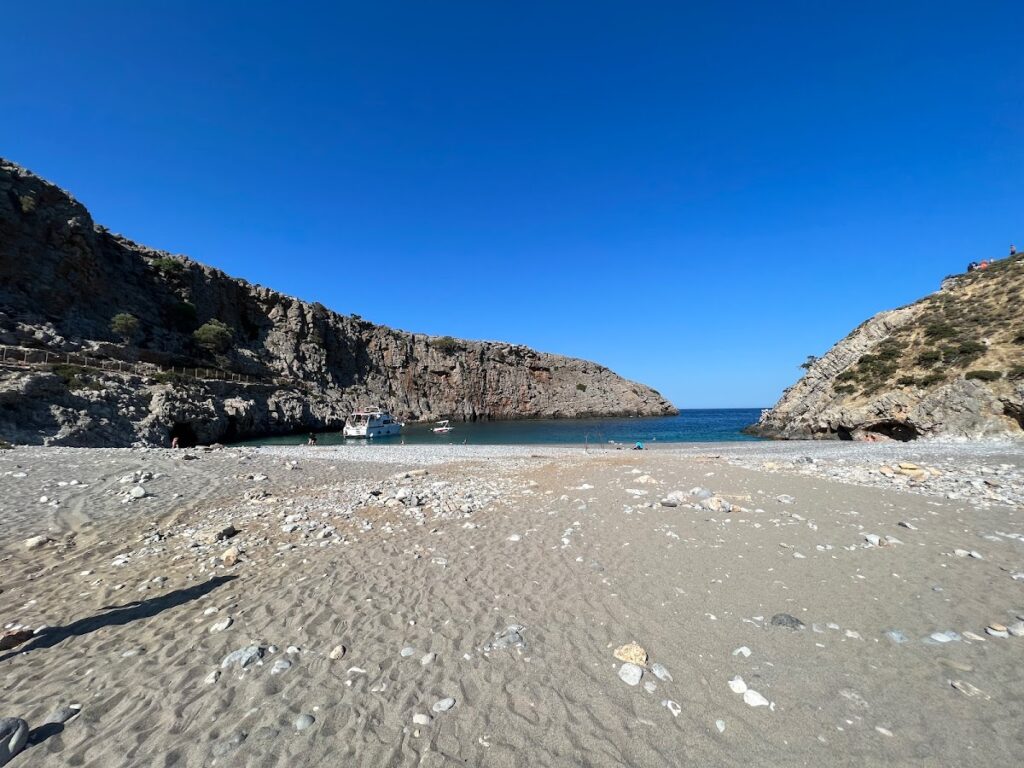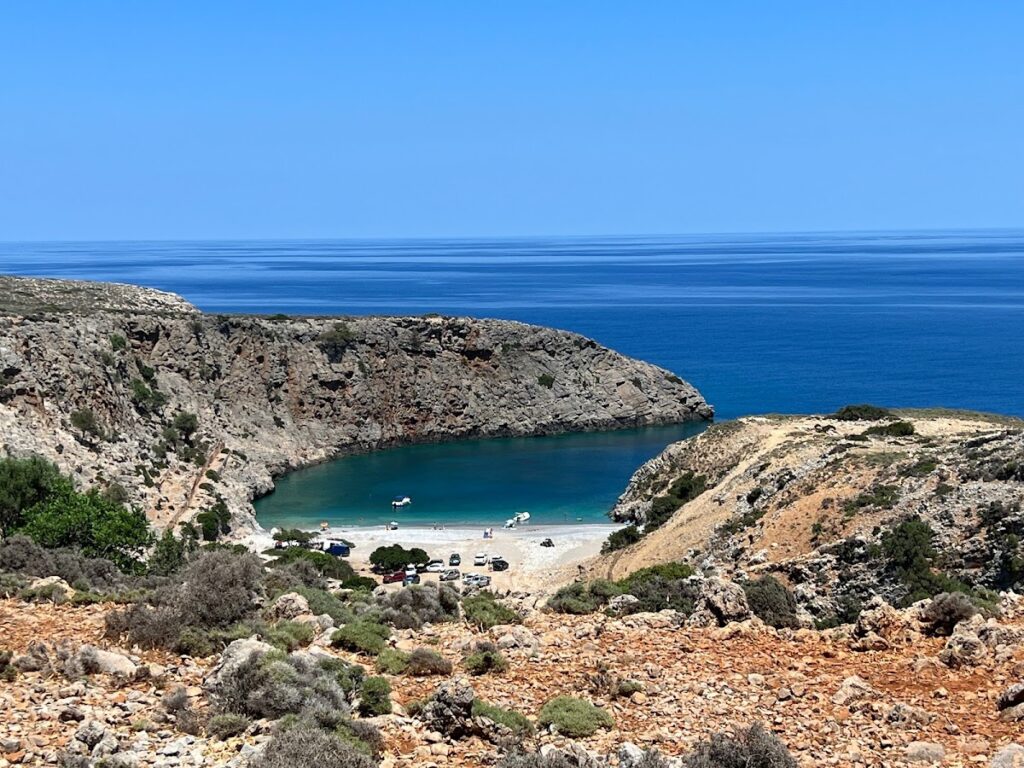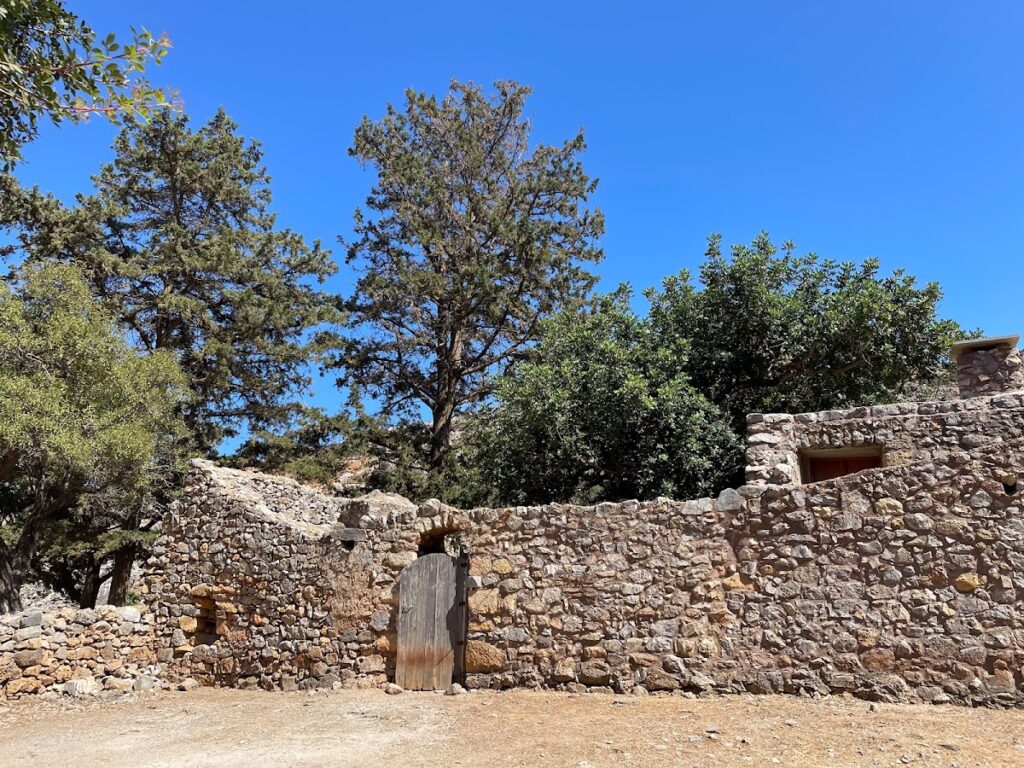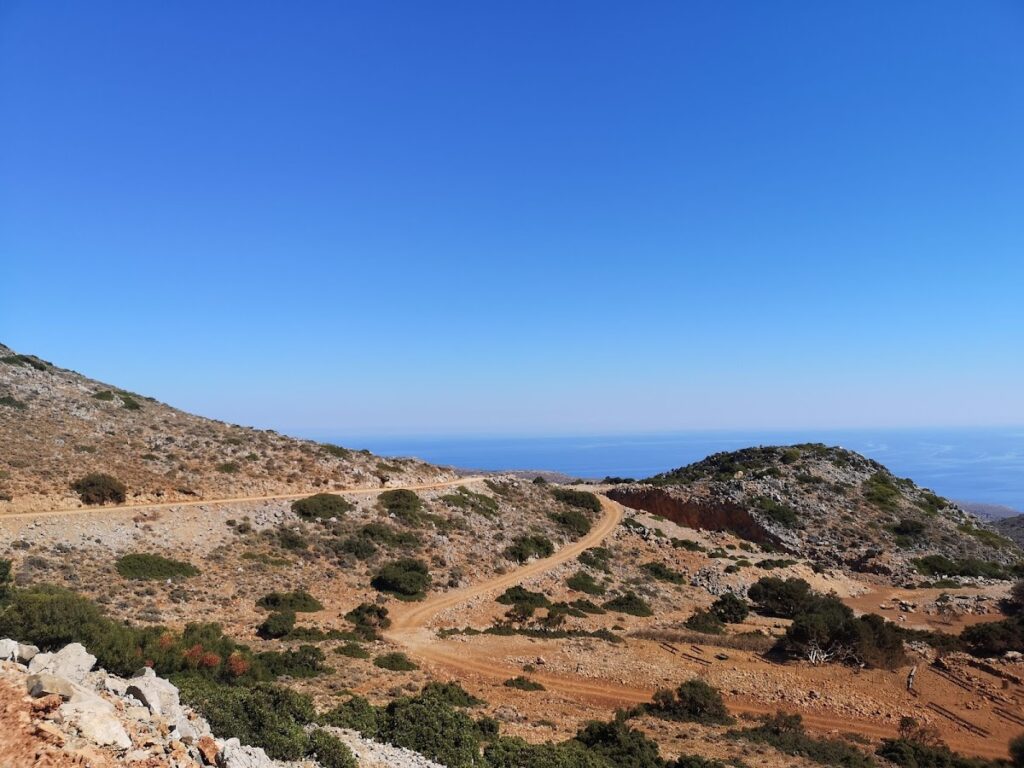Beaches with Blue Waters on Crete Island
Find a beach with Blue waters near you
Bathed in ethereal beauty and enveloped by the shimmering Aegean Sea, the island of Crete, Greece’s largest and southernmost island, is a haven for beach lovers.
With an impressive count of 297 cerulean, crystal-clear blue water beaches listed on our website, Crete’s coastline offers an unrivalled, heavenly escape into a world where turquoise waves gently lap against pristine sands. From secluded coves to bustling beach strips, each spot reveals a unique blend of natural splendour and cultural richness that make the Cretan beaches an idyllic sanctuary for relaxation, adventure, and exploration.
Dive into our comprehensive guide to discover each gem scattered along Crete’s diverse coastline, where the timeless charm of Greece meets the infinite blue.
- Paralia Schisma Elountas
- Sand
- Normal
- Blue
Elounda’s Skisma Beach is a picturesque sandy enclave, perfect for families. Its cleanliness and organization make it especially welcoming.
Little ones delight in its flat sandy terrain and the playground, while older kids gravitate towards the available water sports. Occasional winds result in bigger waves, offering simple surfing opportunities.
With convenient facilities like restrooms and showers, coupled with an array of nearby taverns, it’s an ideal spot for families with children.

- Beti Beach
- Sand
- Shallow
- Blue
Beti beach is nestled just a kilometre away from the bustling city of Agios Nikolaos, and a mere five-minute stroll from Almyros beach. This small slice of paradise often remains undiscovered by the typical crowd, providing an idyllic retreat for those in search of tranquillity.
This diminutive yet delightful beach, embraced by the natural landscape, boasts soft, sun-kissed sand that warmly greets your feet. Thanks to its sheltered location, Beti beach is often protected from the region’s wind and waves, making it a calm oasis amidst the vibrant surroundings. A visit to Beti beach gives you an opportunity to savour the serene ambience, far removed from the usual throngs of beachgoers, adding an element of seclusion to your Cretan beach adventure.
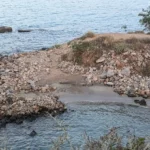
- Kimzou Sea Lounge Beach
- Fine Pebbles, White Sand
- Normal
- Blue, Deep blue
The charming Kimzu Sea Lounge isn’t just a fantastic bar, but also hosts an enchanting beach with shimmering white pebbles and sand, lapped by crystal-clear waters. The beach is located just 1 km away from Lake Voulismeni in Agios Nikolaos.
The beach offers full amenities, including an ample supply of sunbeds and umbrellas. Unique to this locale, visitors get to recline on lush, cool grass rather than hot sand, a delightful departure from typical beach experiences.
Despite its small size, the beach doesn’t usually feel crowded, offering ample space for all visitors. The water is shallow and inviting, making it particularly popular with families with young children. Strategically placed anti-wave blocks, about 120 meters off the coast, ensure the beach remains free of large waves, adding to its serene atmosphere.
Adjacent to the bar, a park provides additional recreation options, featuring a large children’s playground and a basketball court. It’s an idyllic spot for spending an entire day, from sipping on a rich Greek coffee in the morning, enjoying a delicious lunch and dinner, to toasting the day away with craft cocktails in the evening. The Kimzu Sea Lounge truly offers a comprehensive beach-bar experience.
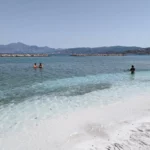
- Agii Pantes Beach
- Sand
- Normal
- Blue, Turquoise
Agii Pantes island is home to a quaint sandy beach situated just across the port of Agios Nikolaos. The beach, as well as the whole island, is accessible only by boat or via kayak or SUP departing from Ammoudi beach. It stands adjacent to the little islet Mikronisi, both acting as natural barriers safeguarding Agios Nikolaos. Moreover, the island serves as a habitat for several hybrid species of the endangered Cretan ibex.
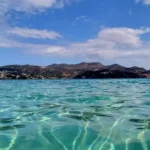
- Triopetra beach
- Fine Pebbles, Pebbles, Sand
- Normal
- Blue
Triopetra beach, nestled at the base of Mount Siderotas and 52km south of Rethymno, can be reached via paved roads leading from either Akoumia or Sachtouria. Part of the extensive Akoumiani Gialia beachfront, Triopetra got its name as a historical winter refuge for the inhabitants of Akoumia, who built small huts near their olive groves. Presently, most land and hotels in the area are owned by descendants of these Akoumia residents.
Triopetra boasts two distinct beaches, separated by a petite peninsula. The peninsula’s defining feature is the three spectacular rocks jutting out from the sea, giving Triopetra its name, which translates to “Three Rocks”.
The first beach, Small Triopetra or Koumado, resides in an enclosed bay lined with sand and rock to the south of the three rocks. Here, the Akoumianos river meanders into the sea, forming a natural boundary between Triopetra and the enchanting Agios Pavlos Sandhills at Cape Melissa. Small Triopetra hosts a handful of taverns and rooms, with umbrellas available for sun-seekers. Additionally, the southeast edge of the beach is home to a small harbour, known as Stomio or “mouth”, named after the river’s mouth meeting the sea. Just 1km northeast of the beach, the awe-inspiring chapel of Prophet Elias stands on a high hill, commanding an impressive view over Akoumiani Gialia.
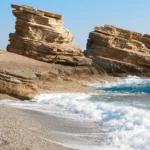
- Georgioupolis beaches
- Sand
- Shallow
- Blue
Georgioupolis, a small coastal town located 38km east of Chania and 21km west of Rethymnon, is a seaside resort nestled in a verdant valley crisscrossed by rivers and springs. Situated on the western edge of a sprawling 10km beach, the town’s beach spans 2km to the east, beginning at the Almiros river and terminating at Kavros beach, a natural continuation of the former. The beach in Georgioupolis is sandy, dotted with dunes, and has shallow waters.
The beach is well-maintained and child-friendly, with lifeguards on duty. Caution is advised during windy conditions due to sea currents. Amenities such as umbrellas, showers, and food and drink stalls are available for beachgoers. Approximately 700m east of the port, the Perastikos river bifurcates the beach, which then widens as it continues eastward. On the opposite end, west of Georgioupolis’s port and near the Almyros river’s exit, lies the picturesque Kalivaki beach.
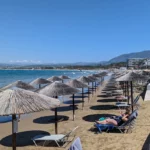
- Red beach
- Sand
- Normal
- Blue, Green
The Kokkini Ammos, or Red Beach, can be found 68km southwest of Heraklion and a short 800m from the popular resort of Matala. You can reach this hidden gem by following a clearly marked trail from Matala, which takes you over Kastri hill. While the trail includes some initial rock climbing and a steep descent at the end, it’s quite feasible. After a 15-25 minute walk from Matala, passing through a shepherd’s gate along the way, the breathtaking Red Beach comes into view. It’s an ideal spot for enjoying panoramic views and beautiful sunsets. Alternatively, you can also reach the beach by boat from Matala Harbour for a small fee of around 5 euros.
The beach is most noted for its red sand, a result of the area’s unique geology, which forms a stunning contrast against the bright blue-green sea. However, it’s important to note that it’s not shielded from the typical western winds in the region. The beach has minimal facilities, with a simple stone-wall coffee shop that opens occasionally offering food and drinks, and some umbrellas. It’s recommended to bring your own mats and umbrellas as the only natural shade is provided by a few tamarisk trees near the canteen.
In the 1960s and 70s, Red Beach was a popular spot among hippies, and its legacy continues with enthusiasts still visiting the beach regularly. Especially the northern part of the beach has gained a reputation as a nudist-friendly area and has gained international recognition for this. The beach and its surrounding area are protected by the Natura 2000 program due to its ecological importance.
The northern end of the beach features a long rocky limestone formation, similar to the limestone found in Matala. These rocks are decorated with carvings of Minoan and Egyptian sea figures, created by Gerard, a Belgian fan of Matala. These carvings have become a key part of the beach’s appeal. Between Matala and the Red Beach, there’s a large rock known as Theosini that offers stunning views of Messara Bay. This rock has been eroded by the sea, creating a marine cave known as Kouroupi, which can only be accessed by boat. The cave is a haven for endangered Mediterranean seals and various species of wild pigeons.
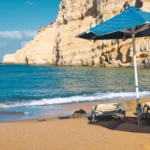
- Hersonissos beaches
- Sand
- Shallow
- Blue
Hersonissos, a bustling tourist hotspot in Crete situated just 28km to the east of Heraklion, is renowned for its tranquil beaches and calm seas – a rarity along the northern coast of Crete due to the prevailing northern winds. The most serene beaches can be found to the west of the port, shielded by the Cape Sarandaris. Towards the east of the port, however, lie the resort’s most frequented beaches.
As you venture east from the port of Hersonissos, the first sight to greet you is a sprawling, narrow, sandy beach, buzzing with throngs of beachgoers. It’s impeccably organized and conveniently close to the city’s amenities, though it may not be the best choice for those seeking a more serene environment.
Journeying further east, a series of small, sandy coves become apparent, primarily situated in front of hotels. Of these, Silva Maris Beach stands out with its high level of organization, a lifeguard, and numerous facilities. Continuing eastwards, you’ll encounter Star Beach, one of Crete’s most populous beaches, largely patronized by British and Dutch tourists. Lastly, near Cape Drapanos lie the peaceful beaches of Eastern Hersonissos, offering a quieter seaside experience.

- Plakias beach
- Sand
- Shallow
- Blue
Situated 36km to the south of Rethymno city, Plakias is a charming tourist haven nestled at the mouth of a fertile valley just beyond the Kouroupa range, where the Kotsifos river meets the sea. It owes much of its popularity to the impressive Gialia beach, stretching for 1.3km from the edge of the town to the east, ending at Cape Mouri. This fully-equipped beach, characterized by its crystal-clear, cool waters, is an ideal location for leisurely walks or cycling along the adjacent road. It features numerous hotels and restaurants, as well as beach essentials such as umbrellas, water sports facilities, beach volley courts, snack bars, changing rooms, and showers.
Paligremnos, the eastern portion of the beach, boasts fine sandy shores and is well-appointed with various amenities close to local accommodation and eateries. Noteworthy are the tall, vertical cliffs nearby that prove to be a magnet for climbing enthusiasts. This spot, also known as “Gonates” (knees), is steeped in local lore; it’s said that the epic hero Digenis knelt here to drink from a local spring. An intriguing phenomenon takes place here every full moon from September to January, as the moon’s reflection on the sheer cliffs draws large squids to the beach, which locals catch with long sticks. A few meters south of Paligremnos, you can also discover tunnels once used for transporting coal to waiting cargo ships.
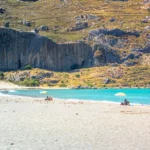
- Stavros beach
- Sand
- Shallow
- Blue, Green
Stavros beach is situated 17km northeast of Chania on the farthest point of Cape Akrotiri, is known for its distinct, camel-shaped mountain, Vardies. This towering landmark gained recognition in the film “Zorba the Greek” as the backdrop for Anthony Quinn’s iconic Sirtaki Dance in 1964. Once a quaint fishing hamlet, Stavros has since transformed into a bustling tourist hub, complete with numerous hotels and top-tier tourist facilities. The area’s popularity is further boosted by its two stunning beaches.
The primary beach lies to the village’s east, nestled at the base of the Vardies mountain and adjacent to the scenic harbour. It forms a protected, semi-circular lagoon with pristine white sands and shallow, turquoise waters. The contrast between the rugged mountain and the tranquil beach provides a unique and enchanting swimming experience. As anticipated, the beach is well-equipped with all the necessary amenities.
200 meters northwest of the main beach, you’ll find Stavros’ secondary beach, a mix of sandy stretches and rocky areas. It’s less developed and cleaner than its counterpart, but its exposure to the elements can lead to wavy seas. The peninsula separating the two beaches holds historical significance, housing remnants of an ancient quarry that provided limestone for Chania’s Venetian-era Walls (13th- 17th century).
Beyond beaches, Stavros offers an array of other services including accommodation, eateries, mini markets, shops, cafes, and regular bus connections to Chania city.

- Matala beach
- Fine Pebbles, Sand
- Deep
- Blue, Green
The beach of Matala is situated 68km southwest of Heraklion, where the Messara plain and Asteroussia Mountains intersect. It is one of the most frequented tourist spots in Crete and the most well-known beach in the southern region of the Heraklion prefecture. Matala is notable for its rock-carved caves and its association with the hippie culture of the 1970s. It lies in close proximity to Phaestus, the second largest palace of the Minoan civilization, having once served as its port. During the era of the Romans, Matala transformed into a port for Gortyn.
Nestled at the end of a small valley, Matala overlooks an enclosed bay with a picturesque view of the Paximadia islands. The beach spans 300m and features beautiful sandy shores, fine gravel, and crystal-clear deep waters. However, parts of the seabed, particularly the central area, are quite rocky and waves are common due to frequent westerly winds. A large cave can be found on the northern part of the beach, from which some thrill-seekers dive.
Matala beach is well-equipped with amenities such as umbrellas, restrooms, showers, lifeguards, first aid facilities, beach volleyball courts, snack bars, water sports, excursion boats, and a camping site. The surrounding area of Matala offers a range of accommodation, dining, and entertainment options. The beach is largely shaded by tamarisk trees, providing a respite from the sun. Come evening, the beach bars are brimming with people, both locals and tourists. The internationally acclaimed Matala Festival draws large crowds every June.

- Vai beach
- Fine Pebbles, Sand
- Shallow
- Blue, Green
Vai beach is located 94km east of Agios Nikolaos and 24km east of Sitia. It is the most famous beach in east Crete, as its main feature is the large palm grove with the Cretan Date Palm (Phoenix theophrasti). Its name derives from the word vai, meaning palm in Greek. The palm grove is the largest in Europe with approximately 5000 trees, while there are smaller colonies in other parts of Crete and in Southwest Turkey. According to the legend, the trees have grown from discarded date stones thrown into the sea by Saracen pirates. However, the palm grove is more than 2000 years old and the pirates are more recent. Thus this hypothesis has changed and the Saracens have been replaced with Phoenicians, that governed the Mediterranean Sea 20 centuries ago.
The heavenly palm grove is planted in a wide valley watered by the local river for centuries. An exotic sandy beach with whitish sand is formed near the shore, backed by the Edenic palm forest, reminding of African and Caribbean seascapes. The entire region is owned by the powerful Toplou Monastery, which is the largest landowner in eastern Crete. The 15th-century monastery is built like a fortress and hosts a great collection of Byzantine icons.
Vai was totally unknown until the early 1970s, when a popular commercial for the Bounty chocolate with coconut was filmed here, using the magical background of palm trees. In the advert, coconuts were falling from trees, however, Vai palms produce dates. Consequently, coconuts had to be falsely hung to create the right impression. The ad made this unknown earthly paradise renowned throughout the world. Thus, hundreds of hippies started to stay here on their holidays. In the 1980s, when hippies faded out, Vai was invaded by backpackers and rapidly degenerated into a rubbish-strewn campground. The palm grove was consequently fenced off and proclaimed a conservation area, being open to the public only during daylight.
The beach has whitish sand and flat turquoise waters. In a few places, there are slippery smooth rocks, while on the opposite there are small islets that beautify the landscape. The beach is slightly organized (whatever the protection scheme allows) with umbrellas, showers, water sports and a canteen. The closest rooms to let are located outside the protected area (15′-25 ‘walk). If you want to stay isolated, there is a lovely sandy beach 5 minutes north of Vai, while another option is the idyllic Psili Ammos beach in the south.
If you come by car then you should leave it in the parking area. There are also buses running from Sitia and all travel agencies in Crete organize daily tours. The only drawback of Vai is that from the first moment you think that someone wants to dip into your pocket. Indeed, prices for parking, umbrellas and the canteen are too high. However, Vai is one of the most special beaches in Crete that surely deserve a visit.
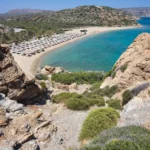
- Preveli beach
- Sand
- Normal
- Blue
Nestled approximately 35km to the south of Rethymno and 10km east of Plakias, you’ll find Preveli Beach, also known as Lake Preveli or Phoenix. This gem lies where the majestic Kourtaliotikos Gorge meets the flow of the Grand River (Megalos Potamos). Recognized as the most celebrated beach in southern Crete, it has been a summer haven for countless visitors and was a preferred spot for hippies in the ’60s and ’70s.
In this oasis, a lush colony of Theophrastus palm trees flourishes along the banks of the Grand River, evoking a tropical paradise. The river culminates in a 500m long lake before joining the sea, providing year-round water. You can saunter under the canopy of the palm and other trees, following the river as it ascends through the stunning canyon, and take refreshing dips in the cool pools within the gorge.
In 2010, a major fire devastated this tropical paradise, but remarkably, the palm grove has mostly rejuvenated. At the river’s exit, a beach of pebbles and sand stretches out, where the seawater remains refreshingly cool due to the river. A striking heart-shaped rock adds charm to the eastern section of the beach. Since the area is protected, the beach remains unspoiled, with no parasols.
Venturing to Preveli Beach:
Two main routes lead to Preveli, either from the west or east. One option is driving from Plakias towards the Preveli Monastery, and 1.5km beyond the Kato Monastery of Preveli, you’ll find a spacious car park. Here begins the path descending to the beach. This parking spot offers an extraordinary viewpoint from the towering cliffs to the west, perfect for capturing stunning photos. It’s a 15-20 minute walk to reach the beach, but be prepared for a strenuous climb back up.
An alternative route to avoid the steep ascent involves driving along the paved road to nearby Drimiskiano Amoudi and taking a brief 5-minute walk to Preveli. However, this route doesn’t offer an impressive cliff-top view. You can also opt for a boat ride to Preveli from Agia Galini and Plakias.
The beach owes its name to the nearby historic Preveli Monastery, a male-only monastery established in the 16th or 17th century, dedicated to St. John the Theologian. The old and new monasteries, known as Piso and Kato Monastery respectively, are situated in the vicinity. The former, now deserted, is located just south of the ancient Preveli stone bridge.
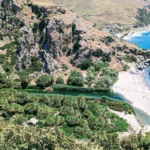
- Stalida beach
- Sand
- Shallow
- Blue
Stalida Beach (or Stalis) is located 30km east of Heraklion, between Malia and Hersonissos. Originally a small seaside village formed by the inhabitants of Mochos, it has now evolved into a bustling tourist destination, harmoniously blending into the neighbouring town of Malia. Stalis caters primarily to families seeking a tranquil retreat, and is beautifully equipped with a range of accommodations, eateries, bars, and taverns, not to mention an ATM and a pharmacy for convenience.
Stalida makes for a perfect base to explore the nearby attractions and engage in an array of activities. The locality is teeming with stunning beaches, enriching archaeological sites, and captivating cultural spots. A short 6km trip from the beach takes you to the Aquaworld Aquarium & Reptile Rescue Centre – a place where you can acquaint yourself with a variety of marine creatures and reptiles. Nearby, the Lychnostatis Open Air Museum offers a deep dive into Crete’s natural history and culture.
For those seeking aquatic thrills, the Acqua Plus waterpark, the island’s largest, is not far from the coastline. To the west, beyond Malia and Potamos Beach, lies the Malia Palace Archaeological Site, home to the third largest Minoan palace complex and steeped in millennia-old history. A further 20km south, the ancient Minoan settlement of Karfi offers another slice of history, believed to have been home to around 3,500 inhabitants.
For those with a passion for hiking, the Bulgarian trail, starting from Stalis and leading up to Mohos, is a must. Named after the Bulgarian prisoners of war who constructed it during WWII, this 5km trail, though lengthy and ascending, is an experience in itself. Along the way, you’ll cross a pedestrian bridge spanning the highway and encounter the contemporary Panagia Theogenitor Monastery. Once in Mohos, enjoy a leisurely stroll along narrow lanes, relax with a coffee in the spacious square, and enjoy the warm company of the locals. You can choose to return via the same trail or follow a different one leading from Mohos to Malia.
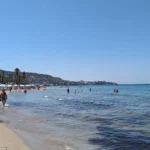
- Karteros beach
- Sand
- Shallow
- Blue
The Karteros Bay, situated at the exit of the synonymous Karteros Gorge, lies 7km east of Heraklion and stretches 3.5km to the east. It pays homage to the Byzantine General, Krateros, who in 824AC attempted to liberate Crete from the Saracens by landing his ships on the bay’s beach, but unfortunately, he was defeated. The bay encompasses two villages, Karteros and Amnissos, which have now merged due to the area’s rapid evolution. The area’s development can be attributed to its proximity to Heraklion and the presence of an exquisite beachfront featuring fine golden sand.
You’ll find numerous hotels, eateries, and beach bars in close proximity to the bay. Karteros Bay is exposed to the northern winds, and as a result, the water tends to be wavy. The water is shallow with almost no rocks, except for a few areas. The least crowded part of the beach is situated next to the “Nikos Kazantzakis” airport, 7km west of Heraklion, known as Florida. This part got its name from an old tavern that no longer exists and is the most serene of all the beaches. Compared to the easternmost beaches, Florida has fewer umbrellas and facilities. The river from the Karteros Gorge empties into Florida, creating a small wetland on the beach, which dries up during the summer. It’s certainly worth a visit, especially in the spring.
While in Florida, you should stop by the old Church of St. John and St. Nikon Metanoite, constructed within a large cave. Moreover, don’t be startled if you spot horses on the beach as it’s home to the Heraklion Riding Club.
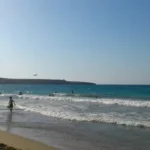
- Almyros beach
- Sand
- Shallow
- Blue
Almyros beach (Almiros) is located 2.5km south of Agios Nikolaos and 12 km from Elounda. It is shaped near the exit of Almiros River, which empties on the south part of the beach. Next to the beach, the protected wetland of Almiros hosts several rare birds, towering eucalyptus trees, reed and some palm trees.
The beach is quite long – 300 m – and very well-organized. It is sandy and the water is shallow and usually calm, making it ideal especially for young children. There are a lot of trees behind the beach, and to the east, you can see the pretty Thrypti Mount. The entrance to the water is very smooth. This beach is suitable for different categories of people, lonely travellers, relaxation getaway lovers, families with children, seniors etc. It is partially crowded during the high season. The area has a few canteens, while there are also many options for water sports. The sea water is very cold in some places due to the river that flows all year round. On the south side of the beach, there are small hotels and apartments.
To reach the beach from Agios Nikolaos city centre, if you do not have a car, you should walk the pedestrian street (5 ‘) which runs along the rocky coasts north of the beach. The pathway starts from Gargadoros beach, which is located 5 minutes south of the town’s marina.
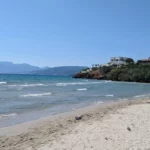
- Ligres beach
- Fine Pebbles
- Normal
- Blue
Situated 51km to the south of Rethymno and 7km below the village of Kerames, Ligres is nestled at the base of the grand Siderotas mountain. It forms the northern segment of the Akoumiani Gialia beachfront, which runs from the cape of Mellissa to the south.
Ligres is an expansive beach graced with rough sand and a spectacular deep sea. Its somewhat challenging access has thankfully deterred the encroachment of tourism, preserving it as one of the most serene, secluded and pristine beaches on the island. Although the beach is not developed, there are a few taverns and rooms available on its western side accessible via a poorly maintained asphalt road. At the beach’s western tip, there is a stunning waterfall that boasts a year-round water supply, cascading right next to the sea.
Beyond the northern end of the beach, also known as Katsouni, lies a secluded beach favored primarily by nudists. Despite its seclusion, there are numerous spots along this vast, uninhabited beach where nude swimming is possible. It’s worth venturing along the beachfront to Triopetra, up to the Xiromilia area, to marvel at the astonishing rock formations. In the heart of Ligres, a remarkable reddish boulder stands out near the sea.
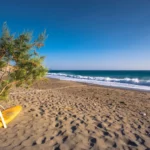
- Myrtos beach
- Fine Pebbles, Sand
- Normal
- Blue
Myrtos, a quaint seaside village, lies 13km west of Ierapetra where the River Kryos meanders through the stunning Sarakina Gorge and into a valley abundant with greenhouses and citrus groves. Despite recent mild development, Myrtos has retained its traditional charm. Its appealing beaches, characterized by coarse grey sand that doesn’t stick to the skin, have amassed a global following. The village offers small hotels, bars, cafes, restaurants, supermarkets, a gas station, and a clinic, in addition to a nearby pharmacy and accessible bus route to Ierapetra.
The extensive beach, considered among the finest in southern Crete, is ideal for serene family vacations as it’s sheltered from strong winds. According to locals, Myrtos is where the wind never rages. The beach is well-equipped with lifeguards, umbrellas, showers, changing rooms, cafes, restaurants, water sports, and beach volleyball. As you head west, the beach widens and offers even more tranquility.
Take a leisurely stroll around Myrtos’ local harbor or wander through its traditional narrow streets filled with lush gardens and homes that echo Aegean landscapes. The surrounding nature and gorges are also worth exploring. Notably, you can visit two Minoan settlements, Fournou Korifi (near Nea Myrtos) and Pirgos (on the east shores of the River Kryos), which were uncovered during excavations. The Archaeological and Folk Art Museum of Myrtos, situated next to the old church of St. Anthony, is a point of interest. Lastly, a monument in the village commemorates the 18 victims who were executed by the Nazis in 1943 as retribution for the deaths of two Germans in the neighboring village of Symi.

- Sitia beach
- Sand
- Shallow
- Blue
Situated 64km east of Agios Nikolaos, Sitia is the furthest city to the east on the island of Crete. In the broader region of the Sitia province, there are numerous petite beaches that offer a delightful combination of sun and sea. For those who enjoy staying near the urban area, the city’s long beach is an attractive option. Situated to the east of the city, Sitia beach stretches from the port all the way to the Petras area. The beach, largely composed of sand with some pebbles scattered here and there, has shallow waters. It is well-equipped with amenities such as umbrellas, showers, lifeguards, beach/water sports, and beach bars. However, quiet spots can be found along its extensive shoreline, particularly towards the east. The east side also accommodates campervans and is dotted with a few trees.
Beyond the Petras area to the east, you can explore the ruins of an ancient city at Trypitos Cape, alleged to be Itia, the hometown of the Wise Myson. Moreover, archaeologists have discovered remnants from various phases of the Minoan era in Petras. West of Trypitos’s archaeological site, another small beach named Karavopetra is located. This name translates to “Ship Stone”, inspired by the sea boulder where ships would traditionally anchor.
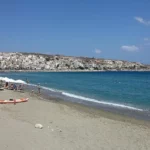
- Fragokastelo beach
- Sand
- Shallow
- Blue
Frangokastello, meaning “Castle of the Franks”, is a renowned beach in Western Crete, steeped in history and folklore due to its age-old Venetian castle and the intriguing legend of the Drosoulites ghosts. This beautiful beach lies in a valley at the foot of the White Mountains, situated 13km east of Hora Sfakion and 80km southeast of Chania.
Fragokastelo’s main beach is an appealing spectacle with its sandy shoreline and shallow turquoise waters, a perfect setting for children and families. Despite being well-equipped with amenities and buzzing during the summer months, the beach is sometimes subject to bothersome northern winds that sweep the sand. However, the area boasts plenty of accommodations, dining options, shops, and an ATM, with the nearest hospital located in Sfakia.
To the west of the main beach, the expansive Vatalos beach and a significant wetland (in winter) offer a different experience, with a mix of sand, pebbles, and rocks perfect for snorkelling. A short 300m walk to the east from the main beach leads you to the breathtaking Orthi Ammos beach, renowned for its sand dunes.
Accessing Fragokastelo from Crete’s northern coast requires a drive along the National Road connecting Chania and Heraklion, exiting at Vrysses and following the road to Chora Sfakion (Sfakia). This route takes you across the Askyfou plateau and through the stunning Imbros Gorge to the southern coast of the Sfakia province. Fragokastelo is well-signposted from here, and the journey typically takes around 1 hour and 20 minutes. If you’re coming from Rethymnon, take the road to Plakias, then head east to Rodakino before reaching Fragokastelo. This drive is around one hour and provides a less challenging but also less scenic route than through the Imbros Gorge. Alternatively, buses to Fragokastelo are available from Chania.
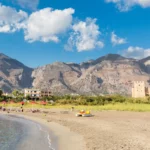
- Potamos beach - Heraklion
- Sand
- Shallow
- Blue
The primary beach of Malia, situated in the heart of the town, is often teeming with visitors. As a result, those seeking a break from the hustle and bustle tend to head towards the sandy stretches to the east of Malia’s port, conveniently located near the Palace of Malia. The most easterly of these beaches is named Potamos (meaning River), due to a small stream that flows along its eastern edge, adjacent to Malia’s wetlands.
Potamos is a lengthy, sandy expanse that is well maintained, yet typically less populated than Malia’s main beach. The eastern portion of the region remains relatively untouched due to its archaeological significance. However, to the west of the beach, a number of hotels can be found, each boasting its own sandy cove.
The Malia Swamp is a wetland of unparalleled ecological importance, home to an expansive reed bed that provides habitat for numerous bird species. This area also preserves several types of coastal vegetation that have been lost elsewhere on Crete. The entire area is irrigated by water that flows from Mount Selena, forming a stunning river in the winter months, mere meters from the shore, resulting in crystal clear waters that feed into Potamos beach. The sea here is so fresh, locals can even drink from it! It’s not an uncommon sight to see goats descending from the mountain, swimming in the sea and drinking the water due to its fresh scent. Surrounding Potamos are smaller sand dunes, which come autumn, are adorned with stunning white sand lilies.

- Gouves beaches
- Sand
- Shallow
- Blue
Kato Gouves, often referred to as Gouves, is a sought-after holiday destination nestled 18km east of Heraklion, at the base of Mount Ederi. Historically, the valley of Kato Gouves was a fertile ground for vegetables, olives, and cereals, cultivated by the inhabitants of Ano Gouves. Today, it’s been transformed into a tourism hub, featuring numerous hotels. Unlike the bustling resorts of Malia and Hersonissos nearby, Gouves offers a tranquil vacation experience, making it an ideal spot for families and the elderly. The sandy beaches here are loved by families, and are conveniently close to all necessary amenities.
Gouves beach is well-equipped with facilities such as umbrellas, sunbeds, lifeguards, water sports, and diving centres, alongside showers and changing rooms. The sea, featuring fine sand and shallow waters, is exposed to the common north winds. As a result, there are several small piers and marinas in the vicinity where you can enjoy a swim, shielded from the waves. The coastal road of Gouves runs parallel to the coastline, simplifying the task of locating your perfect beach spot! Enjoy an evening stroll on this road while admiring the sunset. The road also boasts numerous cafes and restaurants, offering panoramic sea views. Furthermore, Gouves’ main road houses a number of supermarkets, shops, pharmacies, clinics, and ATMs.
One must-visit spot is the Church of St. Constantine, nestled in a quaint pine forest adjacent to the sea. Its picturesque seaside location makes it a popular wedding venue, especially for couples from Heraklion. If your visit falls on a Saturday, you’re likely to witness a traditional Greek wedding or baptism. Beyond the shoreline, 2km to the north, lies the village of Ano Gouves. Its narrow streets, churches, and coffee shops exude a traditional charm. Further north, you can explore the Cave of Agia Paraskevi near the village of Skotino. To the east, Mount Ederi stands tall, home to radars used by the Americans for the operation of the erstwhile US air base in Gournes.
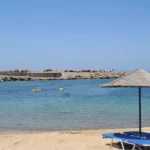
- Stalos beach
- Sand
- Shallow
- Blue
Situated 7km west of Chania, nestled between Kalamaki and Agia Marina, lies Stalos. This well-developed location magnetizes a significant amount of tourists each summer. The coastal region of Stalos, known as Kato Stalos, boasts a stunning sandy beach that is not only well-equipped but also provides all necessary touristic amenities. This makes it a yearly recipient of the coveted blue flag award.
Situated 150m to the south is Pano Stalos, a charming traditional village that is enveloped by lush green hills and striking rock formations.
Stalos serves as a perfect holiday destination due to its proximity to the city of Chania and its ability to cater to all the needs of its visitors. There are also frequent bus services to the city of Chania.
The name ‘Stalos’ is steeped in Cretan mythology, believed to be derived from Talos, a bronze giant who guarded the island from enemies by circling it thrice daily. Legend has it that Talos had his base in Stalos. However, it is more likely that the name ‘Stalos’, originates from the Greek verb stalizo, meaning to stop for rest. This is where local shepherds would halt with their flocks for rest, hence the English word ‘stall’ shares the same Greek roots.
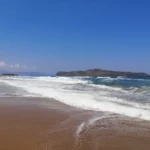
- Platanias beach
- Sand
- Normal
- Blue
Platanias, a coastal hamlet situated 11km west of the city of Chania, has seen a significant surge in tourism in recent years, transforming it from a quaint village into a bustling suburb of Chania. Its close proximity to the city, coupled with its stunning beach and frequent bus services from Chania, have made it the most favoured beach near the city. The original village, nestled on a hillside, offers a breathtaking view of the sea and the islet of Thodorou.
The beach in Platanias is an attractive stretch of sandy shore dotted with hotels of varying class and standard tourist facilities. Beachgoers can avail of all the amenities typical of well-organized beaches, including beach bars, umbrellas, showers, snack bars, lifeguards, and water sports. On the eastern side of the local harbour, near Agia Marina, swimmers can enjoy several small, man-made coves. In the summer, the area’s nightclubs come alive, hosting thousands of both Greek and foreign party-goers who dance until daybreak.
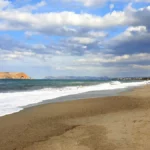
- Damnoni beach
- Sand
- Shallow
- Blue
Situated 35km south of Rethymnon and 5km east of Plakias on Crete island, Damnoni beach is a well-known tourist destination. The resort is fully developed and well-structured, featuring a wide bay with turquoise waters and coarse, whitish sand. Visitors can enjoy numerous facilities including umbrellas, snack bars, showers, changing rooms, and water sports. Additionally, there’s a scuba diving centre, top-notch hotels, restaurants, and a horse-riding centre.
The westernmost part of the beach, which is highly organized, is home to a small river that maintains water nearly all year round. The eastern end of the beach is more serene and connects to the neighbouring Ammoudakii beaches via a short unpaved road. Beyond the western end of the beach, you’ll find several secluded small coves with sand and rocks, located right next to the area’s small harbour.
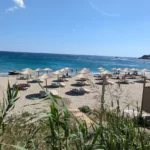
- Chrissi Akti beach
- Sand
- Shallow
- Blue
Situated 2.5km west of Chania city and just east of Agii Apostoli, you’ll find the glistening Golden Beach, or Hrissi Akti as it’s known in Greek. It’s essentially two sandy beaches separated by a rocky outcrop. The western cove is the primary Golden Beach, while the eastern one is the quieter Aptera beach. The west bay is the more popular of the two, boasting excellent facilities such as umbrellas, lifeguards, showers, cafes, water sports and more. Its fine golden sand and shallow waters are particularly appealing to families with young children, and there’s even a playground nearby.
Aptera beach, on the other side of the rocky divide, offers a more tranquil experience. It’s less developed and has the remnants of the Aptera Beach hotel which was abandoned in the late 90s due to financial difficulties. This beach is perfect for those looking for solitude and is conveniently close to Chania.
The entire Agii Apostoli area is dotted with small parks filled with pine and eucalyptus trees. Access to Golden Beach is easy, either by bus from Chania or by foot.
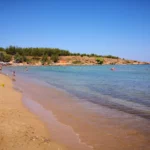
- Kaminaki beach
- Pebbles
- Normal
- Blue
Kaminaki Beach, a secluded pebbly beach ideal for fishing, is situated 58km south of Heraklion, on the southeastern fringes of the Asterousia Mountains. The rugged mountains surrounding the beach create a quintessentially Cretan landscape, featuring hard-to-reach gorges, bare rocks, steep cliffs, and isolated beaches mostly reachable by boat. The beach lies at the end of the wild Perivoliano Gorge, also known as Gerontzou.
Access to Kaminaki Beach is primarily via sea, given the difficulty in descending the gorge and the beach’s distance from the nearest road. The closest harbour can be found 3km west in Treis Ekklisies. A smaller beach located 400m west in the Agio Pnevma area is not as aesthetically appealing as Kaminaki.
On the opposite side, a striking beach with turquoise waters and a unique Δ-shaped sea cave can be found 700m east of Kaminaki. The beach is nestled in the embrace of Alykevra Bay, at the Sfakidia location, and is well-shielded by Cape Alykapounda. Heading west beyond Alykapounda Cape, you’ll find Alykevra, where a small rocky bay houses a freshwater spring. This spring was historically used by local shepherds to quench their flocks’ thirst. The area of Alykevra features a single beach situated at the mouth of a narrow canyon at the Prikovlyhada location. Despite its small size (1.5m in width), the pebble beach of Prikovlyhada is exceptional, with the canyon walls providing sunshade and nearby caves adding to its charm.
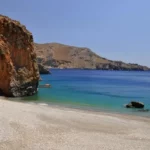
- Sissi beaches
- Rocks in places, Sand
- Normal
- Blue
Sissi, also known as Sisi, is a tranquil traditional seaside village nestled 26km west of Agios Nikolaos and 41km east of Heraklion, not far from Malia. The village is renowned for its natural harbour, characterized by tranquil deep green waters, and its charming taverns nestled within narrow streets. The Sissi coastline is predominantly rocky, with only a few sandy stretches. The sea around here is typically choppy, making the only calm swimming spot the small beach within the harbor (Limani). This petite beach offers a few umbrellas and showers for visitors.
If you desire to explore other beaches, you can travel east to Harkoma bay, home to the well-kept Boufos beach. This sandy beach is exposed to the wind. Adjacent to it, you’ll find the smaller Avlaki beach, situated at the exit of a narrow bay.
Moving further east, you’ll find the sandy Kalimera beach, located in front of the Kalimera Kriti hotel. Managed by the hotel, the beach is well-organized and boasts of shallow waters, making it perfect for children. On the opposite side of the hotel is Spiliada, the last beach within the Sissi territory. Spiliada is a sandy beach shaded by numerous tamarisk trees, offering a more peaceful atmosphere compared to the other beaches.
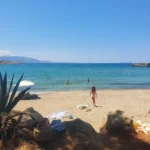
- Nea Chora beaches
- Rocks in places, Sand
- Shallow
- Blue
Nea Chora, a picturesque sandy beach, lies just a kilometer west of Chania city center along Akti Papanikoli Street, opposite the Lazaretta islet. A short 15-minute stroll from Chania’s old harbor, this beach boasts a well-maintained main area with several facilities at hand. While mostly sandy, Nea Chora also features rocky patches. It’s the perfect spot for those who prefer to stay nearby the city center. East of the beach, you can still spot the old soap factory’s towering chimney and the former sanatorium of Chania. Nea Chora is a favorite among locals for its seafood taverns, but there are also plenty of restaurants, snack bars, and cafes to choose from. Every summer, the beach hosts the “Sardine Festival”, complete with traditional music, dancing, and free fish for attendees.
Kladissos beach
Further along the river Kladisos, a second beach unfolds all the way up to Aptera beach. Kladisos beach is a lengthy sandy bay, interspersed with pebbly areas. Despite its proximity to Chania and its appealing beauty, the beach remains relatively secluded and unspoiled. The simplest way to access this beach is by crossing the Kladisos river via the pedestrian bridge.
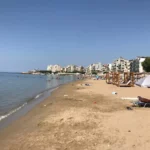
- Menies beach
- Fine Pebbles, Pebbles, Rocks in places
- Normal
- Blue, Deep blue
Menies, also known as Diktynna, is situated 45 kilometers northwest of Chania, on the northeastern coast of the Rodopos Peninsula and at the mouth of the Foundas Gorge. This secluded beach is characterized by its pebbles and the deep, crystal blue of its waters. Protected from the prevalent winds in the region, Menies offers a haven of solitude, far from the hustle and bustle of city life. With no signs of modern civilization for miles, visitors are advised to come prepared with all necessities. The journey to Menies beach can be challenging, as it involves a 23-kilometer ride on a dirt track, beginning from the village of Rodopos. This road, though unpaved, leads to the beach but isn’t suitable for low-slung vehicles. An alternative route to Menies is via small boats that depart from Platanias harbor.
Menies sits on the historical site of ancient Diktynna, which was the primary temple of the goddess Vritomartis, the Cretan counterpart of Artemis. This sanctuary used to draw worshippers from all over the island, who would travel via a road that linked the sanctuary to the town of Polirinia. Some sections of this paved road are still intact across the Rodopos peninsula. Vritomartis was worshipped here during the Hellenistic and Roman periods. Today, a few remnants of the ancient Roman temple can still be seen, although no traces of the Hellenistic temple have been discovered.
Roughly one kilometer southwest of the beach, visitors can explore the ancient monastery of St. George, constructed in the 9th century. The monastery was later abandoned during the pirate invasions, but the 16th-century lookout tower used to spot incoming pirate ships can still be seen in the monastery’s courtyard.
Several small bays can be found between Menies and Afrata, formed at the mouths of small streams and accessible either on foot or by boat. The most picturesque of these is Xeronissia, situated beneath the Saint George monastery.

There are no results matching your search.
Reset